How to Calculate Outboard Motor Size for Sailboats
It seems so complex to pick the right engine size for your sailboat. I was done with complex calculations and tried to make it easier here.
How to pick the right outboard motor size for your sailboat? To get the right amount of horsepower needed to efficiently propel a sailboat, divide the displacement of the boat (in lb) by 550. You need approximately 1 HP per 550 lb of displacement or 4 HP per 2200 lb. Most sailboats don't need a motor with more than 30 HP.
In this article, I'm talking about small outboard engines for sailboats. We're talking about displacement hulls here, so in other words: keel boats. They need more power than flat bottoms.
But they're not powerboats - so it's not our mission to go fast. It's our mission to get decent speed, good control over the boat, and the best possible fuel efficiency. Without breaking the bank of course.
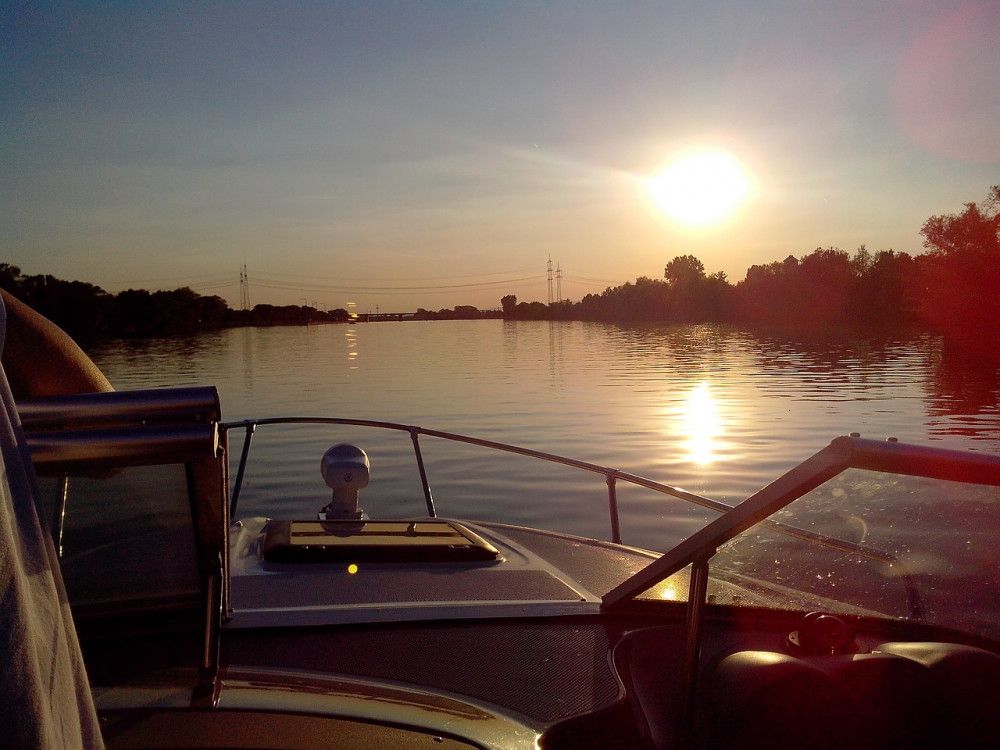

On this page:
How to pick the right motor size, other factors that are important for size, why is the right motor size important, is there a max hp for sailboats, in conclusion, related questions.
Sailboats need way smaller engines than powerboats. That's great news (unless your ultimate goal is speed), because it's cheaper to buy, cheaper to drive, and cheaper to maintain.
The amount of power you need is related to the hull displacement of your boat.
I like to use the simple formula:
HP = displacement (lb) / 550
So 1 HP for every 550 lb displacement, and 4 hp per 2200 lb.
Here, HP is the amount of horsepower you need to reach the maximum hull speed. This is in optimal conditions. So you have smooth water, no windage, a clean and polished hull, and so on.
If you want to get it absolutely right, you also need to correct for propellor size. And of course, a lot of other factors come into play (more on that later). But generally, these engine sizes will work with the following weights:
That sounds about right to me. But remember that these are all rough estimates: I just try to give you a ballpark figure. There is no one formula to get an exact number. The hull design, sailing conditions, and your personal preference are all very important.
If you're serious about getting a new engine, I definitely recommend to get advice from an expert . But you know, salespeople always recommend the Turbo version. Remember that you don't have to overpower a sailboat. Usually you don't need anything over 30 HP. So at least you now know what will work on average.
What is hull displacement?
- Hull displacement is the weight of the boat, or the amount of water the boat displaces.
- Maximum hull displacement is the weight of the boat when it's fully loaded, including crew.
The weight of the boat is the same as its displacement, because the weight of any object is exactly equal to the weight of the water it displaces (aka: pushes aside). This is called Archimedes Principle.
The weight slightly differs in saltwater from freshwater, because saltwater is heavier. In saltwater, the boat gets a bit lighter. So in theory you can use a smaller engine for a bluewater boat, but in practice this is offset by the stronger current and wind.
How to find the displacement of your boat?
Most manufacturers simply give you the displacement of your boat. If you can't find any data, because, for example, you own an old boat, you can weigh your boat on a truck scale. You can also haul it out and measure it (which is painstaking work).**
Tip: if you're gonna weigh your boat, simply drive it onto a truck scale, and retract the weight of the trailer from the total weight.
Of course, it's not so simple. This formula gives a rough estimate. But for me this was way clearer than all that black magic that I get when I ask people what size engine I should get.
Let's look at the things this formula doesn't take into account.
2-strokes are more powerful than 4-strokes. Two-stroke engines fire once every revolution and four-strokes fire once every other revolution. This makes the 2-stroke twice as powerful. They provide more torque at a higher RPM. But they also wear more quickly. The 4-stroke will last you a lot longer, and its also more fuel efficient.
The right propellor size is just as important as having enough horsepower. With a smaller prop diameter, it has to work harder to generate the same propulsion as a larger diameter. But you can't just go larger always. The prop affects the RPM of your engine, and you have to get in the right range (more on this later). You also have to check the maximum diameter that fits your boat.
Diesels have more torque, because the compression rate is higher than that of gasoline engines. So if you consider a diesel, you can do with less HPs.
High windage hulls (multihulls) need a bit more. A multihull (or larger hull in general) suffers from more friction because of the larger surface. So the engine needs to work a little harder.
If you sail longer distances under power , or against the wind it's a good idea to get a larger engine (but not too large). This helps you to save on fuel since you have lower RPM. Especially if you sail offshore or on open sea. The engine needs to work harder due to stronger wind and current.
If you're just sailing in and out of the marina under power, you may need less HP.
Smooth hull designs need less HPs than bulky hull designs, like the classic wooden clippers and crabbers for example.
It matters to get the right size outboard motor for a couple of reasons.
First of all: smaller engines are cheaper, so you save money on buying the engine.
Secondly: smaller engines use a lot less fuel, so you save money on using the engine.
Thirdly: smaller engines are cheaper to maintain: so you save money on maintenance.
So why not get the smallest engine and get the best fuel economy? There are a couple of advantages to getting a (slightly) bigger engine:
- More power means more control (easier to stop the boat, in case you need to)
- Finding the sweet spot might actually reduce fuel consumption
The sweet spot
To perform optimally, an engine should get up to speed. The problem with an overpowered boat is that the engine won't rev up to 80 - 90% of the RPM. This kills fuel efficiency and also the cooling system won't operate optimally.
- The optimal cruising RPM of the engine is about 85-95% of the maximal RPM
- You should reach cruising RPM at hull speed, so your engine should be at about 90% RPM
The propeller size is very important for the RPM. If your prop diameter is too wide, the engine can't get up to speed and struggles to build power. Bad for fuel economy, bad for the engine, and bad for performance.
On the other hand, if your prop is too small, you don't make use of the engine's full power.
If you struggle to get to high RPM, your prop is too large. If your engine is constantly in the red, you're underpropped.
So don't go too big on the prop, but also don't go too small. The easiest way to get it right is to check the engines manual and see what the manufacturer recommends.
You can definitely go too big on a sailboats engine. An overpowered yacht doesn't make any sense. True, it can look cool, but it can't feel cool. Every displacement hull has a maximum hull speed. That means that it cannot go any faster than the max speed. So if your engine can cruise at that speed, it's not getting any better.
The problem with displacement hulls is that they displace the water, or in other words: they push the water in front of them. They cannot move any faster than they can push away the water. And because the resistance increases as speed increases, there's an absolute, physical speed limit for each keelboat.
That's why powerboats have to get out of the water to reach top speed.
Fun fact: the longer your boat, the higher the hull speed. Want to know the maximum hull speed for your boat? You can find it in this article .
So, you can't go faster than your maximum hull speed, so a 50+HP engine is kind of ridiculous. Bear in mind that a large engine also has the following disadvantages:
First of all: larger engines are more expensive, so you spend more money when buying the engine.
Secondly: larger engines use a lot more fuel, so you spend more money when using the engine.
Thirdly: larger engines are more expensive to maintain: so you spend more money on maintenance.
Also, if your engine is too big, it doesn't reach the optimal cruising RPM, so your fuel economy also gets really bad FAST.
I suggest getting the smallest possible engine that gets you to maximum hull speed while it's at roughly 90% of the RPM. As long as it gives you enough control and good handling, it will get you there. If you give up on going fast, you can actually get really good fuel economy and your engine will last you probably 20 years.
If you want to go fast, a sailboat is not the right one for you. You should instead get a powerboat.
I'm just kidding. Read my 13 Reasons Why Sailing is Better Than Powerboating here .
Do sailboats have motors? Most sailboats are power assisted boats, which means they have a small auxiliary engine to cruise in light air. When a sailboat is sailing under engine power, it is considered a motorboat and it doesn't have right of way.
Thanks for answering my questions.
Taylor Bishop
Thanks for explaining how you can figure out what size you need for an outboard motor. You mentioned that you should find the displacement by weigh a boat on a truck scale. I’m interesting to learn if you need to regularly weigh it in case the hull displacement could change or if it will always be consistent.
Shawn Buckles
Hi MitI, you’re welcome, my pleasure.
Hi Taylor, my pleasure.
You don’t need to weigh your boat regularly, as the hull displacement will stay consistent. You could literally see the hull displacement as the amount of space your hull takes up in the water. So as long as you don’t make any major changes to the hull shape or ballast of your boat, you should see no differences in displacement.
Roger S Johnson
How do you measure for shaft size, most outboard motors are for flat bottom and say measure to the bottom of the boat, most sailboats tapper to the aft. Where do you measure for a tapered bottom sail boat?
Will a 5 horse Honda 4 stroke be ok for a 25 foot Pearson Commander sail boat. Thanks for your time Luke
I think it would be Luke.
Great post, thanks for the info. A naive question from a soon-to-be sailor: I’m considering buying a 28 ft sailboat, with 2500 kg (ca. 5500 lbs) displacement. The engine is in pretty good condition, but is old and the original one (from 1977!), so I am also thinking of an alternative scenario in which it fails. I know that in my area replacing an inboard engine will cost double the price I’m putting down for the boat, and since I’m on a budget, that simply won’t be an option and outboards seem to be cheaper. So the question is: is it possible to put an outboard engine on all boats? Is there some factor that would make it impossible to mount an outboard engine on the boat? Thanks!
Garth Powelson
What is minimum length that a sailboat can go without an outboard. Does a 29’ “require by law” to have engine?
Hello Mr. Buckles, Thanks for the informative article. I’m looking to get the smallest possible outboard for my 1.5 ton displacement fiberglass monohull Hood 23’ sloop. Can I get away with a 4HP?!? What size prop would I need?!? (I’m only going to use it when there is NO wind, and, if I can stay 4HP or below, I am not required to register my vessel—which is pretty cool, so here’s hoping!)
Thanks again, Ship
Hi, I’ve got a older Pearson 39’ . I’m looking to remove the old 40 ho westerbeke and go electric. Unsure of what hp is going to be needed?
emilio h javier
i am purchasing a catalina 22 ft. i have in mind a 4 HP motor. what would be the length of the shaft.
I am considering buying a 25 ft sailboat with a 7200 lb displacement. The boats top speed is listed at 7knots per hour but the diesel motor does not work. The owner has a 9.9hp outboard that can be purchased with the boat. Is 9.9hp enough to power the boat to at least 5 to 6 knots per hour? Thanks. Rick
What weight outboard would be too much for a 20’ Santana, displacement 1,350 lbs? I don’t want too much weight at the back. I want the boat to be seaworthy.
I have not seen this amount of BS in years :) I’m not a marine engineer, yet physicist & avation engineer. You even can’t tell the difference between mass of the vessel and diplacement :D Fcking genius.
Leave a comment
You may also like, what’s the life expectancy of a marine diesel engine.
Being a fan of the waters, I found the life expectancy of marine diesel engines an interesting topic to deeply research. I went on and on and I couldn’t stop …

How Much Fuel Does a Sailboat Use?
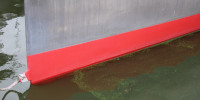
How Often Should You Antifoul a Boat?

3 Ways to Convert Your Winches to Self-Tailing
Own your first boat within a year on any budget.
A sailboat doesn't have to be expensive if you know what you're doing. If you want to learn how to make your sailing dream reality within a year, leave your email and I'll send you free updates . I don't like spam - I will only send helpful content.
Ready to Own Your First Boat?
Just tell us the best email address to send your tips to:
- AROUND THE SAILING WORLD
- BOAT OF THE YEAR
- Email Newsletters
- Best Marine Electronics & Technology
- America’s Cup
- St. Petersburg
- Caribbean Championship
- Boating Safety

Lightweight and Small Outboard Motors for Sailboats
- By Ed Sherman
- Updated: April 22, 2019
When you’re facing strong winds and you need to get somewhere fast, it’s time to break out a small outboard such as an aluminum genny. A dependable outboard that has enough horsepower to get you to the racecourse and back, yet is light enough not to be a drag on your race results, is invaluable. Most racing sailors don’t need as much horsepower as they might think.
An eight-horsepower outboard, for example, will push a 30-foot, 6,000-pound boat along at 6.5 knots. Anything bigger will weigh more than 90 pounds and isn’t suitable for lifting on and off the stern. Here’s our roundup of some of the best outboard motors for sailboats, and some help in deciphering what’s right for your boat.
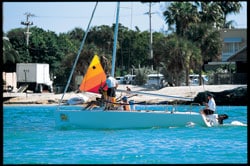
We focus our attention on engines available under nine different brand names. Two of the best-known names, Johnson and Evinrude, have dropped out of the small-engine end of the market as part of parent company Bombardier Corporation’s restructuring of these two companies. Currently they’re advertising the availability of six- and eight-horsepower four-stroke models in 2003. Another dropout in the mini-engine market is Suzuki. Their smallest two-stroke is a five-horsepower unit and in the four-stroke configuration, a 9.9 horsepower. Brand and corporate shuffling aside, of particular interest is whether the companies that are building nine horsepower- and-below engines have incorporated four-stroke technology into the lower horsepower range, since it’s now beginning to dominate the mid-sized and larger outboard engine market. The answer to that is yes, to a point.
Two or Four Stroke Outboards for Sailboats
Outboards are either two or four-stroke engines, and the four-strokes have definitely gained favor in recent years for several reasons: they’re quiet, they use much less fuel, and they run more cleanly. Since no oil is mixed with the fuel, the classic two-cycle smokescreen isn’t a factor. In a four-stroke, the piston reciprocates inside the cylinder four times for each power stroke (that is, each time fuel combusts). Rather than opening ports cut into the sides of the cylinder, intake and exhaust valves controlled by a camshaft allow a fuel/air mix to enter the combustion chamber with the suction created by the piston as it moves inward in its cylinder. Exhaust gases are forced out of the cylinder as the piston moves outward.
By carefully designing the camshaft, engineers minimize the amount of time that the intake and exhaust valves are both open, considerably reducing the amount of unburned fuel that exits with the exhaust stream. The end result? Fewer emissions and greater economy.
But they do have at least one distinct disadvantage for the racing sailor, and that’s weight. For example, four-stroke engines in the five-horsepower category are about 20 percent heavier than comparable two-stroke engines of the same horsepower. The good news, however, is that only amounts to between 10 and 15 pounds, depending upon the engine. Four-stroke engines cost more, also, but the improved technology may be well worth it.
If you’re totally weight and price conscious, you’ll want a two-stroke engine. But, if you think you can lose the weight elsewhere, a clean, quiet four-stroke without the hassle of mixing fuel could be the answer. In fact, Mercury/ Mariner’s newest six-horse four-stroke engines are actually 18 pounds lighter than their older two-stroke equivalents–a testament to the benefits of improved design and technology.
Environmental regulations are pushing manufacturers towards four-strokes as well. Four-strokes meet emission control standards, and US Environmental Protection Agency regulations mandate that new outboard and personal watercraft engines reduce engine hydrocarbon emissions by 75 percent by 2006. Environmentally conscious sailors should look for either a C.A.R.B. (California Air Resources Board) “very-low” or “ultra-low” designator, or a specification indicating 2006 EPA compliance.
How Much Horsepower Do You Need?
The amount of power you’ll need depends on several key factors. The first consideration is the weight of your boat. The second is the boat’s wetted surface. Full-keel boats not only weigh more but also have more surface area to push through the water. My rule of thumb here is to start with a two-horsepower engine for small centerboard and keelboats less than 1,000 pounds, and add one horsepower for every 1,000 pounds of displacement. For more exact, albeit complex formulae, I suggest The Propeller Handbook by Dave Gerr (McGraw-Hill 2001).
Compare your boat’s dimensions against what existing classes have found to work; for example, a Melges 24 at 1,650 pounds is typically rigged with a three-horsepower short-shaft engine, while a J/80 at 2,900 pounds can still squeak by with a long-shaft, three-horsepower engine. A 1,790 pound J/22, on the other hand, typically uses a four-horsepower long-shaft engine. On the larger end of boats using outboards, you’ll find the outboard version of the J/29, at 6,000 pounds, requires a 7.5-horsepower long-shaft engine.
If you are intending to do some cruising, or even long deliveries to regattas, an option that’s available on some engines is a high-thrust propeller. On larger boats, this option can save weight over a bigger engine and really make a difference when trying to punch through a strong tide or headwind. High-thrust props cost more and are less fuel efficient–but they can save weight and give you more power.
Once you’ve determined how big an engine you’ll need, the next step is to begin comparing features in the given horsepower range you’ve selected. There are nine manufacturers included in our roundup, but some of their brands are identical products with different labeling. In the smaller sizes, the Mercury and Mariner brands are identical. As for the Nissan and Tohatsu engines, Tohatsu builds them all. Yamaha, Suzuki, and Honda all offer competitive products as well, but they’re all independent brands.
What to Look For in Lightweight Outboard Motors
In the small engine sizes, specific features to look for can be reduced to several key items. For some, having an integral fuel tank will be important. The smallest engines have integral tanks that hold only a quart or two of fuel–good enough for an hour or two of operation. No manufacturer lists fuel consumption because the size boat the engine is pushing and the wind and wave conditions vary widely. Compare the size of the tanks, and whether you can attach a remote tank for longer trips. The extra weight and space of a separate fuel tank will be a burden on smaller ultra-light boats.
The availability of long- and short-shaft versions in the horsepower size you need is also important. Honda for example offers 20 and 25-inch transom height (long or short shaft) right down to their smallest BF2 (two-horsepower) model. Mercury and Mariner only offer a 15-inch short-shaft version on their 3.3- and 2.5-horsepower engines. Shaft length is measured from the top of the bracket to the tip of the shaft–make sure your shaft is long enough to position the propeller and cooling water intake deep enough below the waterline to avoid cavitation when the boat pitches through waves.
Other specifications that are worth comparing are whether the engine is equipped with a simple forward and neutral gearshift or if the unit has a full functioning forward-neutral-reverse gear unit. If you’re going to be doing long deliveries to regattas, or in the larger sizes for a racer/cruiser configuration, consider whether or not a charging system is part of the engine package, and if so, it’s output. Will it be adequate to keep your battery recharged and power things like a tiller pilot and running lights? Also, on the larger engines check to see if electric starting is available, or offered as a standard feature. Having it can be the difference between pain and pleasure.
If you are racing in a strict one-design group, check any class rules that apply to outboard engines. Issues related to brackets, storage of the engine and/or alternative weight might be issues, so be sure to check with your class before making any final decision.
Ed Sherman is the author of Outboard Engines, Maintenance, Troubleshooting and Repair, International Marine/McGraw Hill and a contributing editor to Sailing World.
- More: Accessories , clothing , Sailing Gear
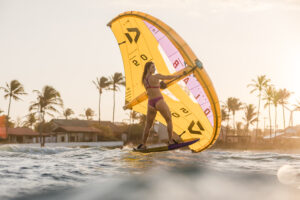
Wingfoiling Gear: A Beginner’s Guide
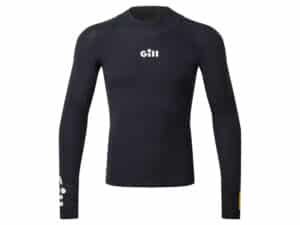
Suiting Up with Gill’s ZenTherm 2.0
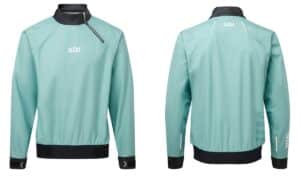
Gill Verso Lite Smock Keeps it Simple
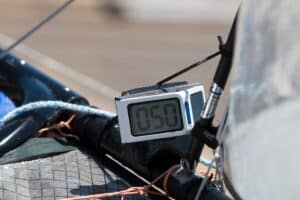
A Better Electronic Compass

Brauer Sails into Hearts, Minds and History

Anticipation and Temptation

America’s Offshore Couple

Jobson All-Star Juniors 2024: The Fast Generation

- Digital Edition
- Customer Service
- Privacy Policy
- Cruising World
- Sailing World
- Salt Water Sportsman
- Sport Fishing
- Wakeboarding

4 Best Electric Outboard Motors

Last Updated by
Daniel Wade
June 15, 2022
Taking a small dinghy with an electric outboard motor on your sailboat can provide a means of quick and reliable transportation.
While electric outboard motors can have difficulty moving full-size sailboats around, they are more than powerful enough to get a small dinghy going fast. While trolling motors are only good for slow speeds, an electric outboard motor can get a boat going fast as long as the boat is small enough.
Electric outboard motors can be a better choice than gas motors. As well as being powerful enough, they are lighter, more compact, and more reliable. You can count on motors from ePropulsion and Torquedo to last for a while.
If your sailboat is large enough, you should always take a dinghy with you. As well as being a potential lifesaver in an emergency, a dinghy is useful any time you need to drop anchor and make it to shore. A dinghy with a motor is cheap compared to a sailboat, so a sailor should always have a dinghy with them.
Table of contents
How fast can you go with an electric outboard motor?
If you are running a powerful motor on a small boat at full speed, you might be able to do 15 knots or better. Usually, you won't go that fast when you are in a dinghy and running an electric motor.
If you want to make it as far as possible, you will run the motor on much less than full power. Fifteen knots is what you might get if you are running a powerful 6000 watt motor on a small boat. Normal speeds are slower - you might move at less than five knots if you want to travel as many miles as possible before the battery dies.
How far can you make it in a dinghy with an electric motor?
Something like 20 miles is a rough, ballpark figure, although with some motors, you might be able to make it 70 miles at a slow speed. Don't take any risks when it comes to whether or not your battery will run out in the middle of the sea. Be on the safe side.
You will do much better if you run your motor at a slower speed. If you run your motor as fast as possible, you might make it only a fraction of the maximum distance before your battery runs out. Distances high above 20 miles are sometimes possible if you go slow, although it depends on the boat and the motor.
How is power measured for electric motors?
The power of an electric motor is usually measured in watts, not horsepower. Sometimes the power of an electric motor is given in horsepower, but usually in watts.
Boat motors vary greatly in how powerful they are. A motor that is only 10hp, 5hp, or 3hp is common even though outboard motors can be 20hp or more.
Usually, you can go more like 5 knots than 15 knots with an electric or gas motor. To go 15 knots, you might need something like a 100hp motor - this is too expensive and not what people are likely to put on a small dinghy.
What are the advantages of gas motors?
In the long run, electric motors can save you money because it costs less to keep them running. After the first few years, electric motors are the cheaper choice.
The maintenance cost per hour of use is much higher for petrol motors. After only a few hundred hours of use, a petrol motor's cost will exceed the cost of an electric motor.
One disadvantage of electric motors is that they run on batteries, which take time to charge. You will have to charge your batteries overnight, compared to quickly refueling a gas engine.
One way out of this problem is to use a solar charger. With a solar charger, you can charge your batteries anywhere as long as the sun is out.
Electric outboard motor advantages
As well as being effectively cheaper than gas motors, electric motors are much quieter. Compared to a gas engine, an electric motor is almost silent. You will hear almost nothing and will not scare fish away.
Electric motors are also much cleaner to deal with than gas motors. If you use an electric motor, you won't have to deal with engine grease. You can get engine grease on your boat and not just on your hands and clothes with a gas motor.
Gas motors also have exhaust fumes, so an electric motor is better for your health. Electric motors are also simpler than gas motors, so you won't have to repair them as often.
Is it possible to buy high powered electric outboard motors?
Yes, you can find an electric motor with a power equivalent to an 80 horsepower gas engine. Not many people put such powerful motors on their dinghies, though. Dinghies mostly have weaker motors, often less than five horsepower.
Is it easy to break a propeller if you hit something?
You can definitely do expensive damage to a propeller if it hits a rock. A small bump won't damage it - most propellers are made well and are reasonably durable. If your motor does not come with a propeller guard, you should buy one separately.
Are 3hp motors good enough for many boats, or are they too weak for most purposes?
If you are using a small dinghy that weighs less than two tons, and do not intend to go very fast, a 3hp motor is good enough. You can go much faster than trolling speed with only a 3hp motor if your craft is small enough. For a small sailboat that weighs more like six tons than one or two tons, a 10hp motor may be enough.
Best electric outboard motors
Make sure you buy a high-quality motor because these are not tiny investments. You can lose more than a little money if you buy a shoddy product that does not have a good warranty. Put a bit of time into verifying the reliability of whatever you purchase.
1) ePropulsion Spirit 1.0 Plus
If you are fine with a fairly weak 3HP motor, the Spirit 1.0 Plus is a great product with few disadvantages. The Spirit 1.0 Plus from ePropulsion is built to last, uses power efficiently, and doesn't cost a fortune.
At full speed, the Spirit will only last for about 90 minutes on a single battery. With a 12 foot boat, you can go about 9 km/h - not bad for a relatively low power engine. You also do not need to run the boat on full power to approach your boat's maximum speed.
If you run the Spirit on 1/4 power, you can keep it going for 6 or 8 hours. Batteries are fairly heavy, but you can keep the motor running for a long time if you bring extra batteries. The motor can save you in a dangerous situation and is great for non-emergency uses as well.
Another advantage of the Spirit is that the battery floats, so it won't sink if you drop it in the water. The Spirit is also light, even with the powerful battery it comes with. The digital display that shows how much battery power you have left is accurate.
Like other electric boat motors, the Spirit is more environmentally friendly and healthier than a gas engine. Gas engines have fuel leakage and fumes; an electric motor avoids these problems. The Spirit even comes with a 180W solar panel to charge it, although this is not the only or the fastest way of charging the battery.
The motor even has a remote control, so you can steer it and adjust the speed with a console. If the Spirit has a disadvantage, it is that the range on a single battery is unimpressive. You can make it a little more than 20 miles, but many other electric motors let you go farther on a single battery.
2) ePropulsion Navy 6.0
If you are looking for something longer lasting than and more powerful than the Spirit 1.0 Plus, ePropulsion also offers the more powerful Navy 6.0 . The Navy 6.0 is equivalent to a 10Hp engine, so it won't struggle to move a relatively big boat.
The range on the Navy 6.0 is impressive. The battery is powerful enough that you can travel 40 miles before having to recharge. If you want to bring more than one battery, the Navy 6.0 can be compatible with other companies' batteries.
The Navy 6.0 also has a propeller that will stop immediately if it hits anything. This can save your engine from damage if the propeller hits a rock or anything else. There is also an emergency stop kill switch to
The Navy 6.0 works just as well in freshwater as in saltwater. It is advantageous to have an electric motor on a lake because there are laws against gas motors in some lakes.
3) Torquedo Travel 1003
One thing that makes the Torquedo Travel stand out is its onboard GPS computer, which can calculate how far you can travel before the battery runs out. The computer will continuously update how far you can travel based on how much battery power is left, how fast you are going, and how much power you are using.
While the Torquedo Travel can run for 10 or 11 hours on a full charge, it can only move a small boat at 1.5 or 2 knots for that long. If you run the engine at half throttle, it will last for 3.5 hours at 3 knots. If you travel faster, the battery runs out very fast - it will only last half an hour at 5 knots.
If you want a solar charger for the motor, you can buy it separately from the company. It is costly, but the solar panels do work well and give you a way to charge the battery at sea.
The Torquedo Travel is also a small and light motor that does not take up much room. Without the battery, it weighs only 8.9 kilograms. You can easily remove and store the engine.
Another useful feature is the kill switch that allows you to stop the motor immediately in an emergency. You can also use the engine/battery as a power source for electronics through a USB.
The Torquedo is a reliable engine backed by a two-year warranty. It is equivalent only to a 3HP engine, so it is not powerful enough for everyone.
4) Torquedo Cruise 4.0 T
The Torquedo Cruise is the best choice if you want a more powerful alternative to the Torquedo Travel. The Torquedo Cruise electric outboard motor is equivalent to an 8HP gas engine. If you need a motor for a boat that weighs three or four tons instead of one or two tons, get the Cruise instead of the Travel.
The Torquedo Cruise will stay completely waterproof for a long time and not develop small leaks quickly. Small leaks can ruin some of the cheaper engines on the market. The Torquedo Cruise is also very corrosion resistant, so you can use it in saltwater for a long time without damage.
The Torquedo Cruise has the same onboard GPS computer, emergency off switch, and two-year warranty as the Torquedo Travel does. The only disadvantage compared to the Torquedo Travel is the higher price. Not everyone needs a more powerful motor, but it is an excellent engine if you do.
Related Articles
I've personally had thousands of questions about sailing and sailboats over the years. As I learn and experience sailing, and the community, I share the answers that work and make sense to me, here on Life of Sailing.
by this author
Sailboat Upgrades
Most Recent

What Does "Sailing By The Lee" Mean?
October 3, 2023

The Best Sailing Schools And Programs: Reviews & Ratings
September 26, 2023
Important Legal Info
Lifeofsailing.com is a participant in the Amazon Services LLC Associates Program, an affiliate advertising program designed to provide a means for sites to earn advertising fees by advertising and linking to Amazon. This site also participates in other affiliate programs and is compensated for referring traffic and business to these companies.
Similar Posts

How To Choose The Right Sailing Instructor
August 16, 2023

Cost To Sail Around The World
May 16, 2023

Best Trolling Motors For Pontoon Boats
Jacob Collier
February 1, 2023
Popular Posts

Best Liveaboard Catamaran Sailboats
December 28, 2023

Can a Novice Sail Around the World?
Elizabeth O'Malley

How Long Did It Take The Vikings To Sail To England?

10 Best Sailboat Brands (And Why)
December 20, 2023

7 Best Places To Liveaboard A Sailboat

9 Best Trailerable Sailboats
Get the best sailing content.
Top Rated Posts
Lifeofsailing.com is a participant in the Amazon Services LLC Associates Program, an affiliate advertising program designed to provide a means for sites to earn advertising fees by advertising and linking to Amazon. This site also participates in other affiliate programs and is compensated for referring traffic and business to these companies. (866) 342-SAIL
© 2024 Life of Sailing Email: [email protected] Address: 11816 Inwood Rd #3024 Dallas, TX 75244 Disclaimer Privacy Policy
Yachting Monthly
- Digital edition

Electric outboard motor: we test 13 options
- Theo Stocker
- July 25, 2023
An electric outboard motor is now a viable option for dinghy propulsion. Emrhys Barrell puts the latest outboards and trolling motors to the test
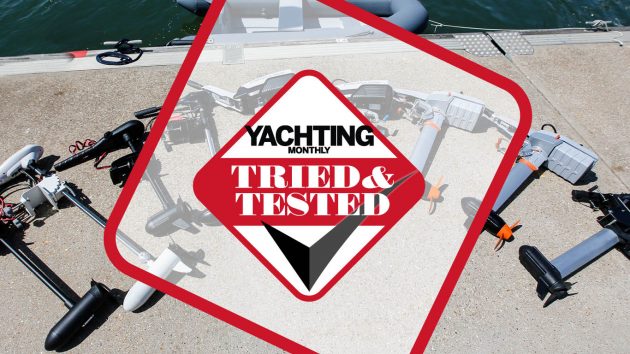
The electric outboard motor has been around for many years, but they have either been too low powered or their lead acid batteries have made them too heavy to lift in and out of a small tender, so petrol outboards have remained the engine of choice.
The development of lightweight lithium batteries has changed all this, making an electric outboard motor a practical alternative to petrol – and making all electric yachts a real possibility too.
With this in mind, we tested 12 models whose all-up weight, or the weight of their individual components, did not exceed the 14-17kg of a 2.5hp petrol outboard.
See how we tested the electric outboards at the end of this article.
Best electric outboard motor

Specifications Outboard weight: 12kg Overall weight with outboard and bracket: 14.5kg Battery capacity: 1085Wh Top speed: 5kts Thrust: 30kg / 66lbs
Designed along the lines of a dinghy rudder, this Remigo outboard is incredibly easy and intuitive to use. No external cables or anything to be snagged, it clips onto a bracket pre-mounted to your tender or dinghy, in a similar way that you’d attach a dinghy rudder.
Flip down the handle, attach the magnetic kill cord and you’re good to go.
On test this outboard gave as much thrust as the ePropulsion below but out performed it in terms of maneuverability. The Remigo can be switched from forward to reverse thrust at the touch of a button.
We like the Remigo for it’s sleek simplicity. If you want a clean smart easy to carry outboard to take you from your mooring to shore or quietly meander from your anchorage to shore then this is definitely worth considering.
We especially liked the rudder effect of this outboard giving us steerage even we had turn the power completely off to coast in alongside our pontoon.
Read Fox Morgan’s review of this outboard – Remigo One Electric Outboard review
Reasons to buy
very easy to stow, innovative rudder design, lightweight, built in battery, easy to mount and dismount
Reasons to avoid
No multiple battery swap options like more conventional electric outboards
Find a dealer at Silent Yachting

Photo: Paul Wyeth
ePropolsion Spirit 1.0 EVO
Yachting Monthly’s best buy
Specifications Motor weight: 10.5kg Battery weight: 9kg Battery capacity: 1276Wh Top speed RIB: 4.5mph Top speed skiff: 6.0mph Thrust: 31kg/68lbs
The Chinese firm ePropulsion has been developing its electric outboard motor range and lithium batteries for some time. We tested the Spirit 1.0 Plus and Evo, both 1kW motors with integral batteries.
Clearly ePropulsion was influenced by Torqeedo, but there are some important differences. From the outset ePropulsion went for a direct drive motor, being quieter and avoiding gearbox problems.
The battery has a greater capacity than the original Torqeedo, and is still 30% higher than the latest version. It also floats – useful if you should drop it overboard.
Fitting the battery is a two-handed job, with the carrying handle being at the back, and latch lock at the front, which requires leaning over the transom to install it. You also cannot see the locating slots underneath, which isn’t quite so easy in a bobbing inflatable. The power cable socket is protected by a rubber cap.
You have a display, but it only shows power being consumed, voltage, and remaining runtime, which means it has larger figures, easier to read on a sunny day, but it lacks GPS speed or range.
It has the same trim settings as the Torqeedo, with a similar fiddly retaining split ring. It also has a magnetic kill cord. Three shaft lengths are available, catering for transom heights up to 61cm. The shaft is streamlined but rotates through 360º for maximum manoeuvrability and reverse.
High battery capacity Quiet 360º rotation
Limited display options
Buy it now from epropulsion

Yachting Monthly’s best in class
Specifications Motor weight: 10.5kg Battery weight: 9kg Battery capacity: 1276Wh Top speed RIB: 4.5mph Top speed skiff: 6.0mph Thrust: 68lbs Regeneration: 4 knots – 40W / 10 knots – 300W
The 1.0 EVO has the same dimensions and performance as the Spirit, but it has the options of a removable tiller, plus remote controls and steering, but the real innovation is that it offers regenerative charging while you are sailing, putting 40W at 4 knots, and 300W at 10 knots back into the battery.
You can even have a wristband remote for steering and throttle.
The ePropulsion Spirit 1.0 EVO is undeniably more expensive than it’s little sister without the regenerative charging and the cost difference is significant. If you are likely to be doing a lot of sailing and using your electric motor from ship-to-shore in relatively remote locations then the regeneration will probably be worth it. For most, though the price differential is probably a little too steep.
Regenerative charging Removable tille Remote controls
Relatively expensive

Torqeedo 1103 and Torqeedo 603
Torqeedo 603 specifications Motor weight: 11kg Battery weight: 4.2kg (floats) Battery capacity: 500Wh Top speed RIB: 4.0 mph Top speed skiff: Not tested Thrust: 44lbs
Torqeedo 1103 specifications Motor weight: 11kg Battery weight: 6kg Battery capacity: 915Wh Top speed RIB: 4.4mph Top speed skiff: 6.0mph Thrust: 68lbs
Torqeedo was the first company to commercially produce an outboard with an integral lithium battery in 2005. The earliest motors used a high-revving geared motor, which produced a characteristic whine. Following the launch of its new larger battery, Torqeedo changed to direct drive at about the same time that ePropulsion arrived on the scene.
The 1103 is 1.1kW and has a removable battery and tiller/throttle. The battery locates in slots in the powerhead and can be dropped in one-handed, with the slots clearly visible from above, which is helpful in a rocking dinghy. It then hinges back and locks in place with a separate plastic pin. The tiller locates in similar slots.
The two are then connected to the motor by a power cable and a data cable, but the latter has an 8mm plug, with five tiny pins that have to be carefully lined up, then secured with a threaded plastic collar. Neither of the sockets have caps to prevent debris or water getting into them when the cables are not connected.
The display on the tiller shows four lines of data at the same time, which makes them small to read (a phone app can be used for a large display). They include volts, battery capacity, range at a given speed, speed in kts, mph or km/h, and power consumption in watts. A magnetic kill-cord cuts the power circuits if you fall overboard.
The motor has four trim positions to allow for angled transoms, but the split ring securing the locking pin is very stiff and fiddly, especially when you have to adjust it hanging over the transom. A side-mounted lever allows the motor to be tilted horizontally. In normal use a catch prevents the motor kicking up in reverse, but this can be released with another side-mounted lever if you are in shallow water.
Long and short shaft versions are available, with the height of the transom to the top of the prop on the long shaft being 62cm. Clamps screws and fittings are stainless steel, making it suitable for salt water use, but an anode is an extra. It has forward and reverse but not 360º rotation.
Established brand with relatively long history Removable battery and tiller Lots of display options
Display hard to read
Buy the Torqeedo 603 now from Torqeedo Buy the Torqeedo 1103 now from Torqeedo
Best Trolling motors
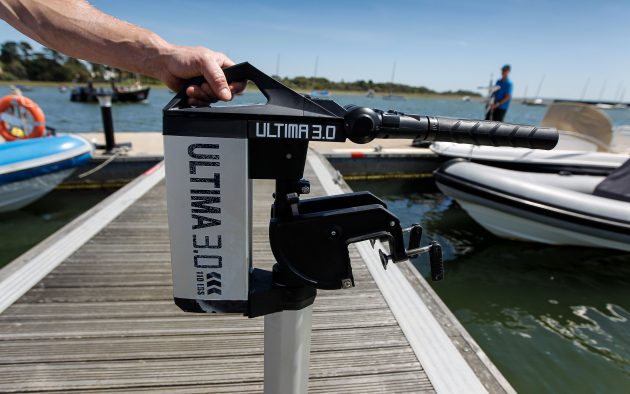
Haswing Ultima 3
Specifications Motor weight: 11kg Battery weight: 5kg Battery capacity: 600Wh Top speed: RIB 4.0mph Top speed skiff: Not tested Thrust: 51lbs
Haswing is a new name to us, but this Chinese manufacturer now has an extensive range of motors, several of which we were able to bring along to our test.
The Ultima 3 has an integral Lithium battery and an output of 1,000W, with the ‘3’ in its name indicating the 3hp petrol outboard its makers claim it is equivalent to. The battery is 600Wh.
The battery was the easiest of all in our test to fit and remove, just sliding down a set of grooves, with contacts in the bottom removing the need for any linking cables or wires, and an easy one-handed operation.
The unit is well engineered, with stainless steel used throughout plus an anode as standard, making this suitable for use in salt water, and a spare anode and shear pin. The tiller/throttle hinges up and down for easy operation and storage. It has a streamlined aluminium leg, but rotates 360º.
A magnetic kill cord is a useful safety feature, and there are 5 LEDs showing battery capacity remaining, but this is the only instrumentation, so there is no way of gauging how much power you are using. It also meant that with no exposed power cables, we could not measure intermediate power settings.
Easy to fit battery Anode as standard for salt water usage High end materials
Limited instrumentation
Buy it now from Amazon

Motorguide Varimax 40
Specifications Motor weight: 9.1kg Battery (Sterling 60Ah) – 8kg Battery capacity: 780Wh Top speed RIB: 3.2mph Top speed skiff: 4.0mph Thrust: 28lbs
Another trolling motor, this has a claimed 40lb thrust and a variable speed electronic control. The throttle pulls forward for ahead, and pushes back for reverse then twists in the same direction for speed. A clever feature once you get used to it. Ten LEDs show the battery state.
The sliding shaft gives transom heights up to 65cm transom to prop, and 360º rotation. It also quickly tilts through 90º, with 5 positions, for shallow or weedy water.
Clamp screws and fittings are mild steel, meaning you should wash it off with freshwater after using it in the sea.
Clever throttle control Variable transom heights accomodated
Quite basic in functionality

Haswing Osapian 55
Yachting Monthly’s best budget buy
Specifications Motor weight: 9kg Battery weight: (Sterling 60Ah) 8kg Battery capacity: 780Wh Top speed RIB: 3.3mph Top speed skiff: 4.4mph Thrust: 35lbs
This is another trolling motor with a claimed 55lb thrust, but with five forward speeds and three reverse on a twist-grip throttle. Again, it is a well-engineered motor, with all fittings and clamp screws made of stainless steel, an anode behind the prop and a spare in the box.
Five LEDs show the battery state. The sliding shaft gives transom heights up to 62cm, and 10 tilt positions.
As with all click-speed throttles you have double the power at Setting 5 compared to Setting 4, and very poor range figures at intermediate speeds compared to motors with electronic throttles.
However it is an excellent value-for- money option for sailors looking for ways to power their tender for short trip
Well engineered Value for money
Poor range at medium speeds

Motorguide SW82
Specifications Motor weight: 13kg Battery weight: 16kg Battery capacity: 1,560Wh Top speed RIB: 4.0mph Top speed skiff: 5.5mph
Motorguide is a well-established US company that is part of the Mercury/Mariner group. The most powerful of the transom mount range, the 82 has a claimed thrust of 82lbs, and is a 24V unit requiring two 12V batteries in series.
It is also designed for saltwater use, with stainless steel clamp screws and fittings, and a large anode on the shaft. It has an extra long shaft, giving up to 93cm transom height to the prop, 360º rotation, and seven tilt positions There are no battery LEDs. An on/off switch under the control head is the nearest it gets to a kill switch.
Well known company Powerful Anode for salt water
No battery LEDs

Haswing Protruar 1
Specifications Motor weight: 9kg Battery weight: 8kg Battery capacity: 780Wh Top speed RIB: 3.4mph Top speed skiff: 4.5mph Thrust: 40lbs
Another Haswing requiring a separate 12V battery, this has a variable speed electronic throttle, and similar features to the Protruar 5, except no kill cord. It claims to be equivalent to a 1hp petrol motor, but in practice delivered 600W.
The sliding shaft only allows transom heights up to 40cm, but a longer shaft version is available. It has 10 tilt positions and 360º rotation.
Another well engineered unit, with stainless steel used throughout plus an anode as standard, and a spare anode and shear pin. The tiller/throttle hinges up and down for easy operation and storage.
Anode for salt water use 360º rotation
No kill chord Limited transom height range
Haswing Protruar 5
Specifications Motor weight: 14kg Battery weight: 16kg Battery capacity: 1,560Wh Top speed RIB: Not tested Top speed skiff: 6.1mph Thrust: 108lbs
Another Haswing, the Protruar 5 is the most powerful model we tested. The unit is extremely well engineered, with stainless steel used throughout for the clamp screws and fittings, plus an anode as standard, making this suitable for use in salt water. A nice touch is the spare anode and shear pin in the kit. The tiller/throttle hinges up and down for easy operation and storage.
Its 5 designation indicates its makers think it is equivalent to a 5hp petrol motor, but in reality it delivers around 2.5kW at 24V so requires two separate batteries. It has a variable electronic throttle, three battery state LEDS and a magnetic kill cord.
The shaft slides up and down, giving a maximum transom height of 62cm and 360º rotation. Ten tilt positions are quickly engaged by a squeeze lever.
The thrust was the highest of the test, making it suitable for heavy boats, but the fine pitch prop significantly reduced its efficiency at speed.
Powerful model Anode for salt water use Battery LEDs and kill chord
Needs two batteries for full power

Motorguide R3 45
Specifications Motor weight: 9.5kg Battery weight: (Sterling 60Ah) 8kg Battery capacity: 780Wh Top speed RIB: not tested Top speed skiff: 4.1mph
This trolling motor has a claimed thrust of 45lbs and five forward speeds. The sliding shaft gives transom heights up to 65cm and 360º rotation, with seven tilt positions. Clamp screws and fittings are mild steel, so should be washed after saltwater use.
The click-speed throttle gives non-linear power gaps, with Speed Setting 5 being double the power of Setting 4. This throttle arrangement results in poor range figures at medium speeds compared to motors with electronic throttles, but it keeps the price down.
360º rotation Plenty of transom height range
Minn Kota Endura Max 55
Specifications Motor weight: 9.5kg Battery weight: (Sterling 60Ah) 8kg Battery capacity: 780Wh Top speed skiff: 4.6mph
Minn Kota is one of the oldest makers of trolling motors. The Max 55 has a claimed 55lb thrust, with a variable speed electronic twist-grip throttle.
Clamp screws and fittings are mild steel, making it best suited for freshwater, though you can use it in the sea if you wash it off afterwards.
It has a fine pitch prop like all trolling motors, which gives a good static thrust, but efficiency, and hence range, falls off at higher speeds, though the electronic Maximiser throttle helps to offset this.
Electronic maximiser throttle helps offset range issues
Big range drop off at high speeds Needs washing after salt water usage
Buy it now from MinnKota
How we tested the electric outboard motors
We took a selection of electric outboard motor units available on the market, and tested them in two situations, firstly on a Frib 275 folding RIB on the Lymington River to reproduce the situation of getting out to your boat in the tender. We then put them on a 4m skiff on the Thames, to see how they perform at higher speeds on a boat with a smoother underwater form and longer waterline on sheltered waters.
Speed: We measured speed using a handheld GPS, and electricity consumed using a clamp ammeter or the motor’s inbuilt power display. We converted these to the range you would achieve, either for a given power, or the full power of the motor’s battery.
Thrust: We measured static thrust using a spring balance. This is a somewhat crude test, as it measures the pulling power of a motor in a static boat, and therefore doesn’t allow the propeller pitch to work at its designed speed.
Function: We checked the stated weights of each of the motors and made a qualitative survey of their main features when used as a dinghy outboard.
We tested the trolling motors with a 60Ah lithium battery from Sterling Power, which cost £360, though you can use a heavier lead acid battery costing around £120 for a good quality AGM or gel. Don’t bother with leisure batteries, which will fail after 4 to 5 trips. You will need a good quality Lithium charger, which will add on £100 or more.
We haven’t included charging in this test, as this is dependent on the charger you are using, whether you are charging from 240V or 12V on board, and whether the power source is mains, a generator, alternator or solar. It’s worth noting that you will rarely be recharging from flat, and will rather be aiming to top up batteries after each use.
Trolling motor or electric outboard motor?
The options today are trolling motors with separate batteries – so called because they were mainly used as auxiliary slow-speed power for anglers, and integral-battery motors built for dinghy propulsion. These are the options a sailor will be looking at when thinking about changing to an electric outboard.
Trolling motors are still popular for low-speed applications, as they are simple and cheap, but they do need a separate 12V battery.
The integral battery motors are sophisticated units designed to give you more speed and greater range for a given power in a small boat, though for any 3-4m boat, the hull speed will limit how fast you can realistically go with any motor unless you start planing.
An electric outboard motor with an integral battery will often include displays showing speed, range at a given speed, and percentage of battery capacity remaining, but these features come with a higher price tag.
The trolling motors and integral battery models in our test were similar in weight and both come in at around the same total weight as a 2.5hp petrol engine.
Enjoyed reading this?
A subscription to Yachting Monthly magazine costs around 40% less than the cover price .
Print and digital editions are available through Magazines Direct – where you can also find the latest deals .
YM is packed with information to help you get the most from your time on the water.
- Take your seamanship to the next level with tips, advice and skills from our experts
- Impartial in-depth reviews of the latest yachts and equipment
- Cruising guides to help you reach those dream destinations
Follow us on Facebook , Twitter and Instagram.
- Spirit 1.0 Plus
- Spirit 1.0 Evo
- Pod Drive Evo
- E-Series Battery
- G102-100 Battery
- Find a Dealer
- Have a Dealer Contact Me
- Product Registration
- Support Center: FAQ & Guide
- Video Tutorial
- Download Center
- Performance Bulletins

Electric Sailboat Motor: Range, Cost, Best Kits for Conversion
Today, owning a completely green sailboat has been made possible with electric sailboat motors.
Imagine cruising with the silence of an electric sailboat motor and the ease of use with a simple press on the start button. What’s better is there are no exhaust fumes at all with significantly less maintenance.
It’s so appealing that a lot of sailing liveaboards have made their electric sailboat motor conversion.
However, some sailors are still on the fence, worrying about the range and price of the electric sailboat motor.
If you are one of them, you are in the right place!
This post will guide you through every aspect you need to know about electric sailboat motors to help you make an informed decision.
Besides, you will get professional insights on how to make the electric sailboat motor conversion for your own boat and learn the best electric sailboat motors (with honest reviews).
Table of contents:
- Electric Sailboat Motors: Confusion Explained
Electric Sailboat Motor or Combustion Motor
- Electric Yacht Motor Conversion: Two Solutions
- How to Size an Electric Sailboat Motor
Best Electric Sailboat Motors (with Reviews)
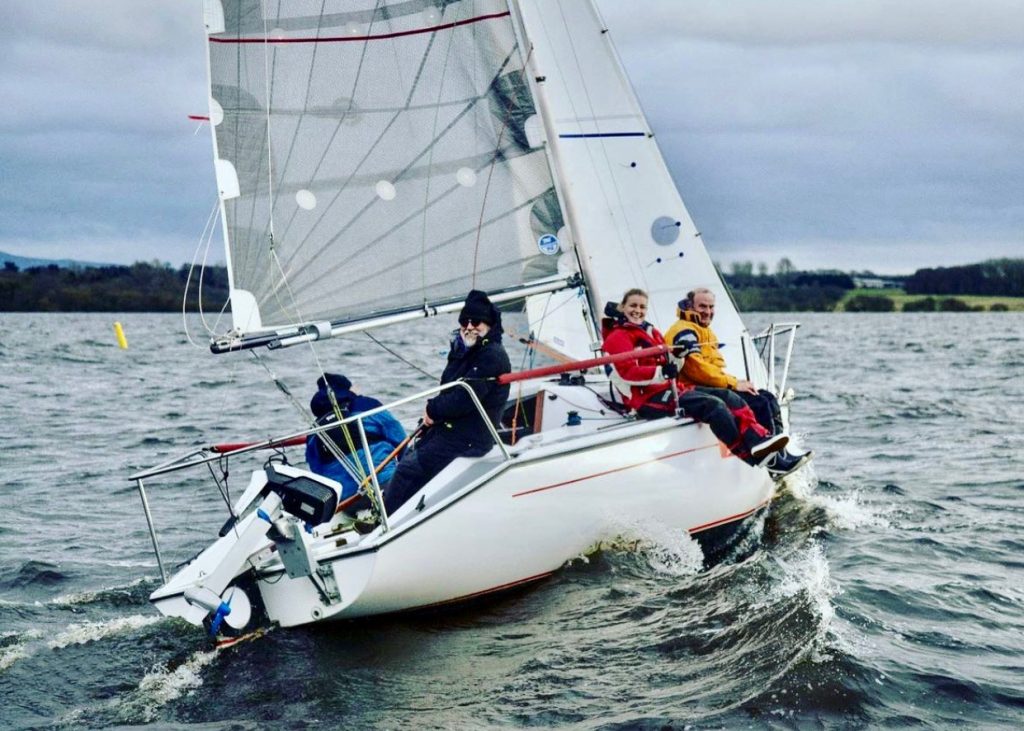
Electric Sailboat Motor: Confusion Explained
Can you go cruising with an electric sailboat motor? Can you put an electric motor on a sailboat? Are there any limitations?
Whether electric sailboat motors are a good fit for your boat is not a YES or NO question. Here we will explain your top worries with statistics and facts. That way, you can make a wise decision according to your situation.
You may hear some complaints about the batteries and range of the electric propulsion.
However, their experience may not suit electric sailboat motors.
In fact, even small electric engines work pretty well in many sailboats. That’s because most of the time, the wind can power the boat, and the motor is just used for docking or in rare times when there is no wind.
Therefore, it makes more sense to learn electric sailboat motor performance in real-world applications.
Here is a test report of a 3 HP electric sailboat motor on an RS21 racing sailboat:
As you can see, the small electric sailboat motor can run at 5.5 mph top speed for one hour continuously.
And there is a big difference in terms of range vs speed for electric sailboat motors:
If you lower the speed, the range and runtime can be greatly extended. The slower you go, the further you’ll get. For example, if you cut your speed in half, the electric sailboat motor can last 7 hours and go 20 miles within one charge.
That’s pretty sufficient if you use the electric yacht motor mostly for docking or as an auxiliary engine.
Faster top speed (and more range) is available with higher power electric sailboat motors depending on your specific requirements. Contact a specialist to design your electric sailboat motor solutions.
Also, don’t forget to get the electric sailboat motor with regeneration (See recommendations below).
That’s to say, when there is a lot of wind and you’re moving rapidly via your sails, they regenerate and store electric power on the batteries to keep you moving at other times. Solar recharging is also a plus.
Essentially, the range depends on how many batteries you have, so it’s not a limitation of electric sailboat motors but energy and batteries.
If you are still worried, you can offset this by getting a diesel generator, which is more efficient than a diesel engine. And it is a range extender when you need it, but for 90% of your motoring that you don’t need the range, you can rely on the electric sailboat motor.
Some of you might be concerned about the extra weight of the batteries.
In fact, an electric sailboat motor with lithium batteries weighs less than a diesel engine, particularly if you include the fuel weight.
If you want a lightweight electric sailboat motor solution, make sure you get one with LiFePO4 batteries . Compared with other marine batteries, they are more compact in design with much less weight and higher energy density.
Some more advanced electric motors for small sailboats (such as Spirit 1.0 Evo) feature an integrated lightweight battery. So you don’t need to worry about the complex wiring to hook it up or extra space to store the battery.
This is a huge plus if you want to use the electric sailboat motor on a tender or dinghy.
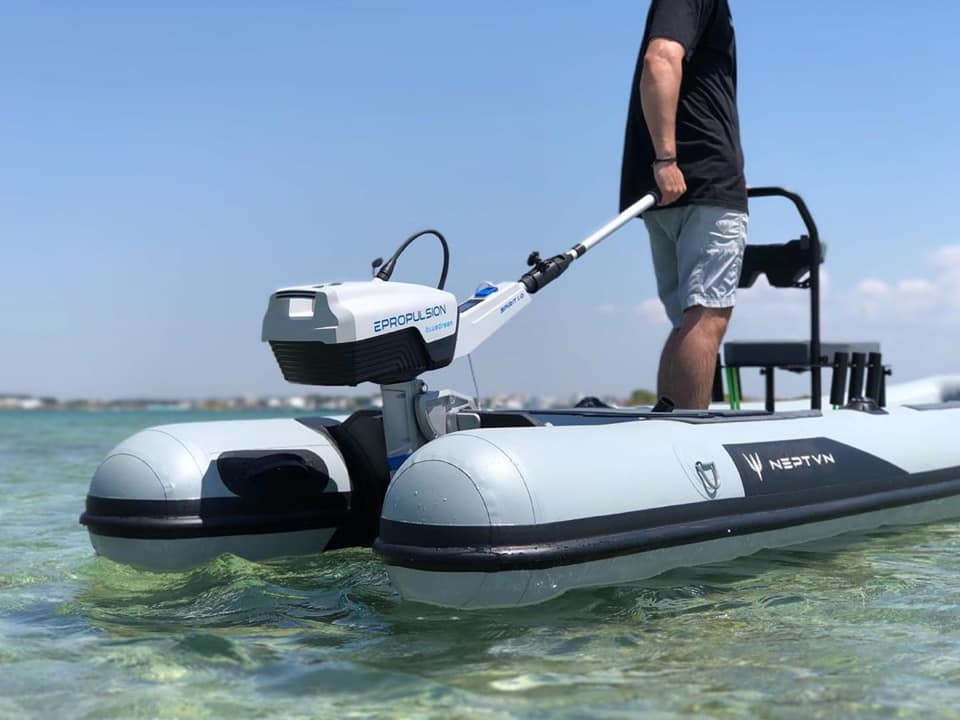
Here is also a chart that collects the weight of some popular electric sailboat motors for your reference:
For many people, another big problem with electric sailboat motors is the cost.
It’s true that a gasoline outboard with similar power is a lot cheaper to buy. However, the electric sailboat motor eventually wins in long-term operating cost. That’s especially the case if you are going to do a lot of motoring.
Electric sailboat motors save on fuel and maintenance costs, which can build up to a large amount over time.
Here is a chart that compares the cost of a 3HP electric sailboat motor (coming with a built-in battery) with its combustion counterpart:
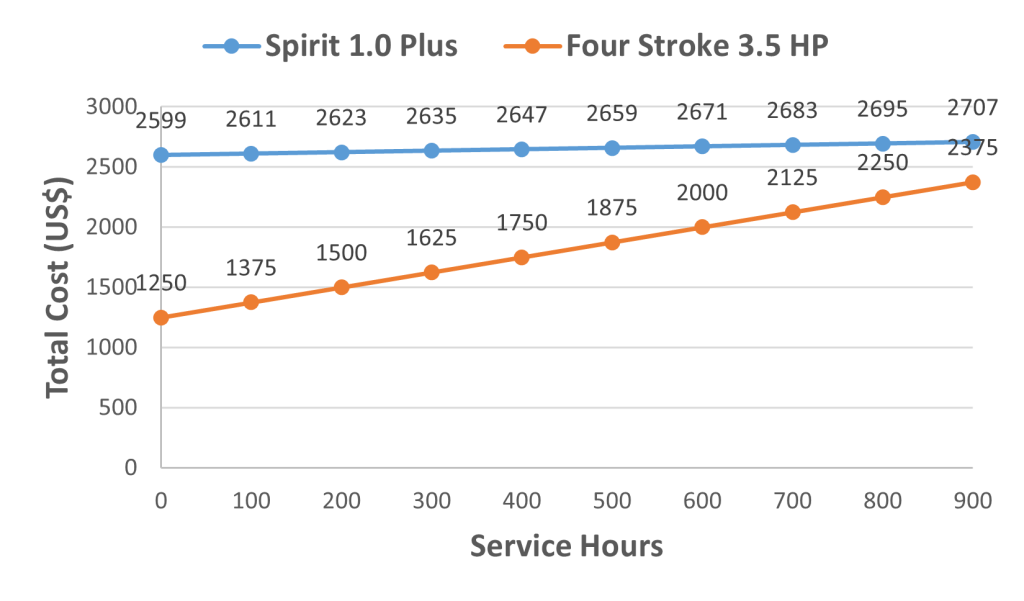
That’s to say, you will cover the price difference for electric yacht motors eventually as long as you use it long enough. Click to check the details of the calculation .
What makes the electric sailboat motor even more worthwhile is it saves you a lot of hassles, especially for sailors who only use the engine in and out of the harbor. Dealing with the maintenance of the gas outboard for a 10 minute motor out of and into the harbor is disproportionate and painful.
*The higher horsepower electric sailboat motor may be different in terms of the cost calculation. Check out the outboard motor pricelist by HP for more information.
As you may have already noticed, electric propulsion has already been widely used in the marine industry:
It’s quiet while motoring, clean to handle, environmentally friendly, with less maintenance and operation costs.
The electric sailboat motors are easier to use with dramatically fewer moving parts to break and no worries about being a diesel mechanic to deal with the hard pulling start. You can have it always on, so it is ready whenever you need it.
And it makes even more sense in sailing applications:
You don’t really need to motor much if your plan is to actually sail. If you are completely becalmed, you will probably just need to motor at 2 knots to keep making way, which is easy for electric sailboat motors.
If you mostly use the motor to get into and out of the harbor, the electric sailboat motor also works great for you.
You can always charge up at the dock, motor out of the marina (or even motor to your sailing area or race start), then hoist the sails and when you’re through, the batteries are charged again.
The electric sailboat motor is also useful as a backup (kicker) motor in case your system goes down. That’s why you can see people pushing a lot of big boats with small electric motors. (Click to learn more information about kicker motors .)
Personally, it’s really nice to have an electric auxiliary in the boat – no smelly, messy diesel and motor oil to deal with, a much simpler system with less maintenance, and much, much quieter operation.
However, powerboats tend to have much higher requirements in terms of both power output and runtime. In that case, an electric sailboat motor can be hard to satisfy your needs.
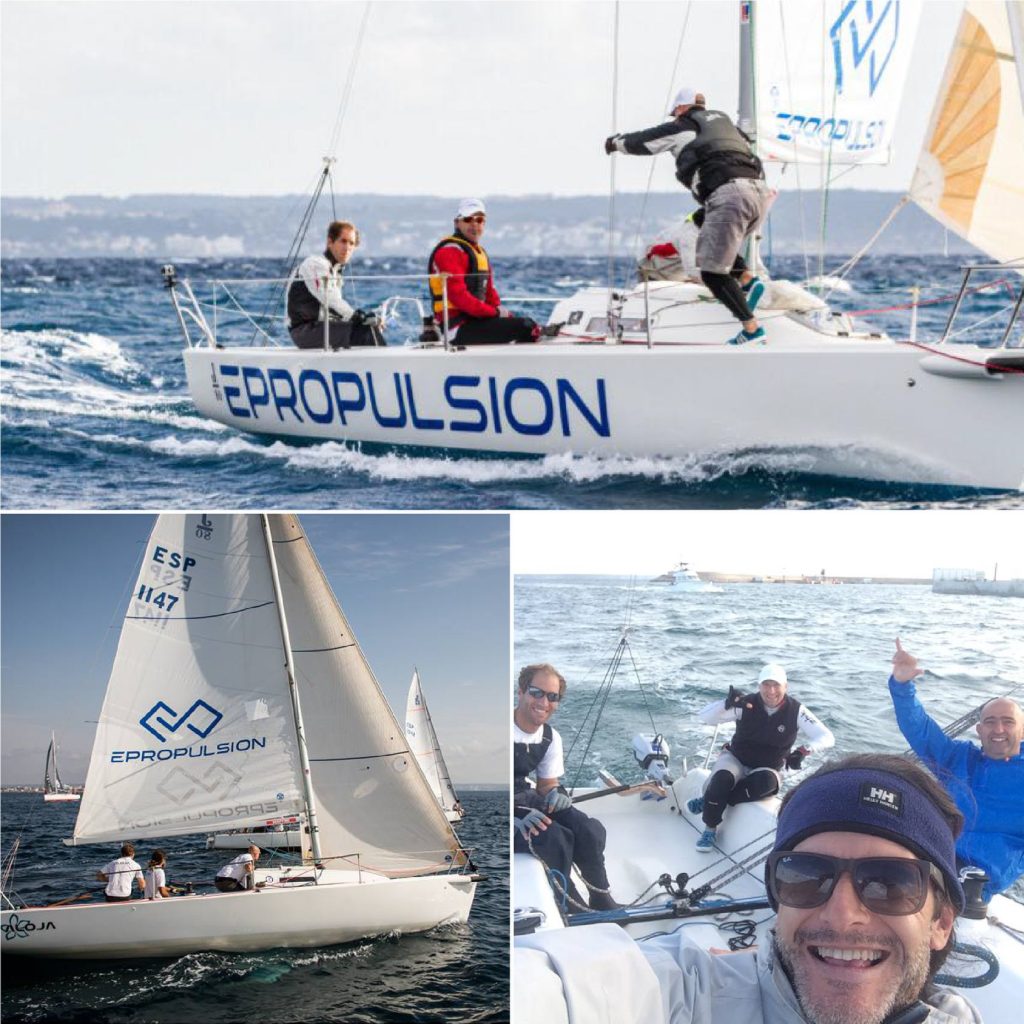
How Do You Size an Electric Motor for a Sailboat?
As a rule of thumb, you will need approximately 1 HP per 550 lb of the displacement of your boat.
Generally speaking, a 3 HP electric sailboat motor can push a sailboat up to 25 ft and a 9.9 HP motor is sufficient for a 30 ft sailboat to motor at a satisfying speed.
However, bear in mind the horsepower you need always depends on your needs and applications.
It’s better to check the data from real-world tests to decide whether the electric sailboat motor is suitable for your specific needs.
For example, the 9.9 HP electric sailboat motor Navy 6.0 allows you to go at 6.9 mph (11.1 kph) on a 30 ft sailboat, and the range can be extended to 46.4 miles if you decrease your speed to 2.9 mph (4.6 kph).
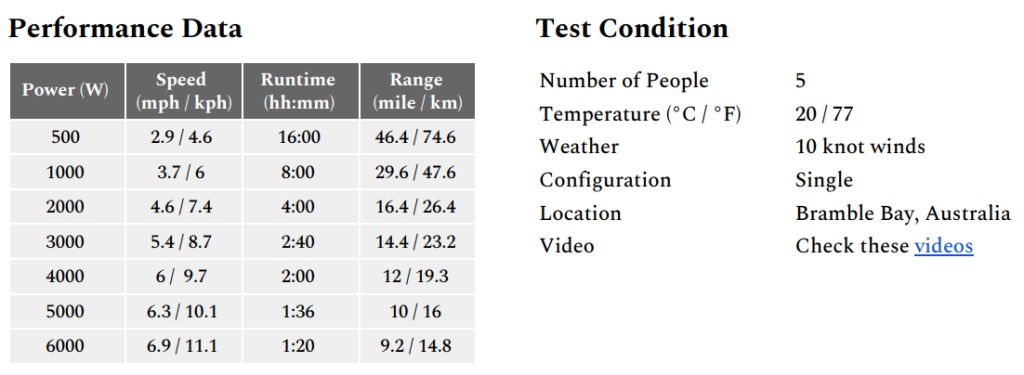
Click to see more test reports with other electric motor and sailboat combinations, and find the electric sailboat motor that suits you best.
If you are still not sure about the size of the electric sailboat motor for you, feel free to leave us a comment and we will get back to you ASAP with professional suggestions.
Electric Sailboat Motor Conversion
Basically, there are two ways for you to convert your sailboat to a clean and quiet electric drive system:
You can either convert your current vessel to electric or buy an engineless yacht and install an electric sailboat motor on your own.
#1. Repower Your Sailboat with Electric Motor
If you decide to replace the diesel engine with an electric motor, you will need to do a lot of preparations:
The DIY approach requires an electric sailboat motor kit (including motor and controller), batteries, a good level of mechanical ability and basic electrical knowledge, as well as some common tools such as a voltmeter.
You will need to take the old engine out for the new electric sailboat motor installation. It’s not an easy task that involves removing the engine mounts and the drive shaft (dealing with the numerous hoses and cables), taking out the engine, exhaust system, fuel tank, and its attendant tubes, etc.
Remember to balance the boat to avoid listing during the electric sailboat motor conversion.
Then in with the new electric sailboat motor. The installation process can be straightforward if you choose the electric sailboat motor kit wisely (See steps below). Furthermore, you can set up solar charging for your electric sailboat motor with solar panels and charger.
Many sailors have recorded their electric sailboat motor conversion process and experience. Be sure to check them out to get some inspiration. For example, Ed Phillips has documented everything which can serve as a guide for newbies to get started.
Mind you there can be a whole heap that can go wrong in designing and maintaining the electric sailboat motor systems. You really need to be totally on top of it if you want decent performance or reliability.
If you are not that technically inclined, it’s better to talk to a specialist first to discuss your plan for a smooth electric sailboat motor conversion.
#2. Install an Electric Motor in a Sailboat
If you own an enginless sailboat, the electric sailboat motor conversion is much easier for you.
All you need to do is to find a reliable electric sailboat motor and install it in simple steps. The whole process can be easily done, even for beginners. Here we take the popular 6 HP electric sailboat motor Navy 3.0 as an example to show you the installation process:
- Step 1 : Rotate the clamps or use the screws to fix the outboard onto the sailboat.
- Step 2: Mount the steering system in the proper position.
- Step 3: Install the tiller on the electric sailboat motor.
- Step 4: Connect the batteries to the electric sailboat motor system.
Click to check the video tutorial that guides you through each step of the installation.
If you are worried about aesthetic issues and want higher horsepower options, an electric inboard motor can be a better suit for your sailboat. If you prefer an inboard motor for your sailboat, contact our OEM team to get an electric propulsion solution tailored to your needs.
Note : You might find some electric trolling motors rated by #s of thrust on the market. Actually, those electric trolling motors for sailboats can only provide limited speed and range. If you are heading into the wind, the trolling motors for sailboats are definitely not an ideal solution.
Once you’ve evaluated if electric sailboat motors are right for you, there are a lot of options for electric systems.
Here are some popular electric sailboat motors with positive reviews from customers worldwide. Fast charger is available for all the models recommended to reduce your charging stress.
#1. 3 HP Spirit 1.0 Evo
If you are looking for an electric motor for a small sailboat, be sure to check out the ePropulsion Spirit 1.0 Evo. It’s suitable for large daysailers or small cruising sailboats under 25 ft.
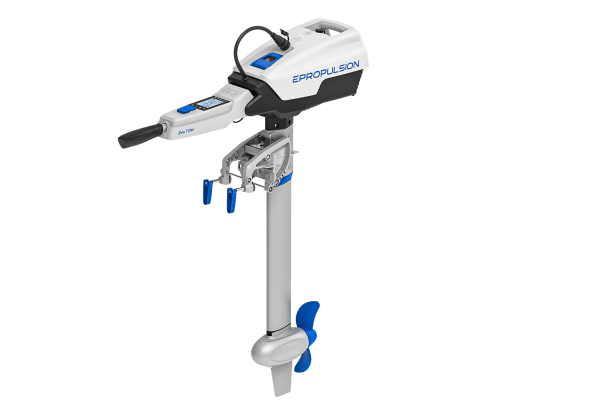
With the Spirit 1.0 Evo electric sailboat motor, you can go 5.5 mph (8.8 kph) at top speed on the 21 ft RS21 sailing boat, or troll for 20 hours continuously at 2.2 mph (3.5 kph) according to our test .
This electric sailboat motor with regeneration allows you to recover energy from the prop while under sail. It will start to generate power automatically when the sailing speed reaches 2 knots.
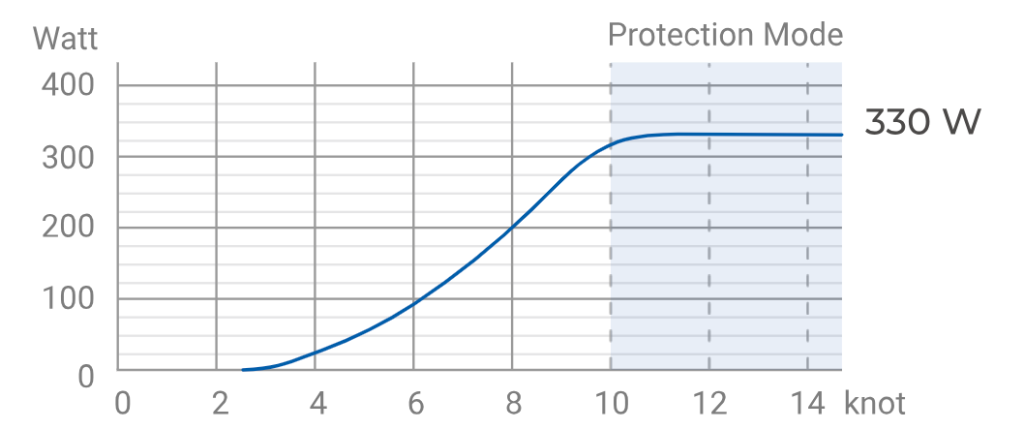
As an electric auxiliary sailboat motor, it can also be easily installed on your tender boats or yacht dinghies since it’s portable and easy to transport (with a lightweight integrated battery).
Features You Will Love:
- Come with the industry-first hydrogeneration capability
- Direct-drive technology makes it maintenance-free
- Portable with a 1276Wh large integrated lithium battery for long range
- Safety wristband keeps you safe in case of MOB
- Digital operation keeps you informed of the battery status
Spirit 1.0 Evo Electric Sailboat Motor Reviews:
“Great weekend with my 17′ sailboat powered by the Spirit Evo. This is great. Quiet and reliable. Went at 3/4 throttle for about 1.5hrs when taking it back to boat ramp.” – Robert Taylor
“Very happy with our Spirit Plus. Pushing our Kolibri 560 a 750 Kg sailboat, with ease. Doing about 5.8 km/h at 500W.” – Frank van Asten
#2. 6HP/9.9 HP Navy Evo Series
If you want a little more juice on the electric sailboat motor, check out the ePropulsion Navy Series. It offers 6 HP and 9.9 HP models for your selection and it provides sufficient power for sailboats up to 30 ft.
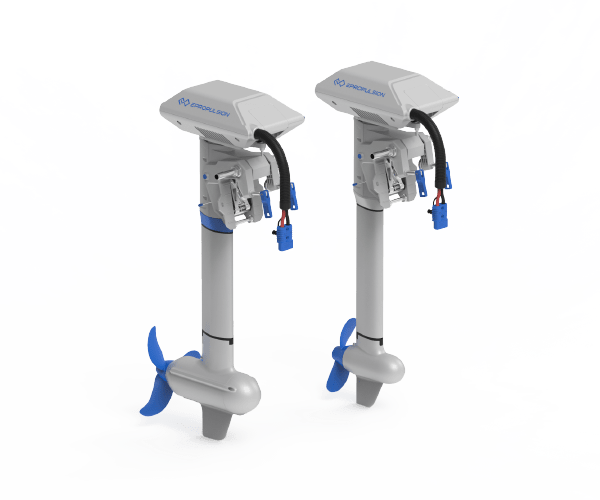
According to our test , the 6 HP electric motor Navy 3.0 can push the Catalina 25 sailboat (25 ft) at 6 mph (9.6 kph) top speed, while the Olga 33 sailboat (33 ft) can go at 7.5 mph (12 kph) with the 9.9 HP Navy 6.0 motor.
The Navy series electric sailboat motor also comes with regeneration features which can be recharged with hydrogeneration, wind turbine, and solar panel.
- Four controls to fit your sailboat installation and your boating style
- Accompany LiFePO4 batteries (need separate purchase) are more energy efficient
- Digital display offers real-time monitoring of the power and battery
- Magnetic kill switch and safety wristband keep you safe on the boat
- Electric start saves you trouble pulling the cord to start
Navy Series Electric Sailboat Motor Reviews:
“I have a Navy 3.0 with E80 on a Catalina 25 sailboat. It is working well. Currently I am using about 4% battery to go in/out of the marina by boat.” – Aaron Young
“Just finished my 8 weeks sailing journey in the Baltic Sea. The two Navy 3 outboards provide enough power for my 33ft catamaran. The 400W solar panels provided enough energy for engines and all other energy consumed on board with 2-6 persons. The two Navy Batteries provide power for engines and all other on-board electric devices. I never had to use shore power, so totally self-sufficient electric system.” – Martin Hildebrand
Recent Posts

ePropulsion Sustainably Mobilizes Hundreds of Sightseeing Bamboo Rafts on the Guilin Li River

Bass Boat Motors: The Only Guide You Need in 2024

ePropulsion’s Revolutionary eLite Electric Outboard Motor Wins Innovation Award in Miami
Join the discussion cancel reply.
Save my name, email, and website in this browser for the next time I comment.
Notify me via e-mail if anyone answers my comment.
This site uses cookies to personalize your experience and analyze site traffic. By clicking accept or continuing browsing the site, you are agreeing to our use of cookies. See our Privacy Policy here .
View the Serial Number
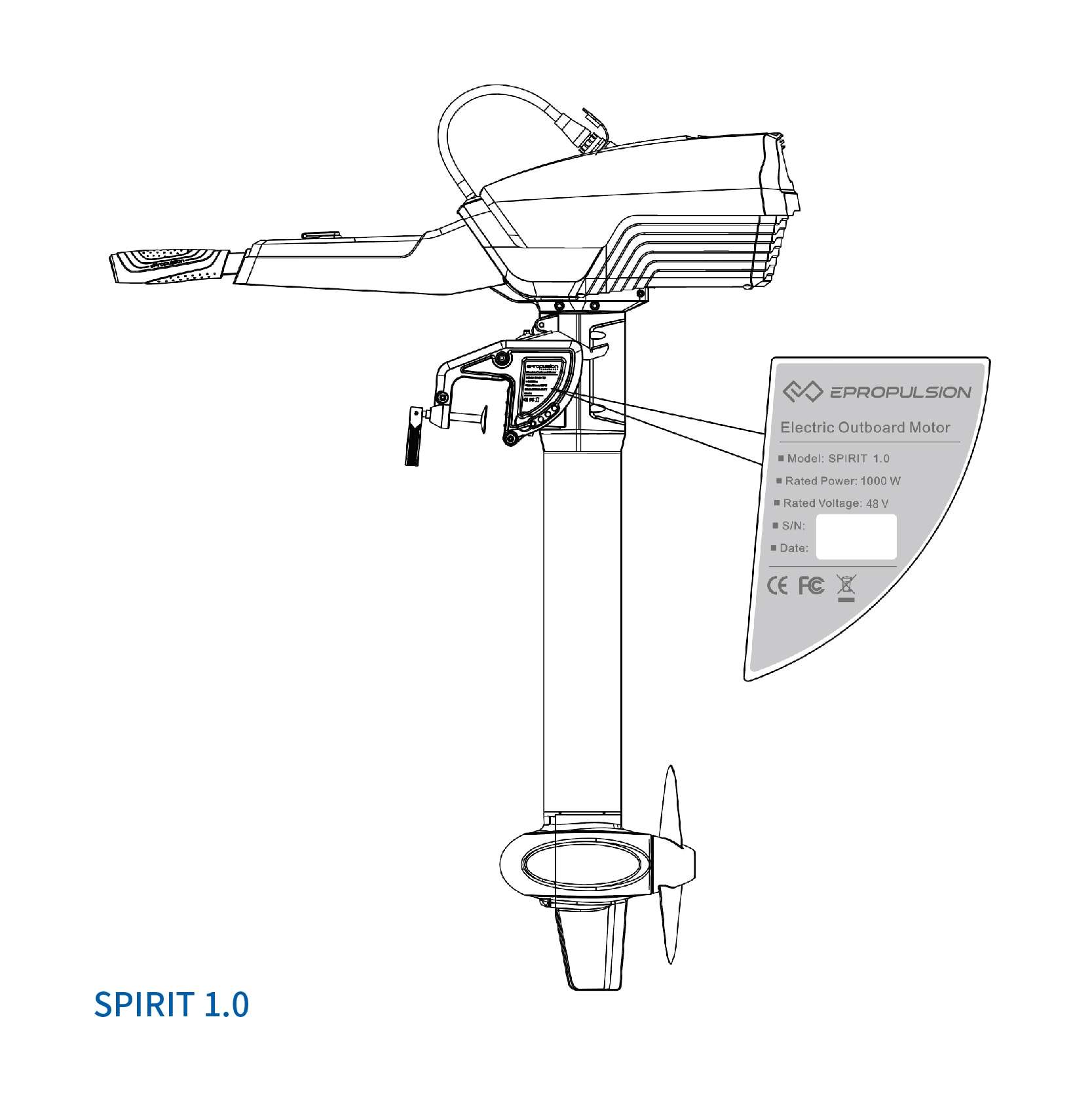
What Size Outboard Motor for What Size Boat? (Boat Horsepower Chart)
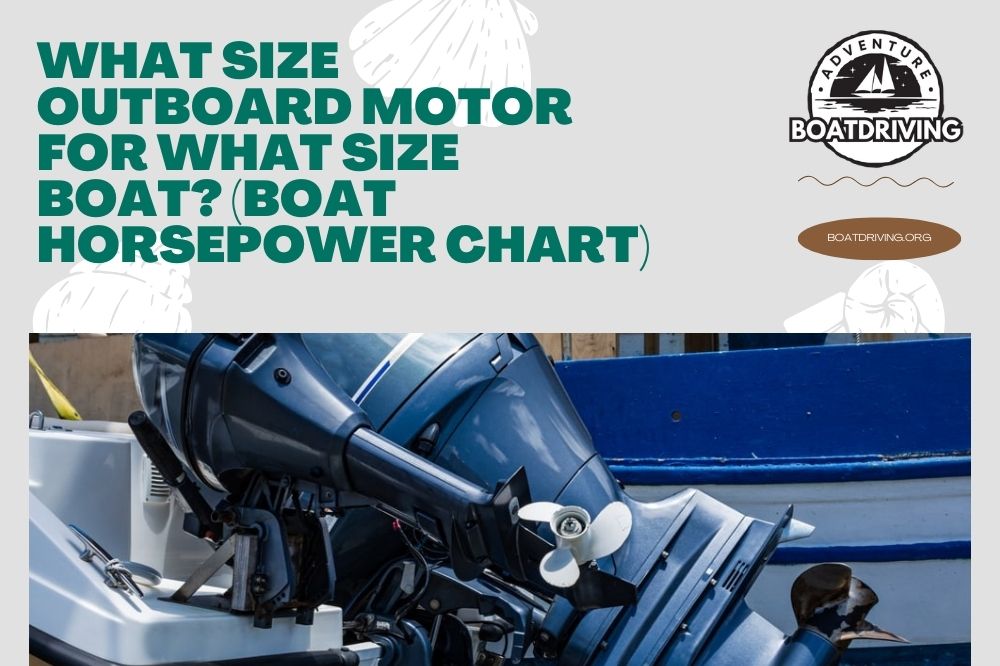
Once you buy a boat you want, it is time to determine what size outboard motor for what size boat. As you can guess, there is no magic formula for estimating it precisely, but you can get rough numbers when you check relevant information.
You should start with a boat type , a maximum passenger number, and the equipment weight you plan to carry. Then, you can determine the maximum horsepower recommended for your vessel. Finally, think about 2-strokes and 4-stroke motor options, right propeller size , and fuel type. Sounds complicated? Let’s make it easier!
Table of Contents
Motor Size Matters
Things to consider when selecting an outboard boat engine, ways of pair an outboard motor with your boat size.
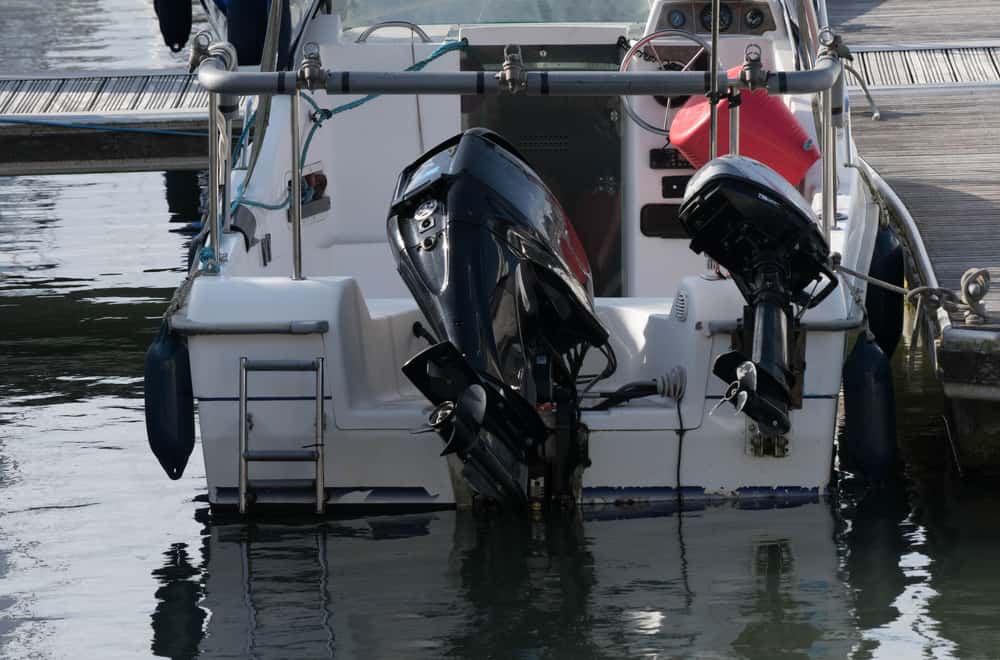
Yes, an engine size matters , and it is crucial to pair it with an adequate boat size to let it run smoothly.
Bigger motors with higher horsepower offer numerous benefits for comfortable boating, such as:
- You can sail at high speed
- A more sizable engine provides better handling, particularly when sailing at midrange speeds
- It makes water sports cozier
- You can count on better time maneuvering
- Such an engine will give you better control and provide more secure sailing in harsh weather condition
- Surprisingly, a motor with a bigger fuel tank uses less fuel
Downsides of a small engine
A too-small engine typically has difficulty powering a bigger boat so it will spend more fuel than a bigger model. Another problem is sailing with more passengers and equipment since extra load requires a motor with more horsepower.
Therefore, you should check the max HP a boat can handle before purchasing. That rating will show you a top weight it can carry, and you can risk uncomfortable and unsafe sailing, plus possible Coast Guard fines when exceeding it.
The vessel horsepower ranges from 2.5 to 1,000+ HP for contemporary outboard motors . You should pick out the most powerful one your boat can handle to provide smooth and comfy sailing.
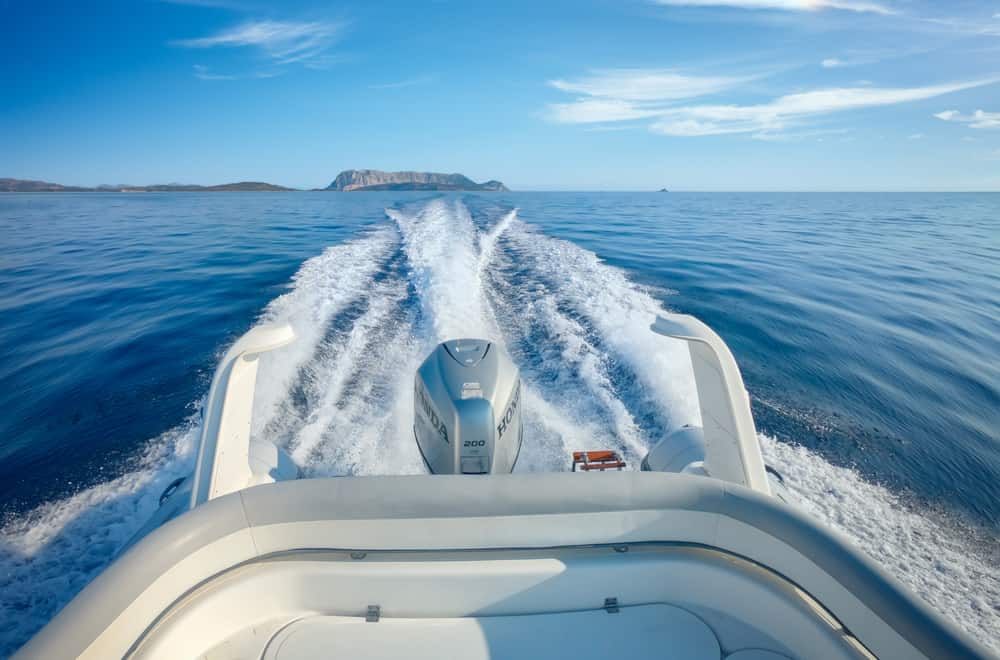
Horsepower is used to measure the engine power. On average, your vessel will need 5 HP per 2,200 pounds (1,000 kg) its weight. Small boats shouldn’t use more than 75% to 80% of the max HP because of the possibility of rough waters and headwinds while sailing.
Only that way, you can count on enough thrust to drive as desire. You should think about a few things when determining how much horsepower your boat needs, including:
Manufacturer limits
Manufacturers’ recommendation always shows a maximum passengers number and cargo weight your boat can carry. You can also find the absolute max boat HP in the manual.
If you have a boat built after 1972, you can find a capacity plate with this information inside the transom. Older vessels, home-built models, and those made overseas typically don’t have that plate.
However, you can contact the manufacturer or look for their manuals online to discover limitations and recommendations for your boat.
Horsepower-to-weight ratio
The only way to precisely determine your boat’s necessary horsepower is to consider its weight. You can calculate this ratio in horsepower per pound or vice versa.
HP/boat weight = required horsepower per 1 pound (0.45 kg)
boat weight/HP = number of pounds per horsepower
Let’s say you have a boat weighing 5,000 pounds (2,268 kg) with an engine of 300 HP. The calculation will look like:
- 5,000 pounds / 300 HP = 16.6 pounds (7.5 kg) per horsepower
- 300 HP / 5,000 pounds = 0.06 HP per 1 pound (0.45 kg)
You should do the math to match the desired outboard engine with your boat size correctly. The result will show how fast your boat will go since its speed will be higher when these numbers are lower.
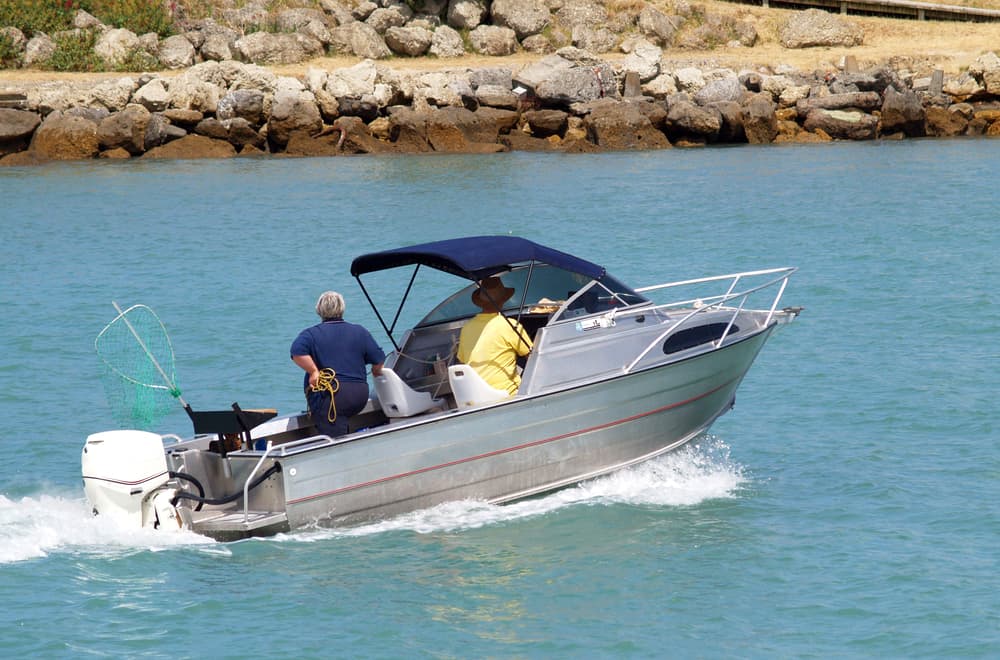
Horsepower your boat needs will also depend on its use. Any additional equipment weight or pulling water skiers behind the vessel increase the power it needs.
Number of passengers
In this case, the rule is simple. Your boat engine will work properly only when it carries 25 to 40 pounds (11.5 – 18 kg) per horsepower.
Once you have this information, you can check the boat weight and add the total weight of the passengers you plan to host on it. Then, you can effortlessly determine engine HP that matches your boat.

Fuel efficiency
As you can guess, the motor HP impacts the boat’s fuel efficiency, but that doesn’t mean a higher-horsepower engine necessarily consumes more fuel.
For instance, your motor with lower HP will use more gas at full throttle than the one with higher HP running with less throttle.
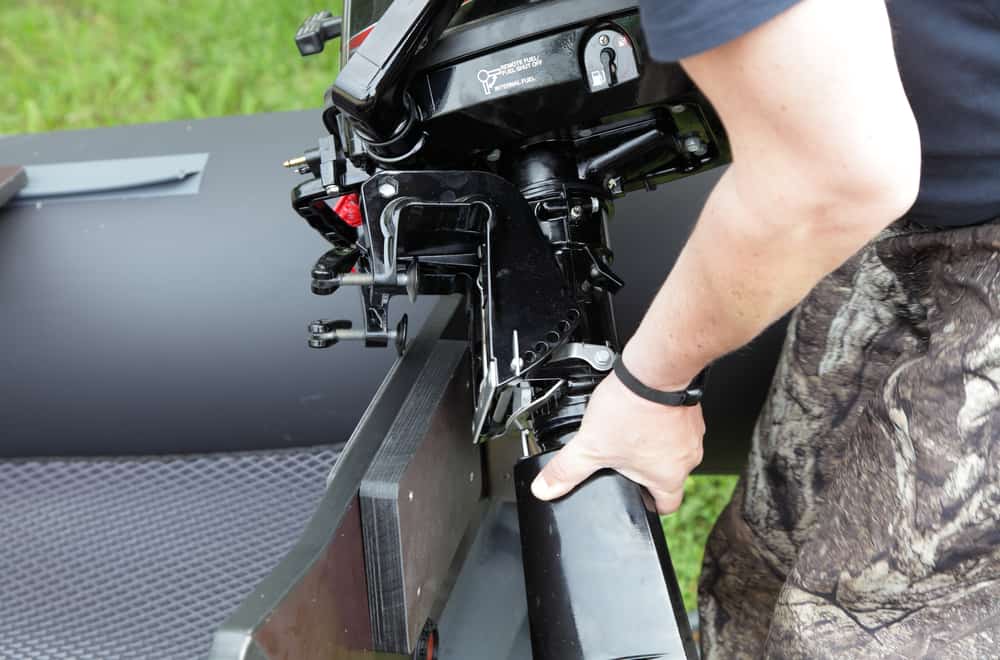
Engine type
Both 2-stroke and 4-stroke engines are good options. You should choose one or another, depending on the feature crucial for you.
The rule of thumb is that 2-stroke motors are lighter and less expensive, while 4-stroke models with the same power are quieter. However, these differences are diminishing nowadays.
Engine weight
One of the vital things is to match the outboard engine weight and boat size . That way, you will ensure sufficient power for the desired speed without jeopardizing safety and maneuverability.
Most 2 to 10 HP outboard engines weigh 35 to 90 pounds (16 – 41 kg). On the other hand, you should count on 100 to 160 pounds (45.5 – 72.5 kg) for a 20 to 30 HP motor. In this case, you can have a problem carrying a too heavy engine around.
Required speed
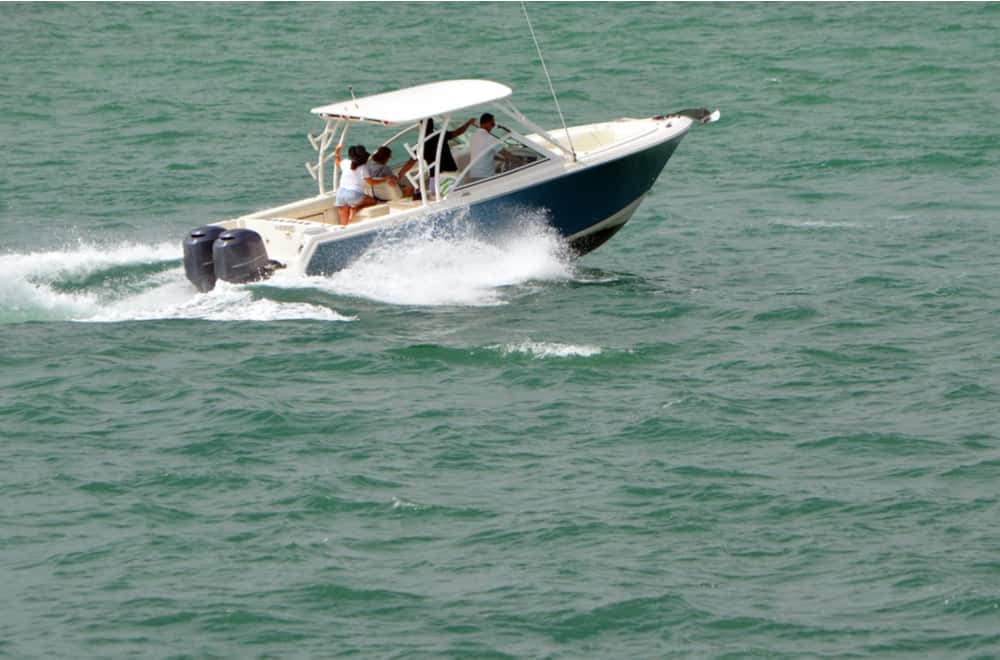
The rule of thumb is that your boat needs more power to reach a higher speed. The equation says that 1 HP can move 40 pounds (18 kg) of boat weight at 20 mph (32.2 km/h). According to that, you can calculate that your boat weighing 2,000 pounds (907 kg) needs 50 HP to reach the speed of 20 mph (32.2 km/h).
Federal regulations
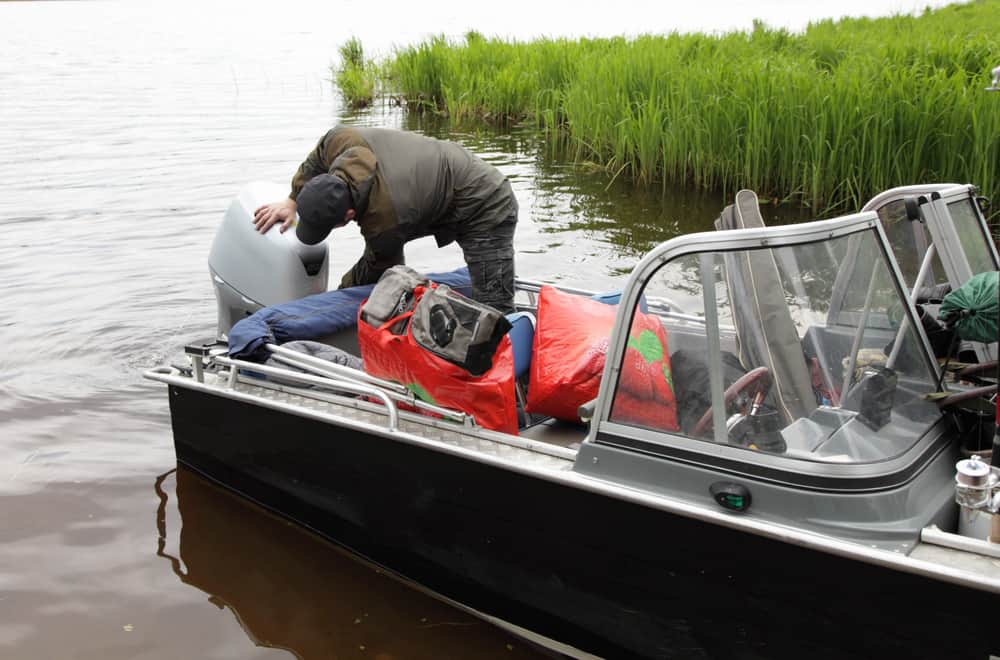
In the US, it is illegal to overpower your boat. The Code of Federal Regulations clearly defines vessel overpowering, so you should check it before getting into a situation to break federal law.

You should know that your boat’s horsepower directly affects its insurance , and models with higher HP typically has higher premium costs. Keep in mind that the insurance company won’t cover a boat with an upgraded engine that exceeds the max HP recommended by the manufacturer.
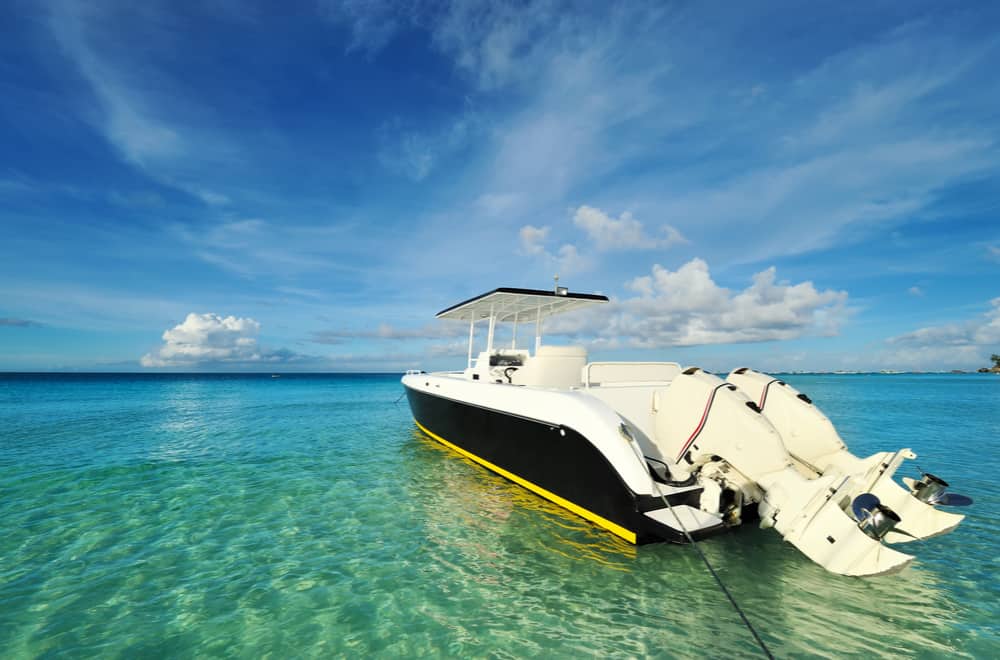
The best way to properly pair an engine with a boat of a particular size is to determine its horsepower.
2 to 3.6 HP engine
These small, less than 40 pounds (18 kg) weight, 2-stroke outboard engines are an excellent option for portable boats, like:
- Inflatable boats
- Small pontoons
- Small sailboats
They can push small boats at 5 to 9.5 mph (8 – 15 km/h), depending on weather conditions, current, as well as boat weight and design.
5 to 6 HP engine
This horsepower range is ideal for boats weighing 8 to 11.5 pounds (18 – 25 kg), including:
- 12 feet (3.65 m) long inflatable boats
- Portable folding boats
- Large canoes
- 8 to 12 feet (2.5 – 3.65 m) long inflatable and dinghy boats
Such an engine can propel your vessel with one person at 10 to 17.5 mph (16 – 28 km/h).
8 to 9.8 HP engine
You should pick out this small but powerful 11.5 to 20.5 pounds (25 – 45 kg) heavy outboard engine for your:
- 10 to 14 feet (3 – 4.5 m) long inflatable and aluminum boats
- Large portable folding boat and sturdy canoe
- Up to 14 feet (4.5 m) long light fiberglass boats
An outboard motor in this range is an excellent option for propelling a boat carrying a light load and two people at 9.5 to 17.5 mph (15 – 28 km/h).
15 to 25 HP engine
Although powerful, these 16.5 to 23.5 pounds (36 – 52 kg) heavy 4-stroke outboard engines are still in a small outboard HP class. They are an excellent choice for:
- 10 to 14 feet (3 – 4.5 m) long inflatable boat
- 12 to 16 feet (3.65 – 5 m) long Jon boat , fiberglass boat , and aluminum fishing boat
These smooth-running engines can propel most boats to 25 mph (40 km/h) when carrying several people and heavy loads.
Whatever boat type you have, you should buy the smallest possible outboard engine that can allow a max hull speed with 90% of the revolutions per minute. Unless you want a higher-speed boat , you can use your 20 HP engine for twenty years and get an excellent fuel economy.
Related posts:
- 6 Tips to Buy a Small Boat Motors
- What Should You Do Immediately If a Boat Motor Catches Fire? (Causes & Prevention Tips)
- How Much Does A Boat Motor Cost? (3 Types)
- 10 Best Small Outboard Motors
3 thoughts on “What Size Outboard Motor for What Size Boat? (Boat Horsepower Chart)”
Look I’m getting confused. I’m looking at 20 to 21 foot fiberglass star craft. My weight is around 260 my girl is around180. The dealers are trying to sell me a 150 yamaha. A northern dealer is trying to sell me a 20 ft boat with a 70 hp yamaha. The price is nice for the 70 hp but I’m not shore that it’s good for that boat. Help.
The lower the “hp/lb” value, the faster the boat. For example, you have a 3,000-pound boat with a 200-horsepower outboard motor. A pound will correspond to 0.067 HP.
The weight boat is one of the variables to consider when finding the maximum horsepower. Calculating the ratio between horsepower and weight is straightforward. You only need your boat’s weight and its boat HP rating.
Leave a Comment Cancel reply
Save my name, email, and website in this browser for the next time I comment.

Sailboat Outboard Motors
A sailing trip is complete when the wind blows through your hair and the sun shines in your eyes. By having a sailboat engine onboard, you can savor the memorable moments and keep your mind on what matters most. In addition to being quiet and efficient, our engines provide reliable power and a minimum of vibrations, where and when you need it most. We provide the best sailboat that has an inboard Yanmar engine. It is a small, simple, 15 horsepower engine you can find what you want on First Class Outboards. Buy Sailboat Outboard Motors online at the best price.

- Add to Wishlist Add to Wishlist
- 9.9 HP , Best Selling , Fishing Boat Engines , Jon Boat Motors , Kicker Outboard Motors , Mercury , Mercury 9.9 HP , Sailboat Motors
2022 Mercury 9.9 HP 9.9MH Outboard Motor
- $ 2,730.00 $ 2,593.50
- The portable Mercury 9.9hp outboard motor is lightweight, compact, and powerful making it a great choice for long shaft jon boats, skiffs, and small pontoons as well as auxiliary power for your sailboat. The Mercury 9.9 HP outboard engine is a two cylinder four-stroke marine engine that delivers smooth, quiet, fuel efficient power. Weighing 84 lbs., the Mercury 9.9 HP…
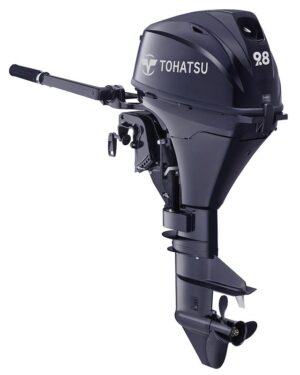
- 9.8 HP , Best Selling , Fishing Boat Engines , Jon Boat Motors , Kicker Outboard Motors , Sailboat Motors , Tohatsu , Tohatsu 9.8 HP
2022 Tohatsu 9.8 HP MFS9.8BS Outboard Motor
- $ 2,496.00 $ 2,371.20
- The Tohatsu 9.8hp outboard motor has set the standard for affordable and portable power. The Tohatsu model # HP MFS9.8BS Weighs just 81.5 lbs with compact features making it easy to carry. This model is equipped with a short 15 inch short shaft and a manual rope pull start. The Tohatsu 9.8hp outboard engine is the lightest four-stroke in its…

- 6 HP , Best Selling , Fishing Boat Engines , Jon Boat Motors , Kicker Outboard Motors , Sailboat Motors , Tohatsu , Tohatsu 6 HP
2022 Tohatsu 6 HP MFS6DWSPROUL SAIL PRO Outboard Motor
- $ 1,980.00 $ 1,881.00
- The all new Beluga White 6 hp Tohatsu outboard motor model MFS6DWSPROUL is the largest single-cylinder model available and comes equipped with the 25 inch extra long shaft, high thrust prop and 12V alternator for charging a battery. The new MFS6DWSPROUL Sail Pro also comes equipped with the newly designed top and bottom cowls based on Tohatsu Design Philosophy for…

- 6 HP , Best Selling , Fishing Boat Engines , Jon Boat Motors , Kicker Outboard Motors , Sailboat Motors , Small Boat Motors , Tohatsu , Tohatsu 6 HP
2022 Tohatsu 6 HP MFS6DWSPROL SAIL PRO Outboard Motor
- $ 1,950.00 $ 1,852.50
- The all new Beluga White 6 hp Tohatsu outboard motor model MFS6DWSPROL Sail Pro is the largest single-cylinder model available and comes equipped with a 20 inch long shaft length, high thrust prop and 12V alternator. The new MFS6DWSPROL Sail Pro also comes equipped with the newly designed top and bottom cowls based on Tohatsu Design Philosophy for Marine Products, 3-way storage…

- 6 HP , Best Selling , Fishing Boat Engines , Jon Boat Motors , Kicker Outboard Motors , Outboards For Solo Skiff , Sailboat Motors , Small Boat Motors , Tohatsu , Tohatsu 6 HP
2022 Tohatsu 6 HP MFS6DWS Outboard Motor
- $ 1,789.00 $ 1,699.55
- The all new Beluga White 6hp Tohatsu outboard motor is the largest single-cylinder model available offered by Tohatsu. The new MFS6DWS comes equipped with the newly designed top and bottom cowls based on Tohatsu Design Philosophy for Marine Products, 3-way storage positions without worrying about oil spill, ultra-low emission, EPA and CARB 3-Star rating approved, and the newly designed Tohatsu unique…

2022 Tohatsu 6 HP MFS6DWDS Outboard Motor
- $ 1,711.00 $ 1,625.45
- The brand new Beluga White 6hp Tohatsu outboard motor is the largest single-cylinder model available. The Tohatsu 6 HP model MFS6DWDS is equipped with the 15 inch short shaft and integral tank with an external connector. The new MFS6DWDS also comes equipped with the newly designed top and bottom cowls based on Tohatsu Design Philosophy for Marine Products, 3-way storage positions without…

- 5 HP , Fishing Boat Engines , Jon Boat Motors , Kicker Outboard Motors , Outboards For Solo Skiff , Propane Outboards , Sailboat Motors , Tohatsu , Tohatsu 5 HP
2022 Tohatsu 5 HP MFS5DLPGS Propane Outboard Motor
- $ 1,771.00 $ 1,682.45
- Tohatsu's 5 hp Liquefied Petroleum Gas (LPG) outboard standard model is equipped with a fuel line that will connect to any standard propane tank. Tohatsu's high-performance, innovative LPG model offers easy starting, quieter operation and nearly no maintenance on fuel-related components. This fuel-efficient model will run for a full 5 hours WOT on a single 11lb propane tank. The new MFS5DLPGS…

- 3.5 HP , Four-Stroke Outboards , Inflatable Fishing Boat Motors , Outboards For Solo Skiff , Outboards Shipped Free , Sailboat Motors , Small Boat Motors , Tohatsu , Tohatsu 3.5 HP
2022 3.5 HP MFS3.5CS Tohatsu Outboard Motor
- $ 1,216.00 $ 1,155.20
- Need lightweight portable power? The powerful 3.5hp Tohatsu outboard motor includes all 2.5hp features plus enhanced features such as a larger carburetor for increased performance. The new 3.5 hp 4-stroke outboard includes the newly designed top and bottom cowls based on Tohatsu Design Philosophy for Marine Products, 3-way storage positions without worrying about oil spill, the newly designed front and back…
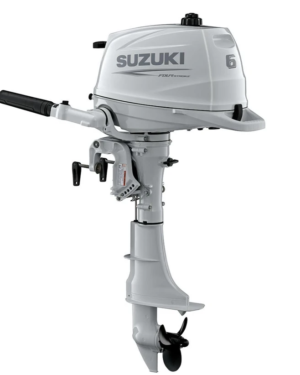
- 6 HP , Fishing Boat Engines , Jon Boat Motors , Kicker Outboard Motors , Sailboat Motors , Small Boat Motors , Suzuki , Suzuki 6 HP
Suzuki 6 HP DF6ASW3 Outboard Motor
- $ 2,090.00 $ 1,985.50
- If you're in search of lightweight portable power, the 52 lb. Suzuki 6hp outboard motor model DF6ASW3 is an excellent choice for jon boats, skiffs, tenders and small to medium sized inflatables. The all new Super Cool White 6hp Suzuki engine with a 15 inch shaft offers the largest displacement of any one cylinder outboard in this hp and weight…
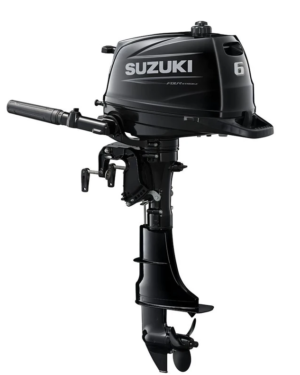
- 6 HP , Best Selling , Fishing Boat Engines , Jon Boat Motors , Kicker Outboard Motors , Sailboat Motors , Small Boat Motors , Suzuki , Suzuki 6 HP
Suzuki 6 HP DF6AS3 Outboard Motor
- $ 2,025.00 $ 1,923.75
- If you're in search of lightweight portable power, the 52 lb. Suzuki 6hp outboard motor model DF6AS3 is an excellent choice for jon boats, skiffs, tenders and small to medium sized inflatables. The 6hp Suzuki engine with a 15 inch shaft offers the largest displacement of any one cylinder outboard in this hp and weight class. The 6hp Suzuki outboard…

- 2.5 HP , Best Selling , Cheap Outboards , Four-Stroke Outboards , Inflatable Fishing Boat Motors , Outboards Shipped Free , Sailboat Motors , Small Boat Motors , Suzuki , Suzuki 2.5 HP
Suzuki 2.5 HP DF2.5S4 Outboard Motor
- $ 1,100.00 $ 1,045.00
- Suzuki's 2.5hp model DF2.5S4 outboard motor is a perfect choice for square stern canoes, small tenders and inflatables as well as other small craft. At only 29 lbs, it's the lightest 4-stroke Suzuki outboard ever built. 2.5hp Horsepower 29.0 lb Weight Shaft Length: 15" (Short) Starting: Manual SKU: DF2.5S4-22
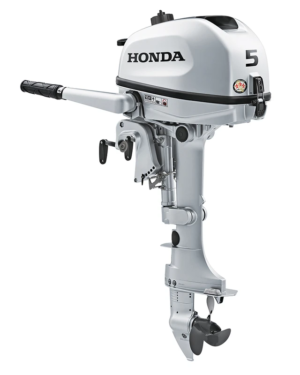
- 5 HP , Best Selling , Fishing Boat Engines , Honda , Honda 5 HP , Jon Boat Motors , Kicker Outboard Motors , Sailboat Motors , Small Boat Motors
2022 HONDA 5 HP BF5DHSHNA Outboard Motor
- $ 2,056.00 $ 1,953.20
- Quiet, dependable, lightweight - this is exactly what you want in a portable outboard. The BF5D is incredibly lightweight and compact. It's easy to transport and ideal for small tenders, canoes, and jon boats. And with features designed to make your boat ride smooth, quiet, and Honda dependable, you'll be ready to enjoy a day on the water for years…

- 2.3 HP , Best Selling , Cheap Outboards , Four-Stroke Outboards , Honda , Honda 2.3 HP , Inflatable Fishing Boat Motors , Outboards Shipped Free , Sailboat Motors , Small Boat Motors
2022 HONDA 2.3 HP BF2.3DHLCH
- $ 1,177.00 $ 1,118.15
- Only Honda manufactures a 2.3 HP outboard with a 20 inch long shaft, and that is only the beginning of what makes this 2.3 HP outboard special. The Honda 2.3HP BF2.3DHLCH features more power over it's predecessor, plus a 12% larger internal gas tank allows for about an hour more of operation on the water in full throttle! Known for…

- Subscribe Now
- Digital Editions

Best electric outboard motors: 11 top options for zero-emissions propulsion
- Electric boats
- Top stories
Electric outboard motors seem to be springing up all over the place right now. We round up 11 of the best electric outboards on the market…
Electric outboard motors are nothing new, after all the humble electric trolling motor has been around for decades, but in the past couple of years a new breed of more powerful units has emerged.
Capable of powering everything from a tender to a 50-knot sportsboat, this new generation of electric outboard motors will surely play a big role in the growing trend towards all- electric boats .
We’ve rounded up 11 of the best options available on the market right now to help you track down the right one for cutting down your boat’s carbon footprint.
Compact electric outboard motors for your tender

Torqeedo 603 Travel
Weight: 15.5kg Power: 600W / 0.8hp Battery: 500Wh Range: 11nm Price: £1,499
Torqeedo has been making electric outboard motors for quite a while now, and their latest offering slots into the travel range of electric outboards between the 503 (1.5hp) and the 1103C (3hp).
All the usual Torqeedo refinements are present and correct. IP67 rated as totally waterproof, the 603 Travel has a magnetic kill cord and an onboard computer providing instant readouts of operating range at current RPM and battery-charge status displayed on the tiller arm.
You can link it to an Apple or Android app and gain even more information including a map-based range indicator.
Read more about the Torqeedo 603 Travel

Mercury Avator 7.5e
Weight: 27.1kg Power: 750W / 1hp Battery: 1kWh Range: 34nm Price: $1,500
Announced in early 2022 and launched less than a year later, the Mercury Avator 7.5e is the first electric unit from the world’s biggest builder of outboard engines .
The whole top plate hinges up to reveal the battery, which can be quickly removed from your electric boat or replaced for convenient charging.
It’s by no means the lightest electric outboard motor on the market, but its claimed range at 25% throttle is very impressive – we look forward to putting one to the test.
Not resting on its laurels, Mercury launched the Avator 20e and 35e this summer as well. These units are no bigger than the 7.5e, but need wiring in to an on-board battery bank.
Read more about the Mercury Avator 7.5e
Read more about the Mercury Avator 20e and 35e

Weight: 14.5kg (inc. bracket) Power: 1kW / 3hp Battery: 1,085 Wh Range: 14nm Price: £2,185
The idea behind the Remigo One electric outboard makes perfect sense; rather than mounting the battery on top of the shaft, like the engine on an old-school petrol outboard, the Slovenian company has integrated it into the shaft and shaped it like a rudder to minimise drag and maximise steering effect.
It is backed by a 2-year warranty and has a magnetic key/kill cord. There are some other neat ideas too. The rudder casing is waterproof to IP67 above the water and IP69 below the water so it will survive a dunking, and it’s held in place by a clamp mechanism that allows you to adjust the shaft length to suit your boat with the aid of an allen key.
The transom bracket is separate to the motor so you can leave the bracket attached to the boat and simply slot the motor on and off. The tiller also folds and locks parallel to the blade so you can use it as a perfectly balanced carry handle.
Watch our test drive video of the Remigo One electric outboard

The Kicker is exceptionally light and surprisingly powerful
Thrustme Kicker
Weight: 4.4kg Power: 1kW / 3hp Battery: 259kWh Range: 5nm Price: £1,250
If it’s light weight and value that you prioritise over cruising range, then this Norwegian option is hard to beat.
Launched in 2021, the Kicker boasts enough range and grunt to get one person from ship to shore and back again in calm conditions, as editor Hugo proved in a week-long test.
The only downside is that the battery isn’t removable, which can make charging a little more difficult.
Read more about the Thrustme Kicker

Weight: 15kg Power: 1kW / 3hp Battery: 740Wh Range: Up to 1hr Price: €2,850
A brand new option from France, the TEMO-1000 doesn’t look anything like a traditional outboard motor.
The design doesn’t have any rectangular box on top, just a rudder-shaped shaft with an electric motor at the bottom and a long slim battery that simply slides down into it, connecting automatically to your electric boat without having to plug wires into it.
The tiller arm does the same, meaning it disappears completely when not in use and yet it is never detached and therefore never mislaid.
Read more about the TEMO-1000

Haswing Ultima 3
Weight: 16kg Power: 1kW / 3hp Battery: 1.03kWh Range: 18nm Price: £1,570
A top-of-the-range option from trolling motor stalwarts Haswing, the Ultimate 3 is suitable for boats up to 7m long.
The brushless DC motor produces 3hp (claimed to be equivalent to a 4hp petrol outboard motor), and it’s available in short and long shaft versions as well as the standard length.
Not only is the detachable battery unusually light at 5kg (lightest in class, according to the manufacturer), it also connects to the engine in a single simple operation without the need for connecting cables or other fiddly parts – no bad thing when you’re bobbing about in a tender!
Read more about the Haswing Ultima 3

ePropulsion Spirit 1.0 Plus
Weight: 19.3kg Power: 1kW / 3hp Battery: 1,276Wh Range: 22nm Price: £1,600
The original Spirit 1.0 has actually been in production for six years with over 10,000 units built. Featuring a 1,000W brushless motor, this electric outboard motor is claimed to be equivalent to a 3hp petrol engine, ideal for tender duties or small to medium sized dinghies.
This Plus version, launched in 2020, is the same weight, size and power – the big gain is where it’s needed most, run time. It has been achieved by upgrading the battery from 1,018Wh to 1,276Wh.
At the same time, the power cord has been upgraded for durability and reliability, and the voltage has been changed from 40.7V to 48V, making it compatible with an external 48V battery. The battery will even float if dropped overboard!
Read more about the ePropulsion Spirit 1.0 Plus
Most powerful electric outboard motors for day boats

Yamaha Harmo
Weight: 55kg Power: 3.7kW / 9.9hp Battery: Sold separately Range: Depends on battery Price: £TBC
Announced in 2022 and tested on a 12m Venmar water taxi, the Yamaha Harmo electric boat drivetrain may be a rather modestly powered 3.7kW motor, equivalent to a 9.9hp petrol engine, but it is being seen as a major statement of intent from the Japanese brand synonymous with big, powerful four-stroke outboards.
Intriguingly, the Harmo is neither an outboard engine nor a sterndrive but a new propulsion package that borrows ideas from both camps.
It is mounted on the transom just above the waterline much like a sterndrive leg, but in keeping with the outboard engine ethos it’s an entirely self-contained unit that includes the motor and steering mechanism.
Read more about the Yamaha Harmo electric rim drive

RAD Propulsion RAD40
Weight: 100kg Power: 40kW / 55hp Battery: 20-60kWh Range: 100nm Price: £28,000 (ex. battery)
The RAD40 drive from British start-up RAD Propulsion appears to be far more than just a conventional outboard leg with an electric motor bolted on top.
Every single element of it has been designed from the ground up to maximise the benefits of electric power. The result is a brand new drive system that is not only much cleaner, quieter and more efficient than a petrol outboard engine but also smaller, lighter, cheaper to maintain and even more manoeuvrable.
In its current 40kW guise (equivalent to around 55hp) it’s powerful enough to propel everything from a 25-knot planing RIB to a 10-knot displacement craft but with a larger 160hp RAD120 as well as a portable tiller steered RAD2 already in development, it’s clear that RAD Propulsion has its eyes set on a much wider market.
Read more about the RAD Propulsion RAD40 electric outboard

E-Motion 180E
Weight: 580kg Power: 110kW / 180hp Battery: 70kWh Range: 70nm Price: $78,990
Launched in 2021 by Canadian firm Vision Marine Technologies, the E-Motion 180E looks like a genuine alternative to the 150-200hp petrol outboard motors that power the vast majority of 18-25ft sportsboats and RIBs.
The outboard engine itself weighs around 180kg, compared to 216kg for a 200hp V6 Mercury Verado, but that relatively modest saving pales into comparison next to the 400kg weight of the 70kWh battery pack.
Admittedly, a fair chunk of that will be offset by the lack of fuel tank and starter batteries, but unlike a petrol boat, the battery pack’s weight stays constant whether full or close to empty.
Read more about the E-Motion 180E

The Evoy Storm looks, feels and goes like a well-matched petrol outboard engine
Weight: 350kg Power: 222kW / 300hp Battery: 2x 63kWh Range: 25nm Price: €144,700
Although currently still in development, the Evoy Storm is a working prototype that has already been fitted to a number of partner brands’ boats, including an Iguana amphibious craft and an Axopar 25 that we tested at last year’s Cannes Yachting Festival .
Despite a 450kg weight penalty over a fully fuelled petrol boat, and five passengers, we still recorded a top speed of over 50 knots – vastly quicker than any other electric boat we’ve tested and not far off the world speed record for a production electric boat of 57.7 knots (held by a Goldfish X9 powered by a 400hp Evoy inboard).
The anticipated price for this electric Axopar 25 is €185,000 (ex tax), which looks pretty good value given that the price of the motor alone is €74,900 plus another €69,800 for the batteries. Whether Axopar can maintain, or even reduce, that price once the Evoy Storm enters production in 2024 remains to be seen.
Read more about the Evoy Storm
Tip of the iceberg
If this seems like a lot of choice, there are even more options coming down the pipeline in 2024. MBY understands that several major outboard manufacturers are planning on entering the electric outboard market, so watch this space…
If you enjoyed this…
Be first to all the latest boats, gadgets, cruising ideas, buying advice and readers’ adventures with a subscription to Motor Boat & Yachting . Available in both print and digital formats, our monthly magazine will be sent directly to your home or device at a substantial discount to the usual cover price. See our latest offers and save at least 30% off the cover price.
New Fjord F480 first look: 40 knot capable 47 footer
Navan s30 & c30 tour: exceptional new axopar rival, axopar 29 yacht tour: exclusive tour by the man behind it, latest videos, galeon 440 fly sea trial: you won’t believe how much they’ve packed in, parker sorrento yacht tour: 50-knot cruiser with a killer aft cabin, yamarin 80 dc tour: a new direction for the nordic day cruiser.
Our Store and Warehouse will be operating on adjusted hours due to the inclement weather. | Shipping will be delayed due to scheduling changes from our shipping partners. We apologize for any inconvenience this may cause. Thank you.
Our Store and Warehouse will be closed for the holidays on December 25 - December 27, 2023 and again on January 1 - January 2, 2024. | We will be open and shipping orders December 18 - December 22, 2023. We will resume normal business hours on Wednesday, January 3, 2024. Thank you.
Online Outboards Blog
Welcome to OnlineOutboards.com!
Shopping Cart
Continue Shopping

Up to $275 off Tohatsu outboards. Click here to view huge in-stock Tohatsu inventory selection.
2024 Mercury 9.9 HP 9.9MXLH Outboard Motor

Product Description

The Mercury 9.9 outboard engine is the right choice for sailboat and kicker applications. The 9.9 HP Mercury Outboard Motor model# 9.9MXLH is an affordable outboard, equipped with an extra long 25 inch shaft and manual start, Mercury's 3 year factory warranty, and auto ratchet trim and multi function tiller control.
We are an authorized Mercury Dealer with Free Shipping and Discounted Prices. Your Online Outboard search stops here!
Customers also searched for 9 9 merc and < 10 hp.
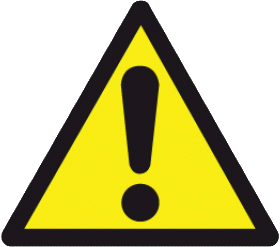
- Shaft Length Guidelines
- Compact and Lightweight
- Digital CD Ignition with Spark Advance
- High Grade Marine Alloy Construction
- Stainless Steel Water Pump Housing
- Zinc Coated Water Passages
- Rated for Saltwater Use
- Sacrificial Zinc Anodes and Trim Tab
- Tiller Integrated F-N-R Gear Shifting
- Adjustable Steering Tension Control
- Twist-Grip Throttle with Tension Control
- Thermostat Controlled Water Cooling
- Auto Ratchet Trim System (5 positions)
- Shallow Water Drive
- Quiet Through-Propeller-Hub Exhaust
- 3.2 Gallon Fuel Tank and Fuel Line
- Start-In-Gear Protection
- Low Oil Pressure Warning Indicator
- ESG Over-Rev Protection
- Safety Lanyard Stop Switch
- Owner's Manual
- Mercury Marine 3-Year Warranty
- Fuel Tank (3.2 gallon)
- Quick Connect Fuel Line
- Mercury 3-Year Warranty
- Aluminum Propeller
- Mercury 4-Stroke Oil
- Owner's Manual & Tool Kit

Related Products
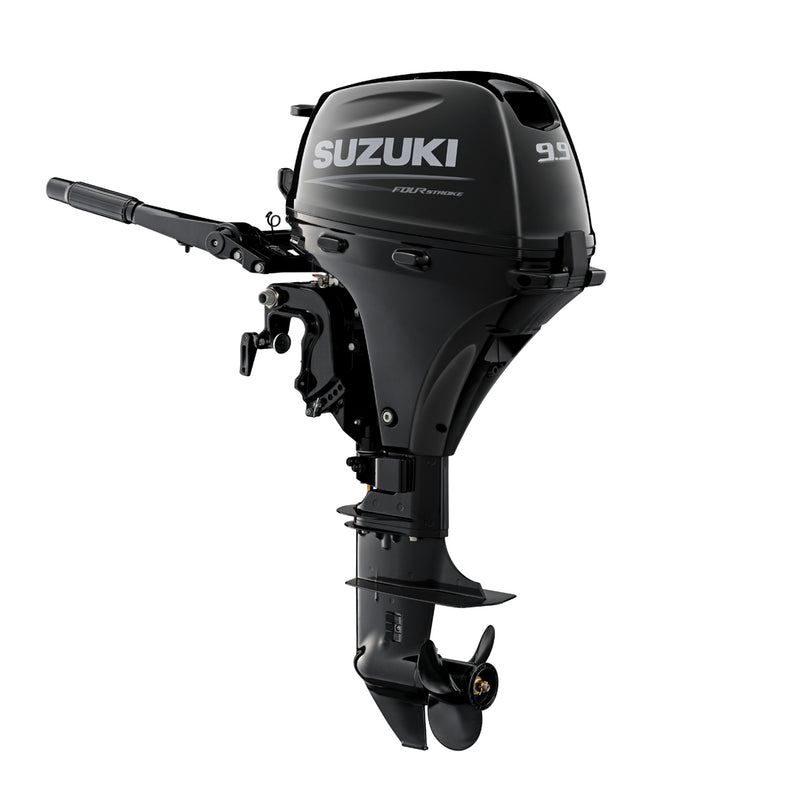
Suzuki 9.9 HP DF9.9BS5 Outboard Motor
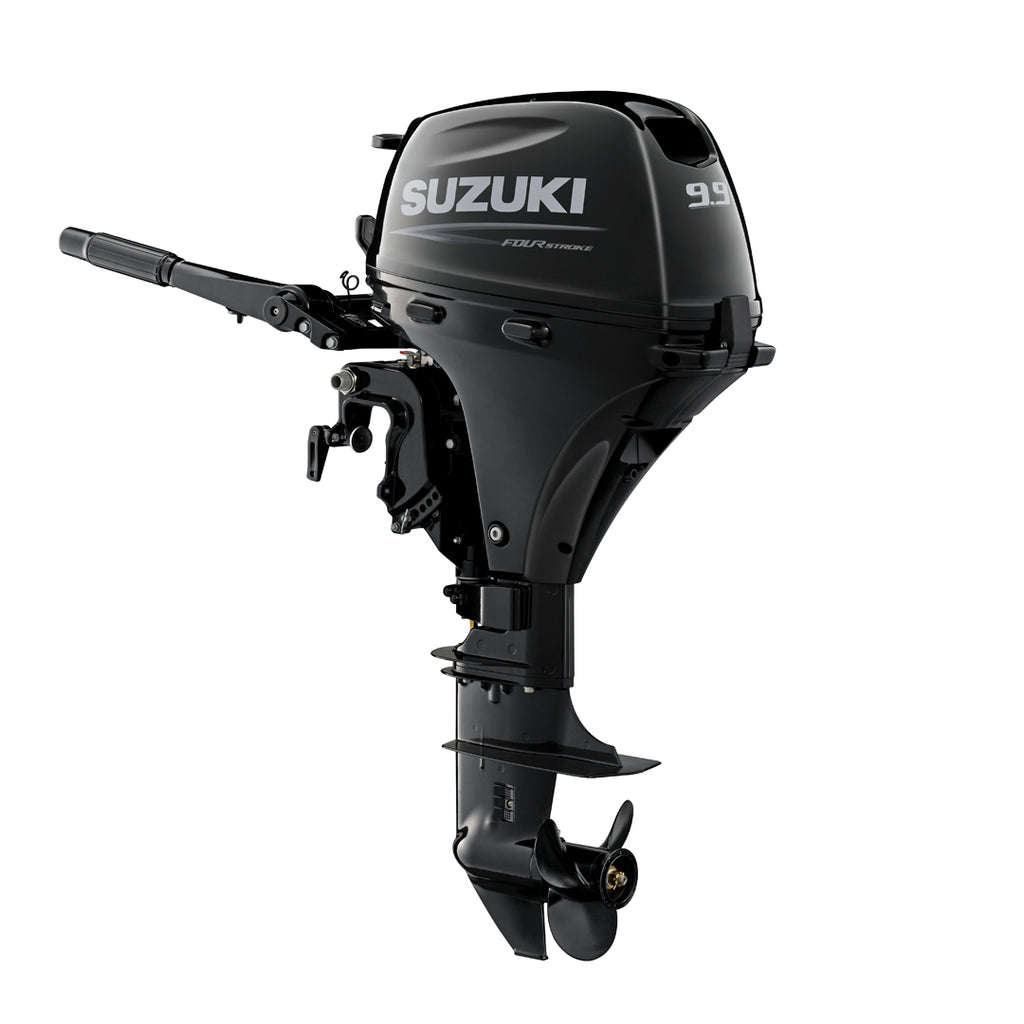
$2,120.00 $3,235.00
Suzuki's newest fuel efficient 9.9 hp EFI four-stroke model DF9.9BS5 is an excellent choice of power for medium to larger sized jon boats, skiffs, and inflatables. As one of the quietest 4-strokes ever built, the 9.9 hp is a great example of Suzuki's excellence in engineering with a manual start. Tiller steering adds versatility. Check out the ...
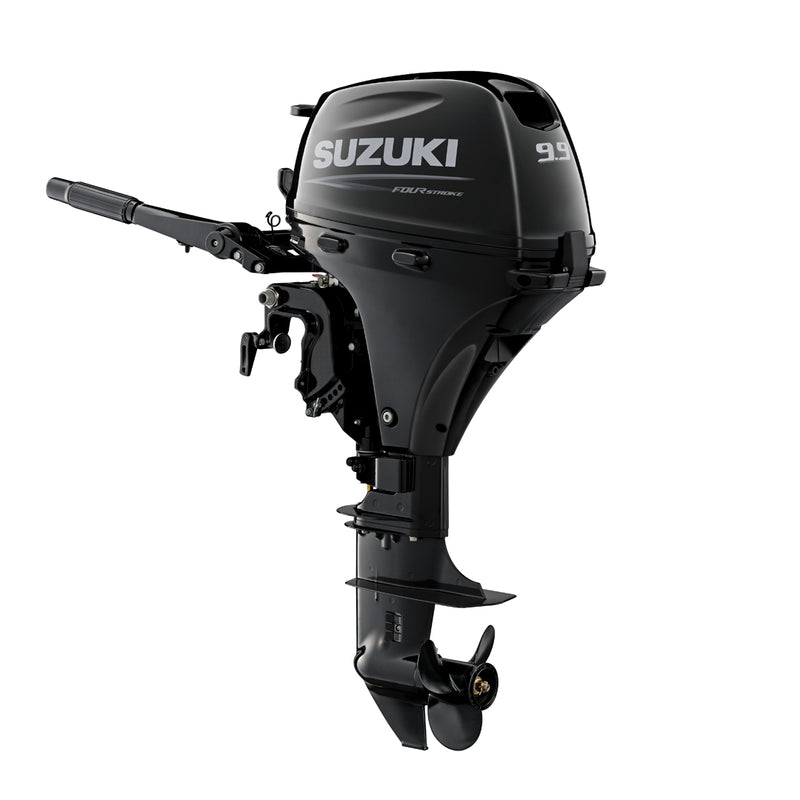
Suzuki 9.9 HP DF9.9BL5 Outboard Motor
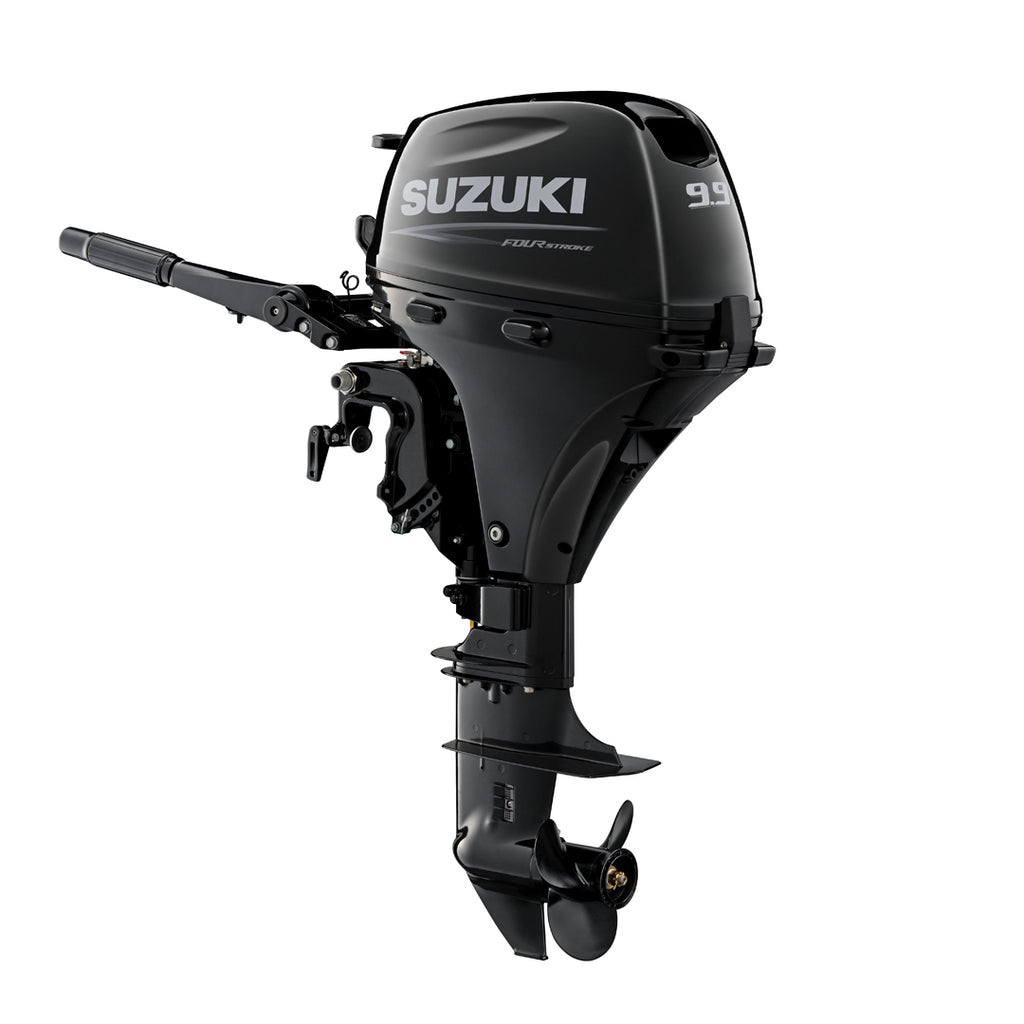
$2,150.00 $3,280.00
The all new 9.9 hp EFI model DF9.9BL5 is an excellent choice of power for medium to larger sized jon boats, skiffs, and inflatables. This model features the manual pull rope start, tiller steering, and a 20 inch long shaft. Check out the long list of standard features below which make the 9.9 hp Suzuki an exceptional value. We offer Suzuki's n...
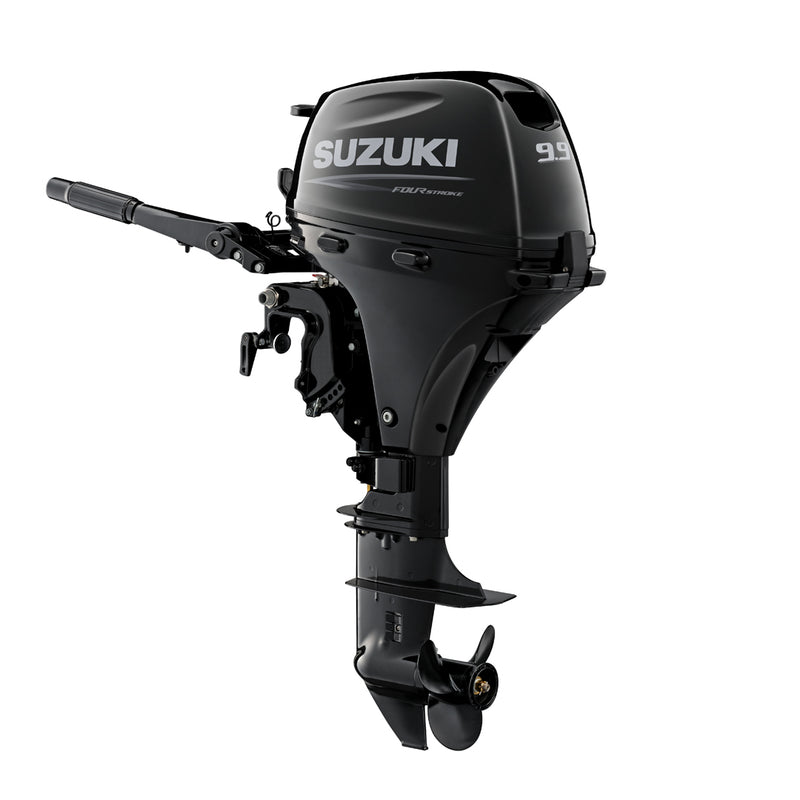
Suzuki 9.9 HP DF9.9BES5 Outboard Motor
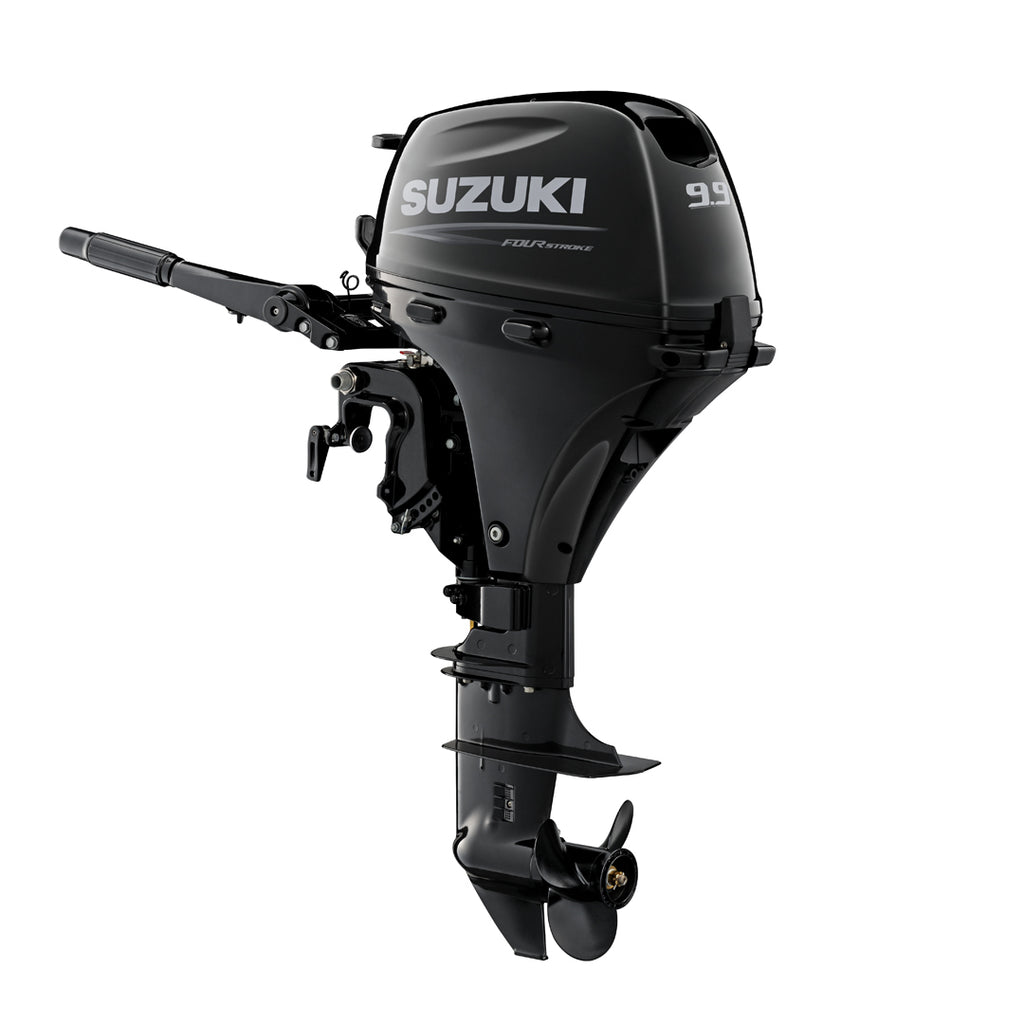
$2,290.00 $3,565.00
The all new 9.9 hp EFI model DF9.9BES5 is an excellent choice of power for medium to larger sized jon boats, skiffs, and inflatables. This model features push-button electric start with a built-in 12V charging system. Tiller steering adds versatility with a 15 inch shaft. Additionally, as with all portable Suzuki models 20 hp and below that fea...
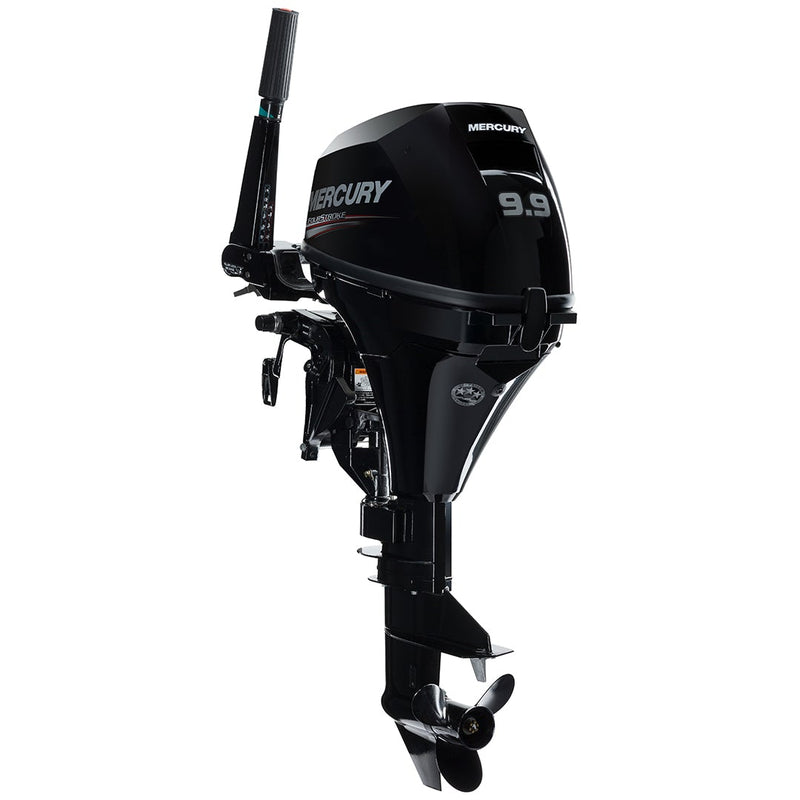
2024 Mercury 9.9 HP 9.9MH Outboard Motor
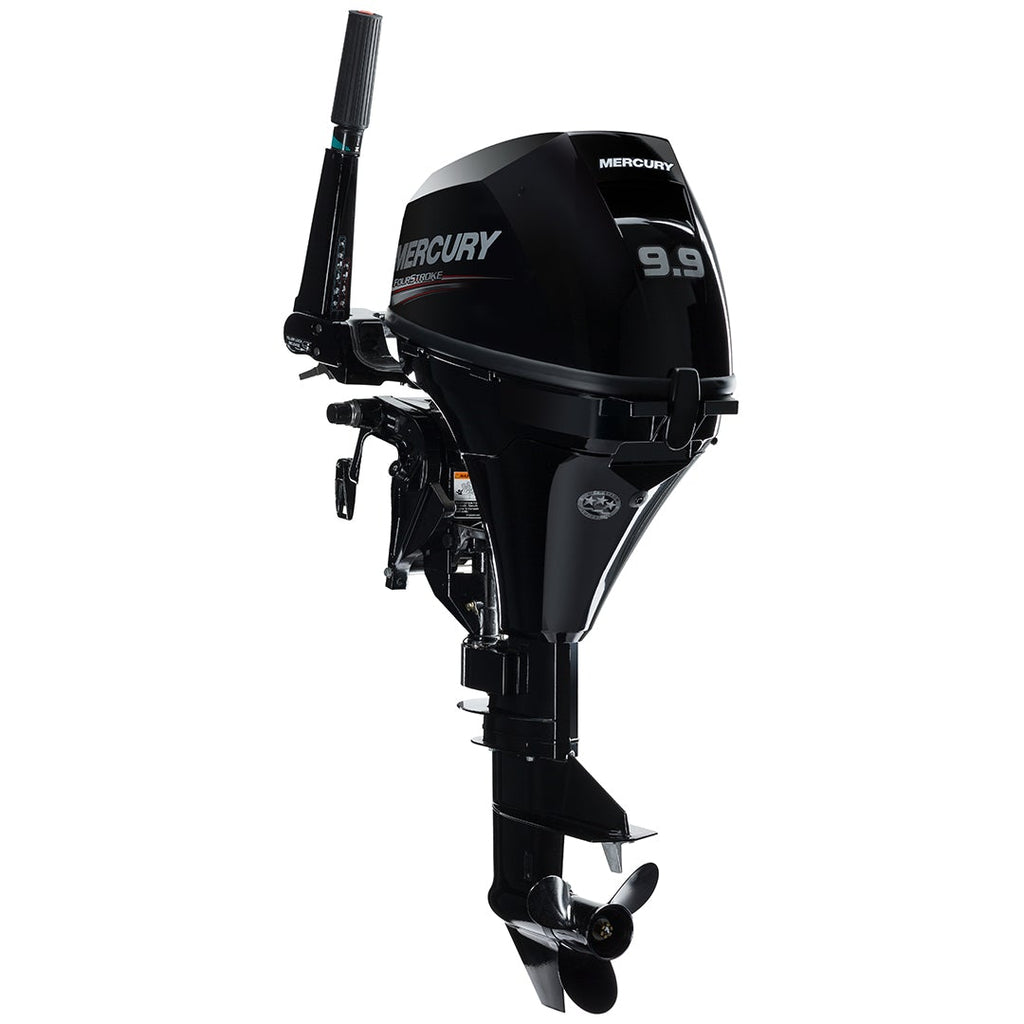
$2,299.00 $2,785.00
The portable Mercury 9.9hp outboard motor is lightweight, compact, and powerful making it a great choice for long shaft jon boats, skiffs, and small pontoons as well as auxiliary power for your sailboat. The Mercury 9.9 HP outboard engine is a two cylinder four-stroke marine engine that delivers smooth, quiet, fuel efficient power. Weighing 84 l...
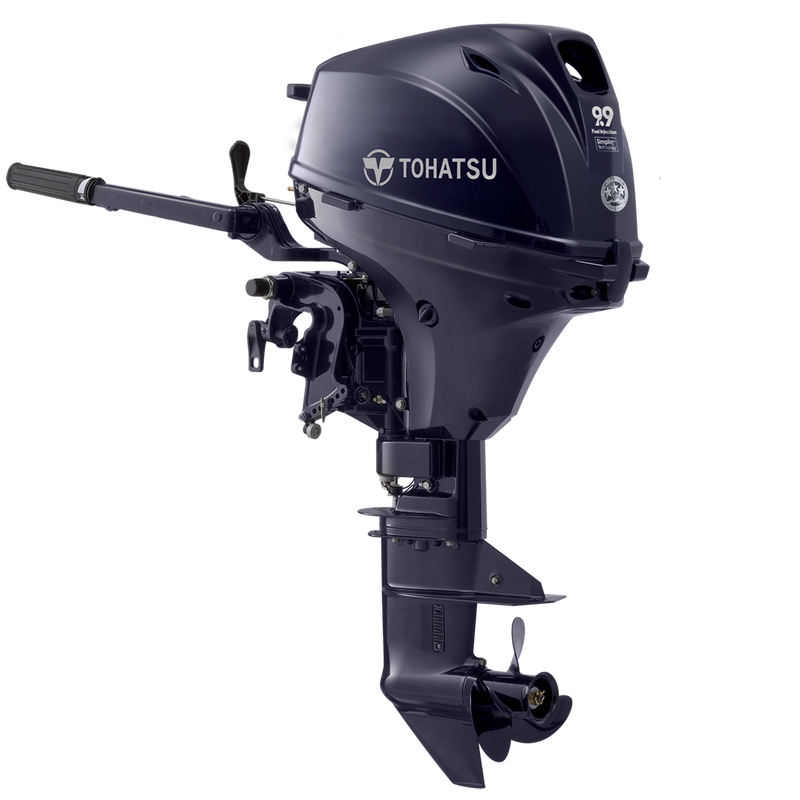
OVERSTOCK, BRAND NEW 2023 Tohatsu 9.9 HP MFS9.9EL Outboard Motor
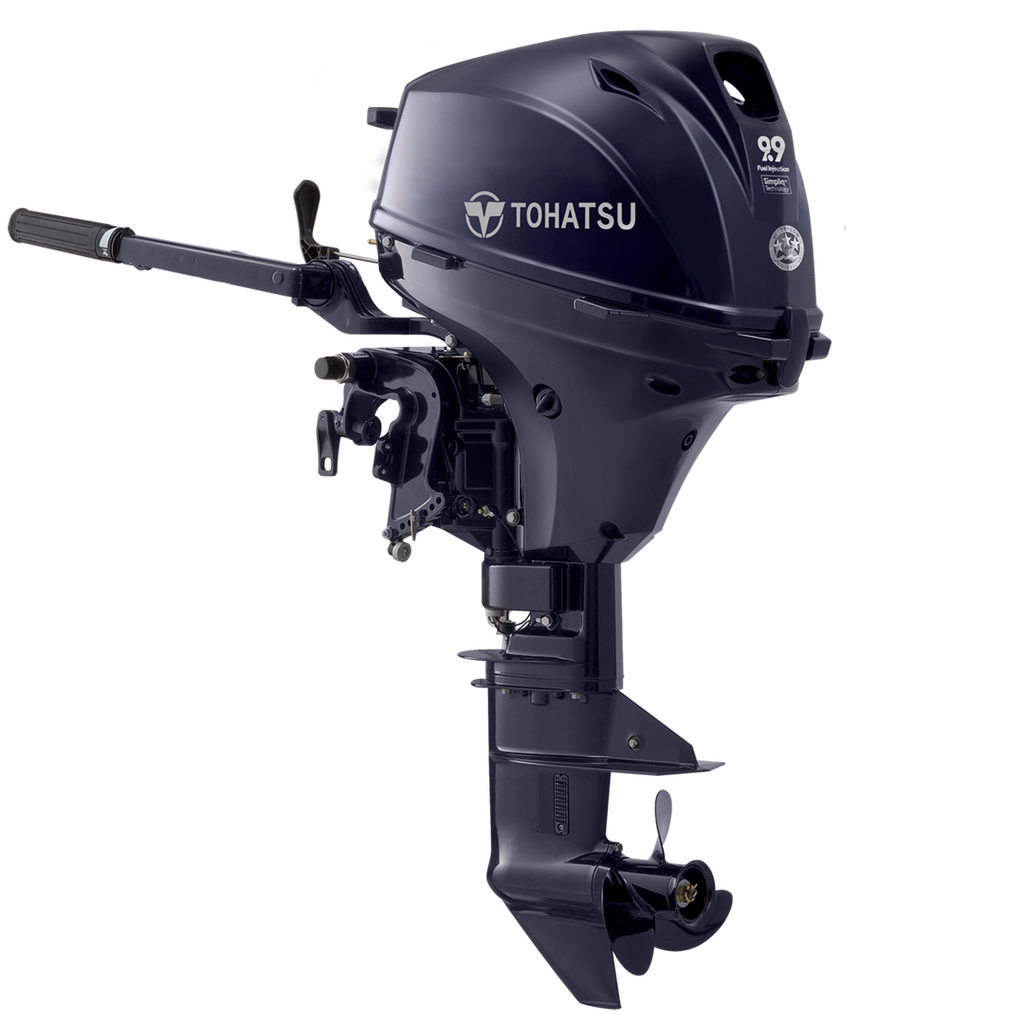
$2,299.00 $3,031.00
BRAND NEW, WITH FULL TOHATSU 5 YEAR WARRANTY. As an authorized Tohatsu outboard motor dealer we are proud to offer the Tohatsu 9.9 HP EFI outboard, model MFS9.9EL. This Tohatsu outboard delivers the big power you want, but does so in an affordable, compact portable package. This outboard comes equipped with a 20 inch shaft, with a manual rope p...
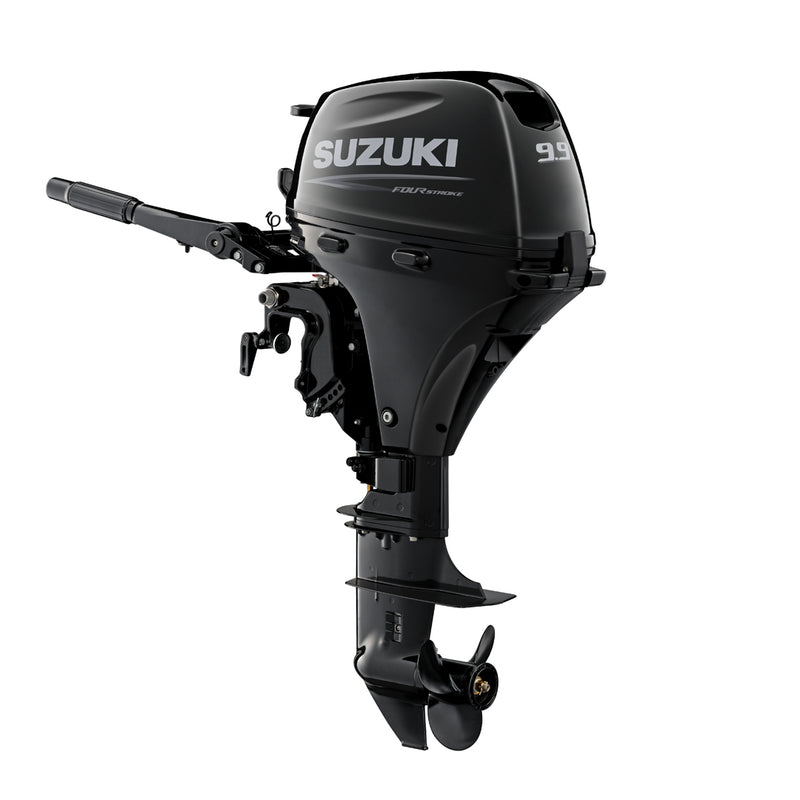
Suzuki 9.9 HP DF9.9BEL5 Outboard Motor
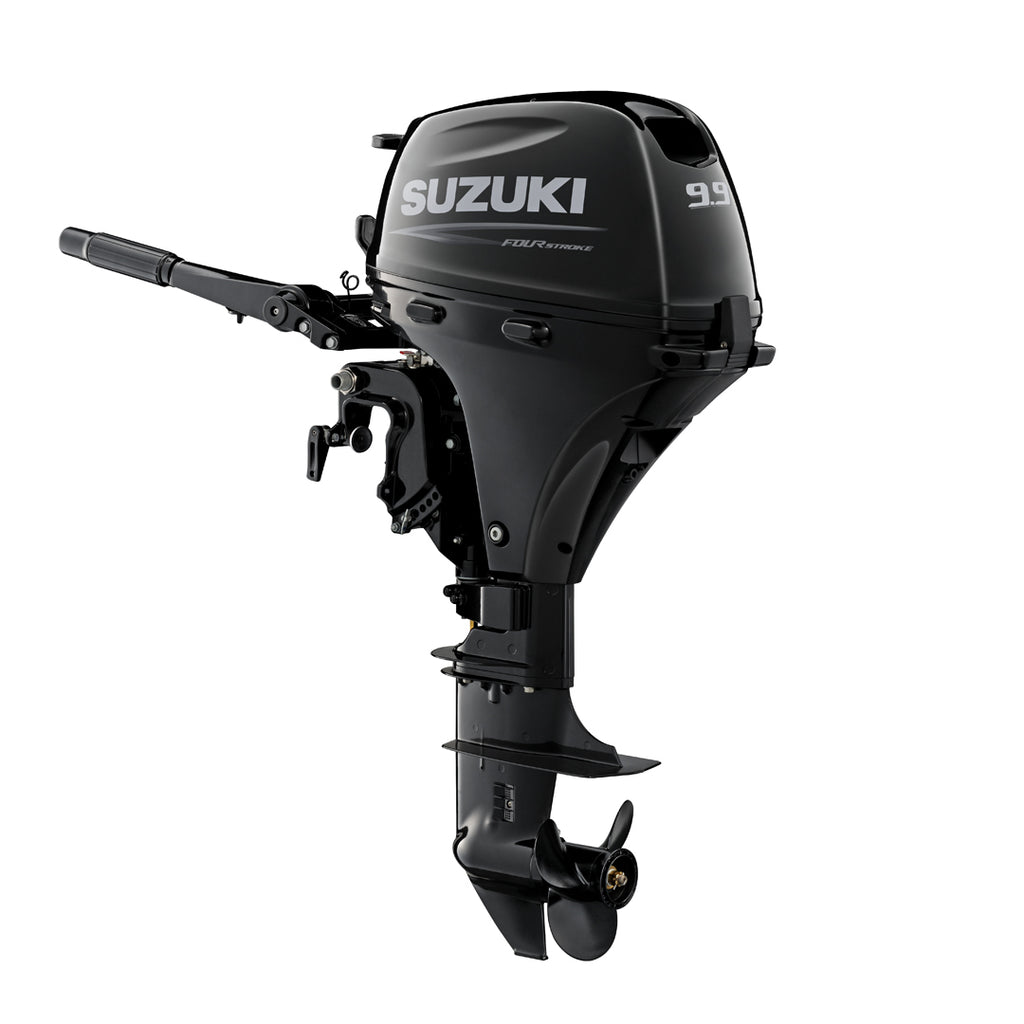
$2,320.00 $3,610.00
The all new 9.9 hp EFI DF9.9BEL5 is an excellent choice of power for medium to larger sized jon boats, skiffs, and inflatables. This model features push-button electric start with a built-in 12V charging system. Additionally, as with all portable Suzuki models 20 hp and below that feature electric start, the thru-cowl manual start pull cord is ...
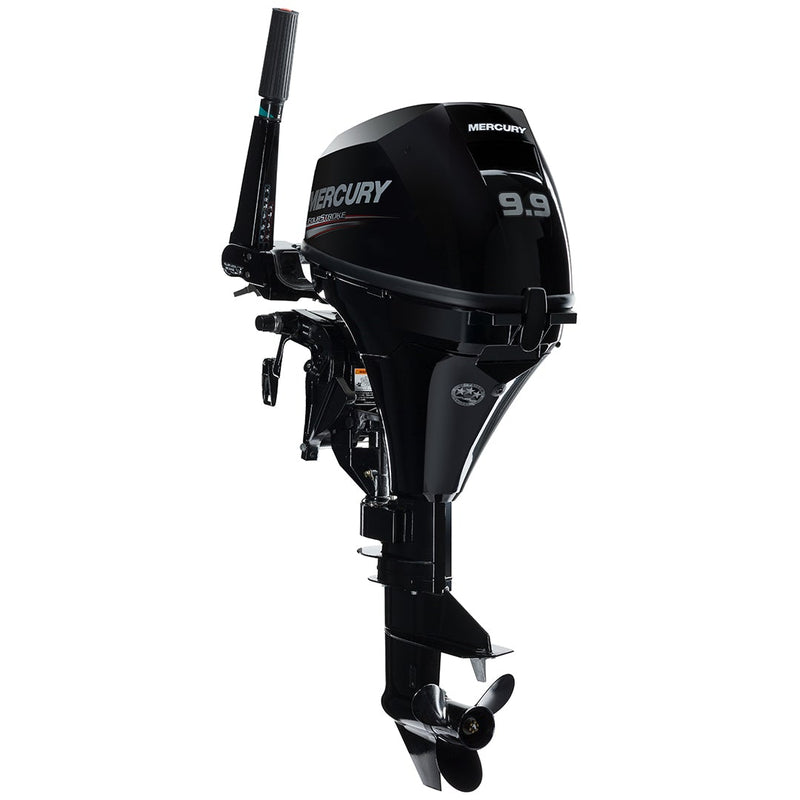
2024 Mercury 9.9 HP 9.9MLH Outboard Motor
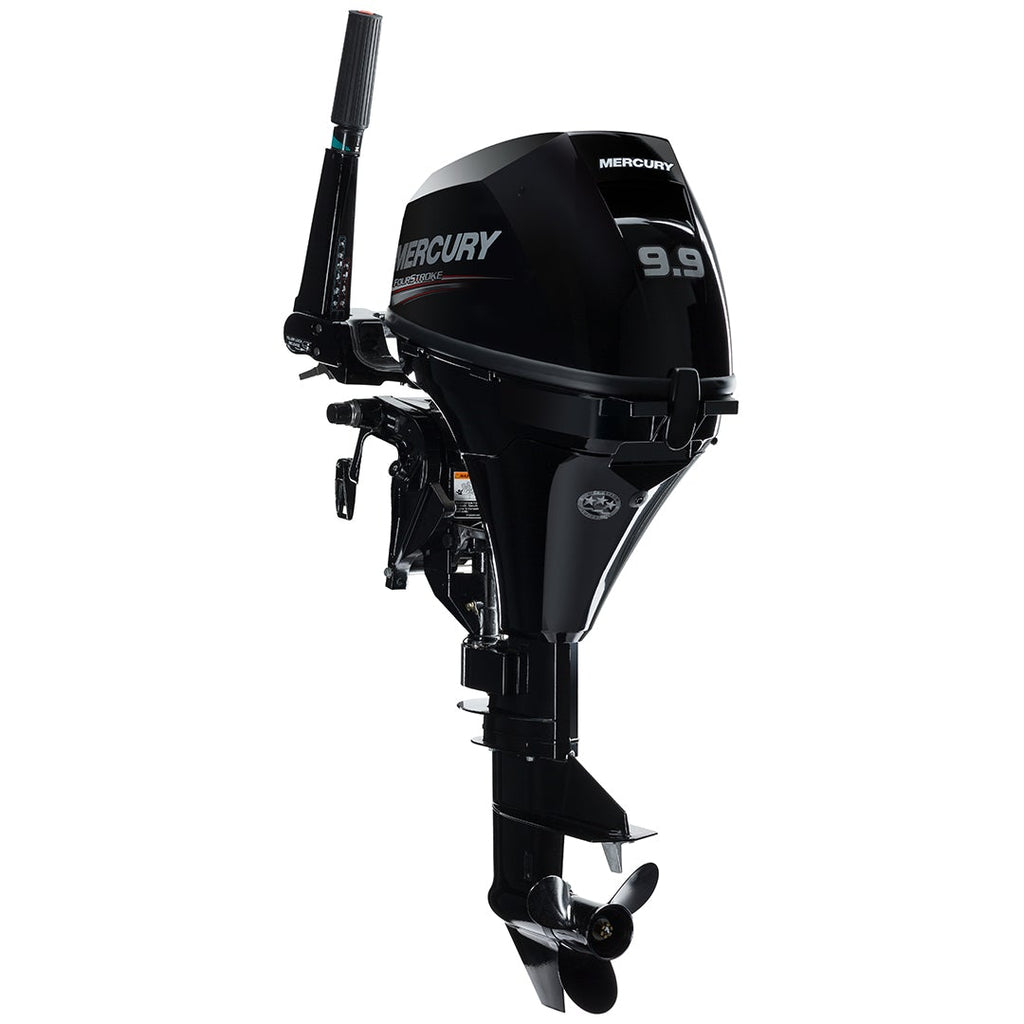
The Mercury 9.9hp Model # 9.9MLH outboard motor is lightweight, compact, powerful, and portable making it the perfect outboard for skiffs and small pontoons. The Mercury 9.9 HP outboard engine is a two cylinder four-stroke marine engine that delivers the fuel efficiency and smooth quiet ride Mercury outboards are known for. This 84 lb. Mercury 9...
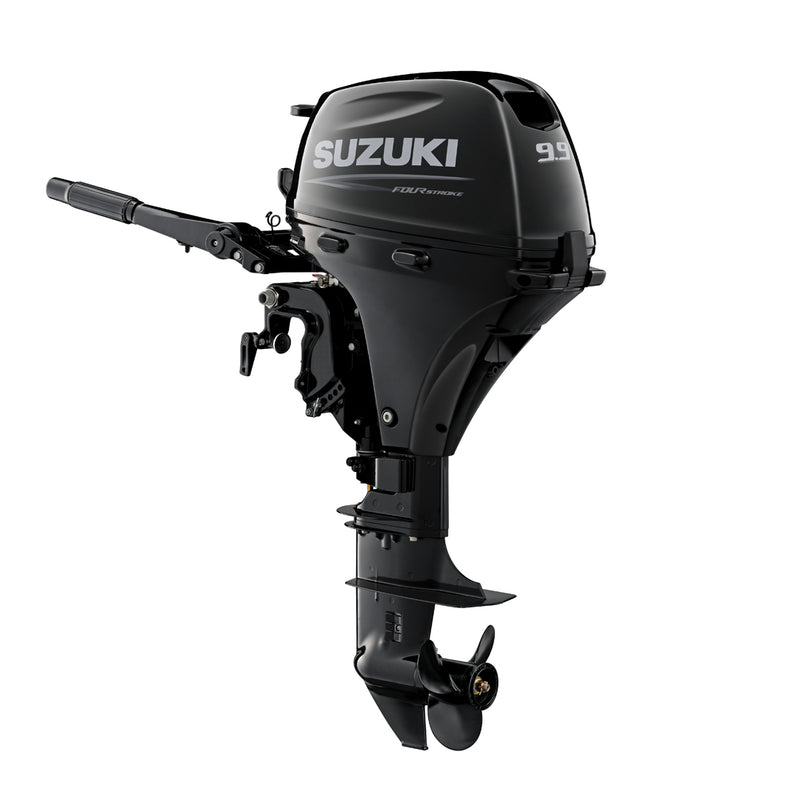
Suzuki 9.9 HP DF9.9BTHS5 Outboard Motor
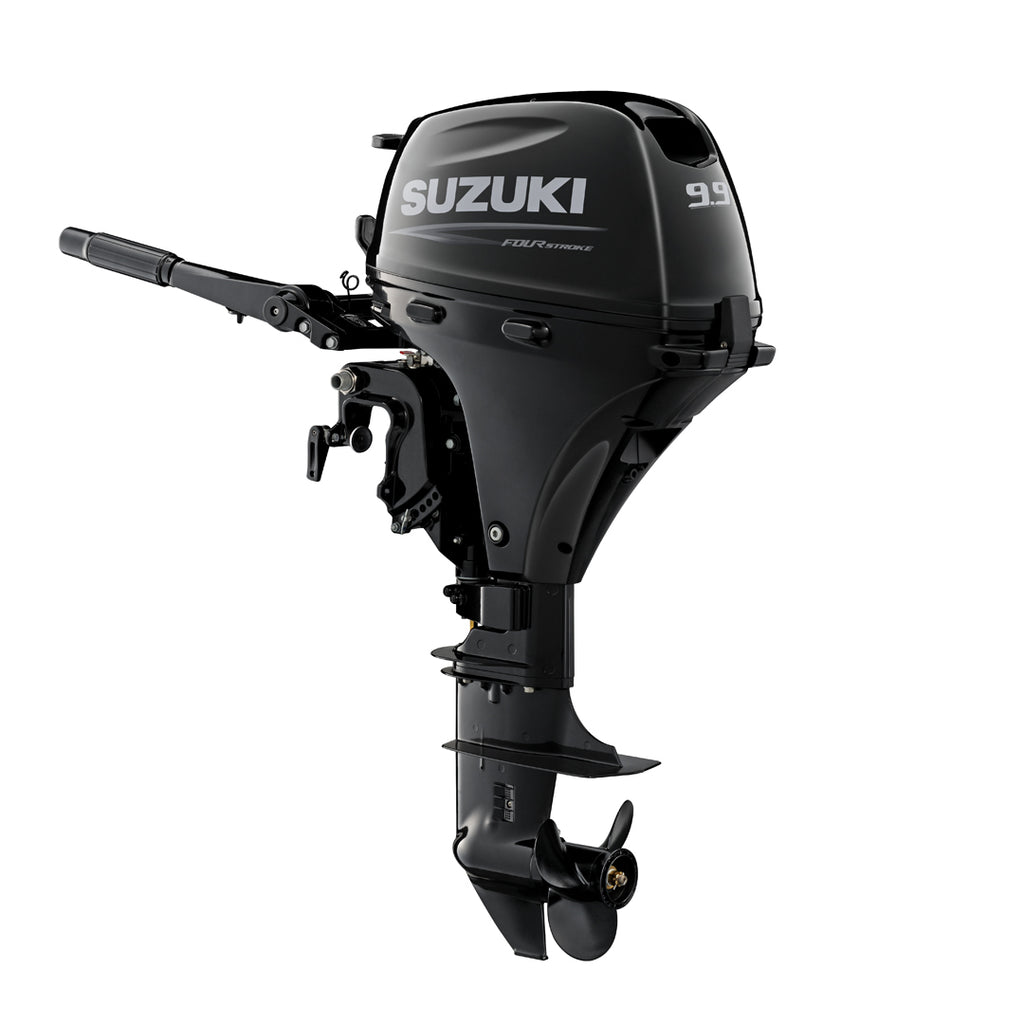
$2,410.00 $3,790.00
The all new Suzuki 9.9 HP EFI outboard motor model DF9.9BTHS5 is a 15 inch short shaft with electric start, power tilt and electronic fuel injection. The Suzuki 9.9 HP outboard engine is lightweight, compact and fuel efficient at 120 lbs. This 2-cylinder 4-stroke is remarkably smooth and quiet. The Suzuki 9.9hp outboard is an excellent choice f...
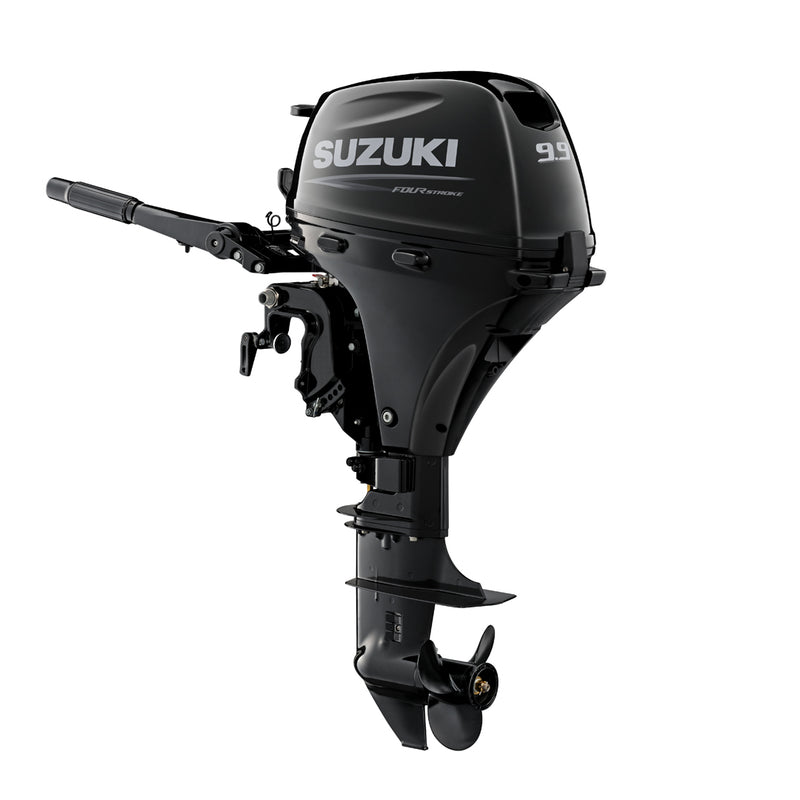
Suzuki 9.9 HP DF9.9BTHL5 Outboard Motor
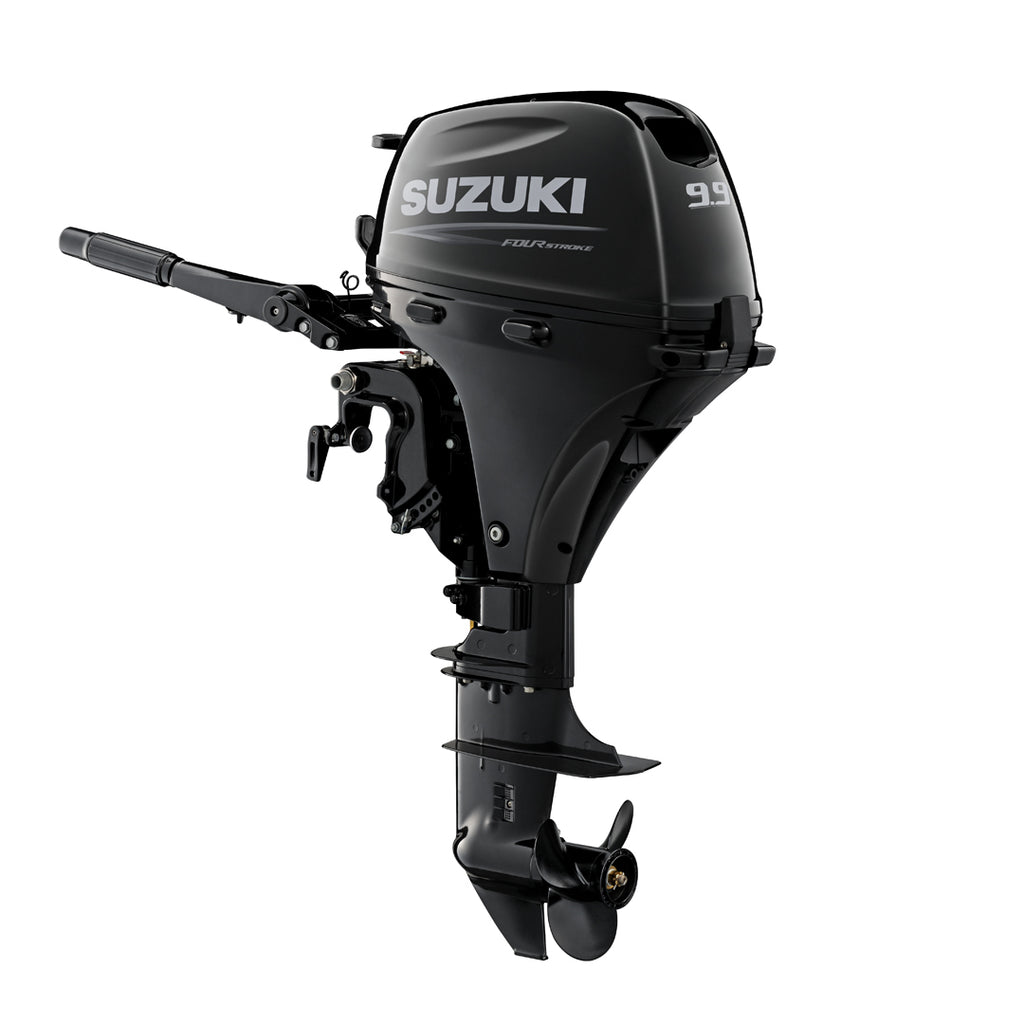
$2,440.00 $3,845.00
The all new Suzuki 9.9 HP EFI outboard motor model DF9.9BTHL5 is a 20 inch long shaft with electric start and power tilt. The Suzuki 9.9 HP outboard engine is lightweight, compact and fuel efficient. This 2-cylinder 4-stroke is remarkably smooth and quiet. The Suzuki 9.9hp outboard is an excellent choice for long shaft jon boats and skiffs, as ...
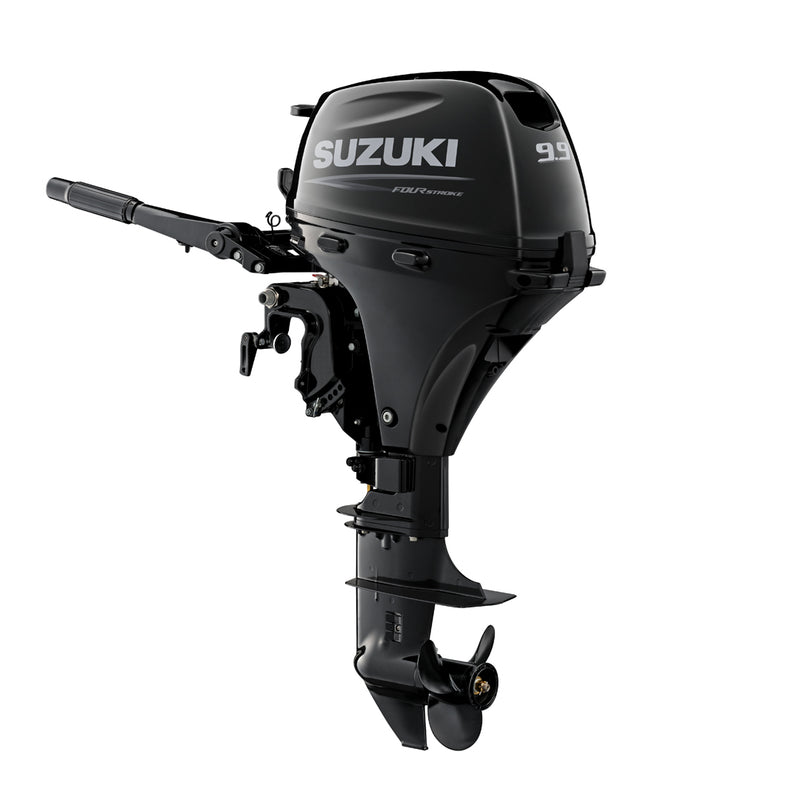
Suzuki 9.9 HP DF9.9BTHX5 Outboard Motor
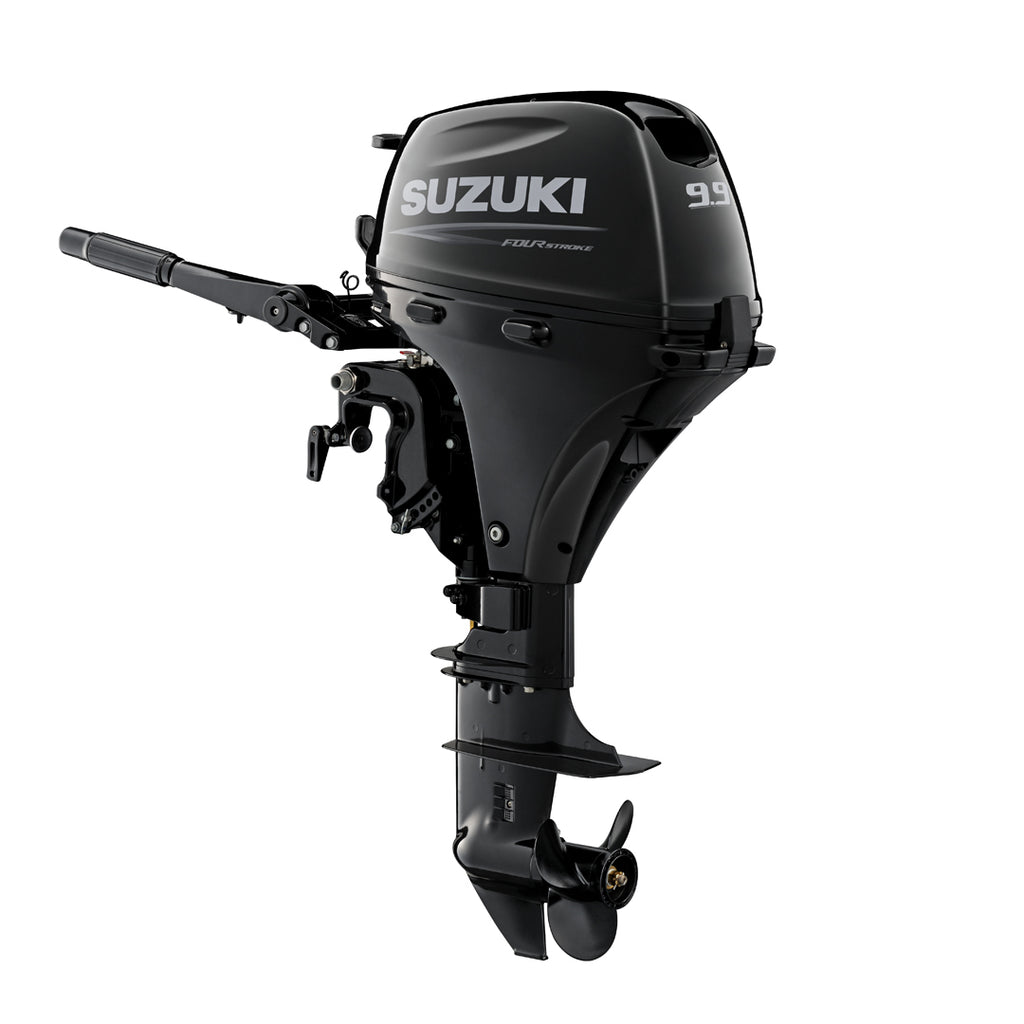
$2,460.00 $3,895.00
The all new Suzuki 9.9 HP EFI outboard motor model DF9.9BTHX5 is a 25 inch extra long shaft with electric start and power tilt. The 128 lb. Suzuki 9.9 HP outboard engine is lightweight, compact and fuel efficient. This 2-cylinder 4-stroke is remarkably smooth and quiet. The Suzuki 9.9hp outboard is an excellent choice for skiffs, as well auxili...
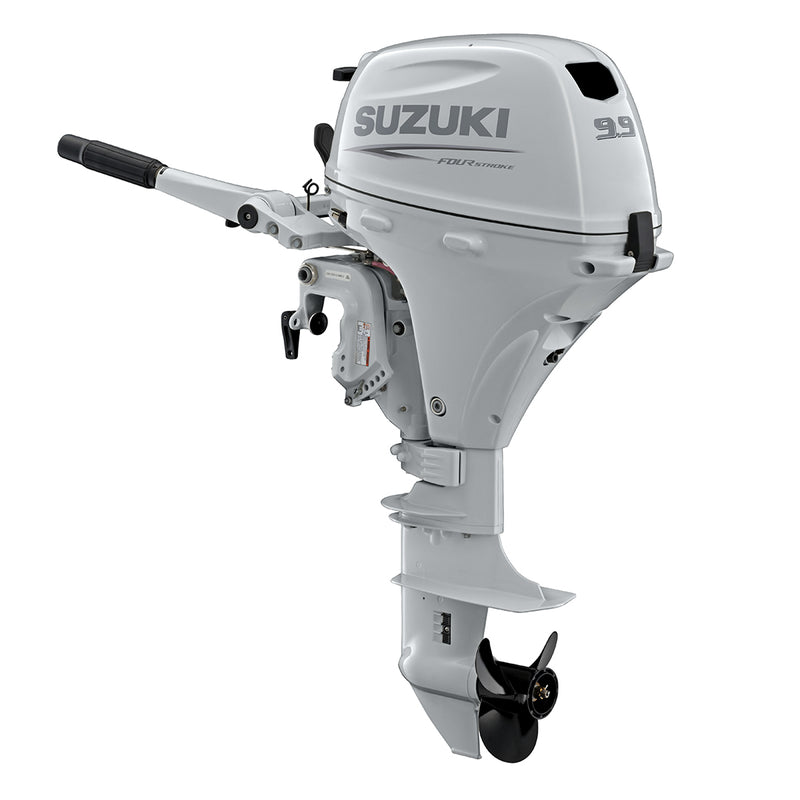
Suzuki 9.9 HP DF9.9BTHLW5 Outboard Motor
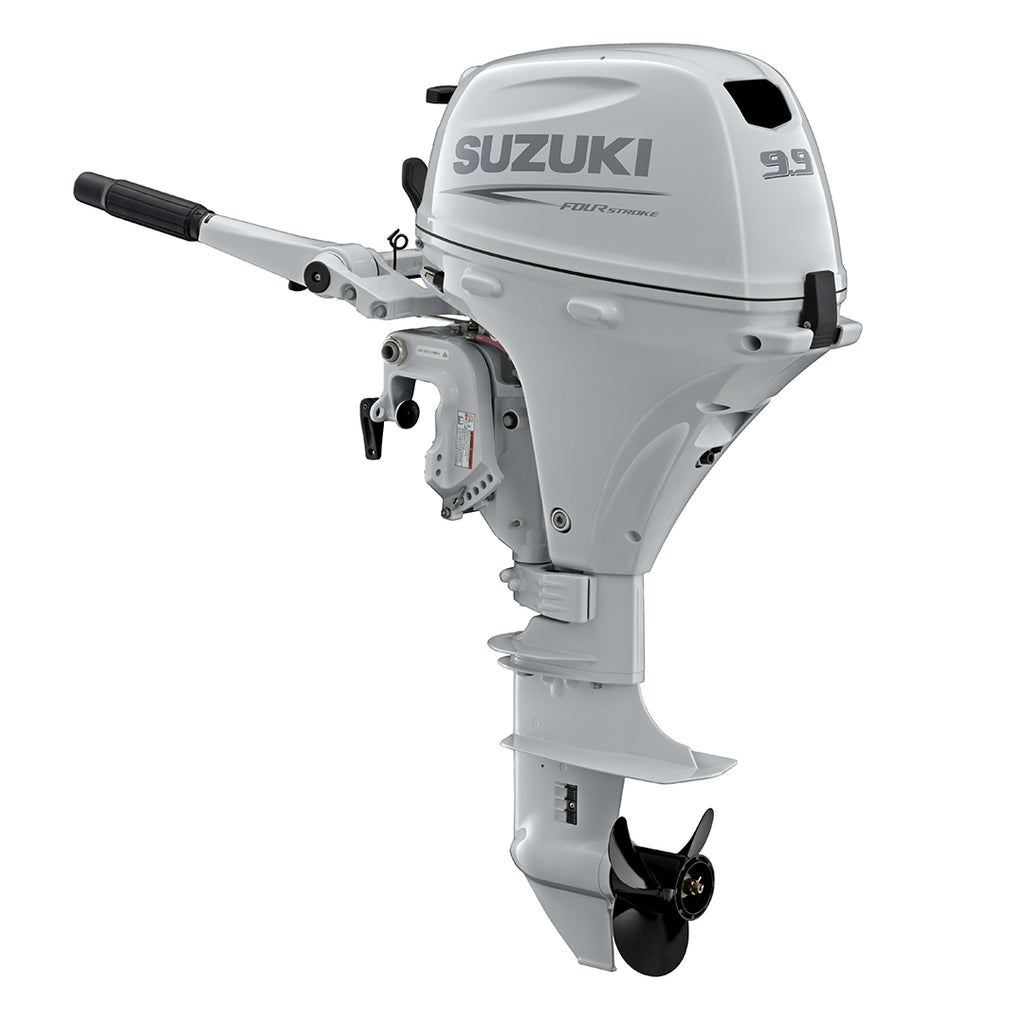
$2,490.00 $3,955.00
The all new Super Cool White Suzuki 9.9 HP EFI outboard motor model DF9.9BTHLW5 is a 20 inch long shaft with electric start, power tilt and electronic fuel injection. The Suzuki 9.9 HP outboard engine is lightweight, compact and fuel efficient. This 2-cylinder 4-stroke is remarkably smooth and quiet. The Suzuki 9.9hp outboard is an excellent c...
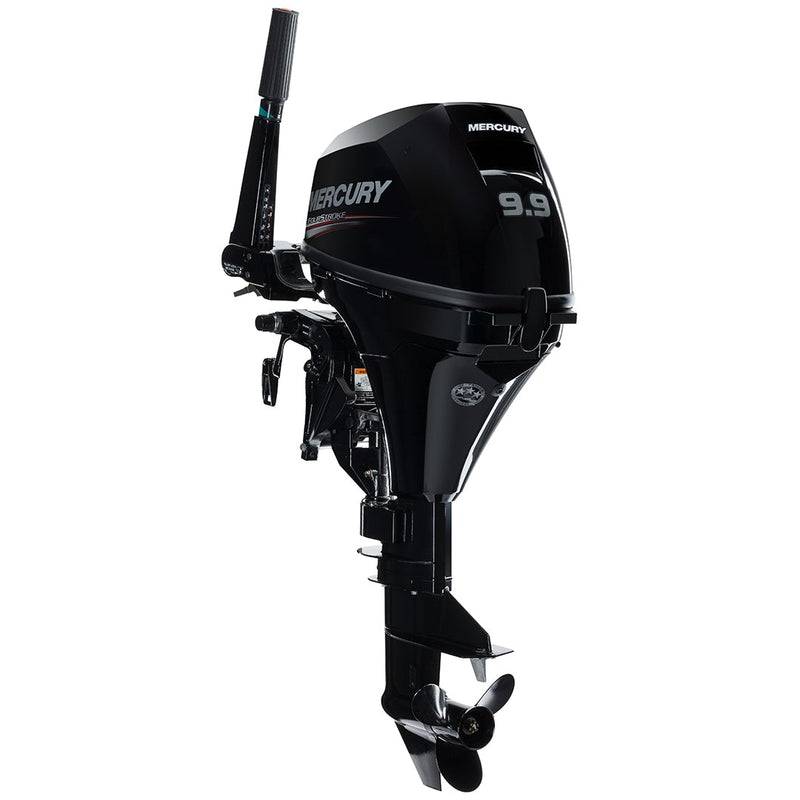
2024 Mercury 9.9 HP 9.9MLH-CT Outboard Motor
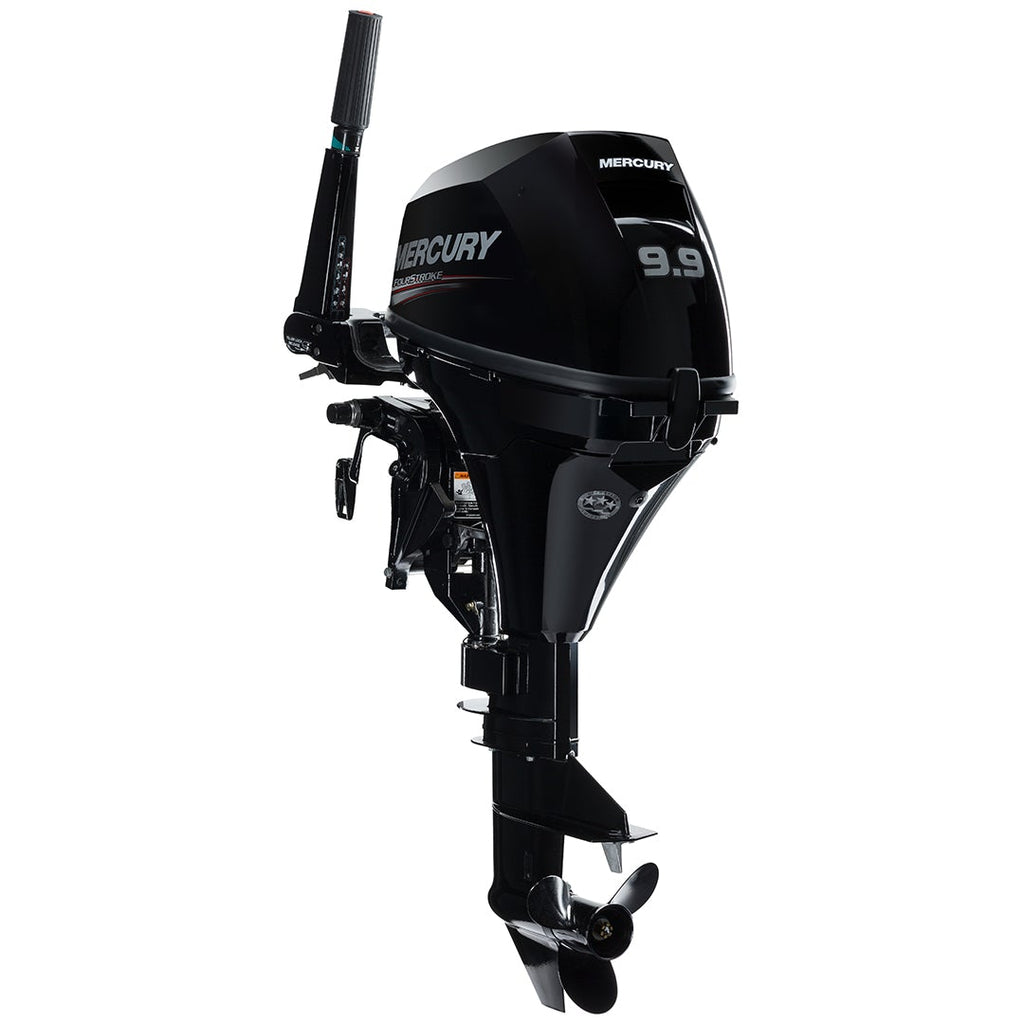
$2,499.00 $2,960.00
The affordable, portable Mercury 9.9 HP Outboard motor with Command Thrust delivers power, thrust, and control that wider, heavier boats need. A larger prop increases control and a taller gear case puts the propeller deeper below turbulent water for improved power. The Mercury 9.9 outboard engine is the right choice for sailboat and kicker appli...
Quick Links
Support & help.
- Products FAQ
- Takacat Catamaran FAQ
- Privacy Policy
- Terms and Conditions
- Licensed Outboard Dealer
- Affirm - By Now, Pay Later
Our Companies
- Cumberland Watersports
- Suzuki Outboard Team
- Honda Outboard Motors
- Mercury Outboard Motors
- Suzuki Outboard Motors
- Tohatsu Outboard Motors
Sign Up For Deals

- 2024 BOAT BUYERS GUIDE
- Email Newsletters
- Boat of the Year
- 2024 Freshwater Boat and Gear Buyers Guide
- 2024 Boat Buyers Guide
- 2024 Water Sports Boat Buyers Guide
- 2023 Pontoon Boat Buyers Guide
- Cruising Boats
- Pontoon Boats
- Fishing Boats
- Personal Watercraft
- Water Sports
- Boat Walkthroughs
- What To Look For
- Best Marine Electronics & Technology
- Watersports Favorites Spring 2022
- Boating Lab
- Boating Safety

Best Outboard Motors
- By Jim Hendricks
- Updated: June 4, 2021
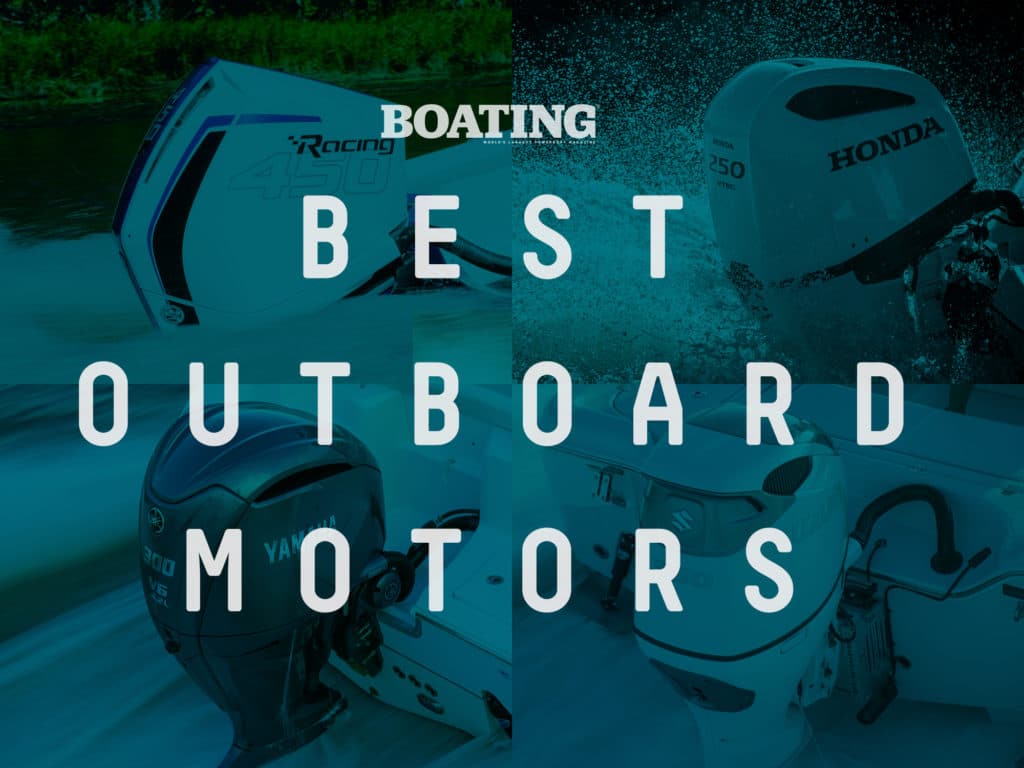
Outboard motors dominate today’s boating market. And with good reason. Today’s outboards are powerful, quiet, reliable, easy to service, and offer excellent power-to-weight ratios, as well as outstanding corrosion resistance. American boaters can choose from more than 180 models (not counting shaft length variants), all four strokes, from manufacturers such as Honda Marine, Mercury Marine, Suzuki Marine, Yamaha Outboards, and others, many in a choice of colors.
Horsepower ratings range from 2.3 to a whopping 600 ponies. Advanced technology abounds, with many models featuring electronic throttle and shift, electric steering, digital integration with your marine electronics , wireless connections to apps that let you view key functions, and more. While many boaters might narrow their search to the best outboard motor for the money, we instead built this list to showcase the best outboards available.
If you own an outboard motor, then you probably already know what you like in terms of brand and horsepower. But, on the other hand, you might be interested to learn about other great outboard motors, in case you buy a second boat or want to repower with the latest outboard technology. With this in mind, we looked at three outboard categories—portables, midsize and big outboards—and highlighted models from the major outboard brands that reflect some of the most notable and innovative engineering and features in each class.
Choosing an outboard motor for your boat is an important decision. Here, then, are 15 of today’s best outboard motors, ordered by horsepower from low to high, defaulting to alphabetical order for like power ratings.
Portable Outboard Motors
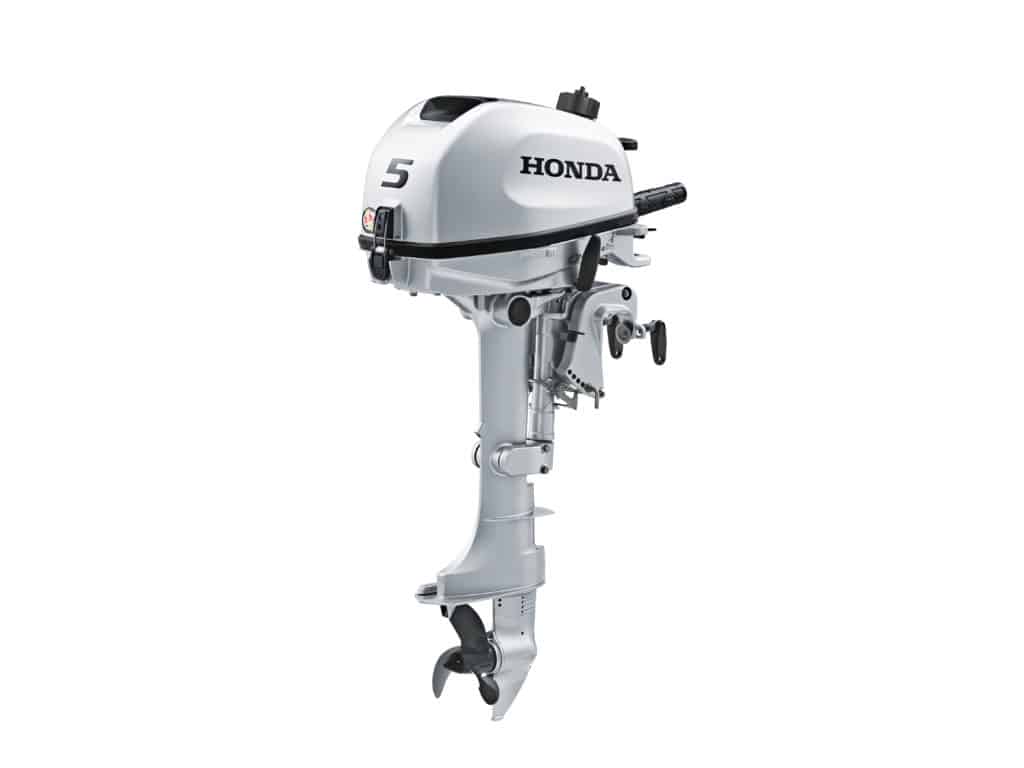
Honda Marine BF5
Portability, performance and reliability are the hallmarks of the Honda Marine BF5 tiller-steer outboard model, a motor that’s ideal for small boats and dinghies. The BF5 is equipped with a 0.4-gallon internal fuel tank, the largest in its class. This single cylinder outboard is also easy to pull-start, thanks to a decompression system that bleeds off cylinder pressure to reduce the pulling force. Weighing about 60 pounds, the BF5 is equipped with a 127cc overhead-cam engine that features an Oil Alert system that indicates any drop in oil pressure, automatically limiting the engine speed to 2,300 rpm. The Honda BF5 is available with an optional charging system with a capacity of 6 amps at 12 volts to power electronic devices on board.
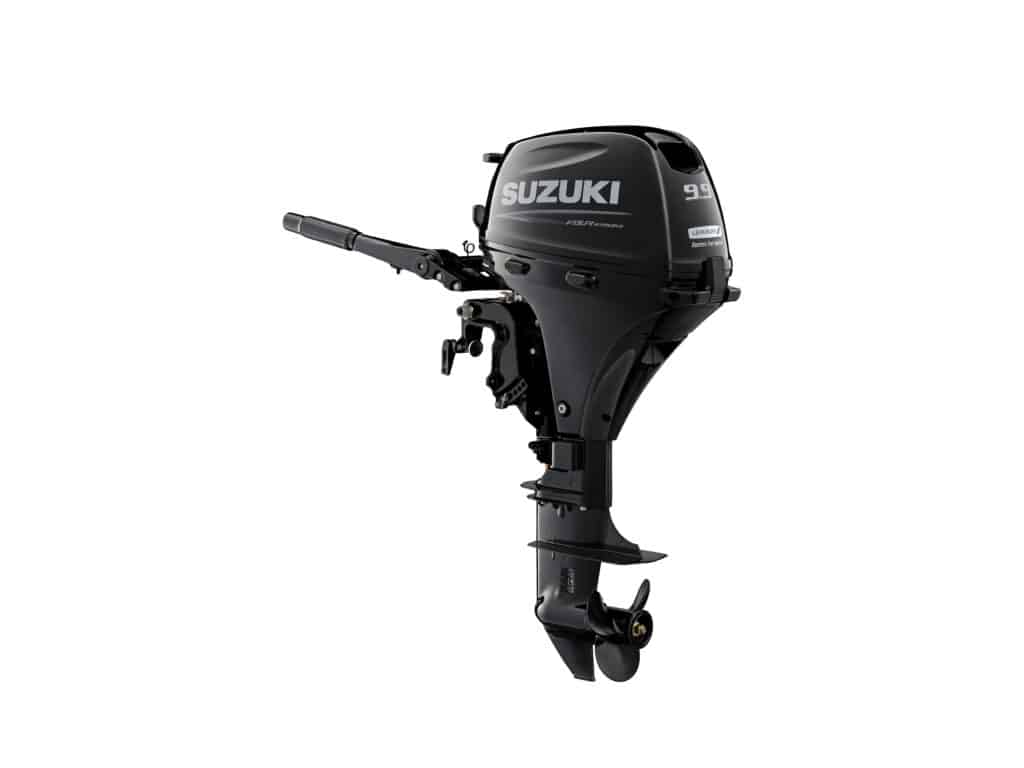
Suzuki Marine DF9.9B
This portable outboard is the only motor in its class with electronic fuel injection for easy starting, strong acceleration and smooth operation at all engine speeds. Even more impressive is that Suzuki DF9.9B’s EFI system does not require a battery. The two-cylinder 327cc overhead-cam engine also features Suzuki’s proven Lean Burn Control System for outstanding fuel efficiency from low idle speeds well up into the cruising range. Weighing 108 pounds (20-inch model), this motor is available with electric or manual start with a decompression system for easy pull-starts. Suzuki’s class-leading 327cc displacement delivers plenty of torque for pushing inflatables, small fishing boats and more. Power tilt and trim is optional.
Yamaha Outboards High-Thrust T9.9
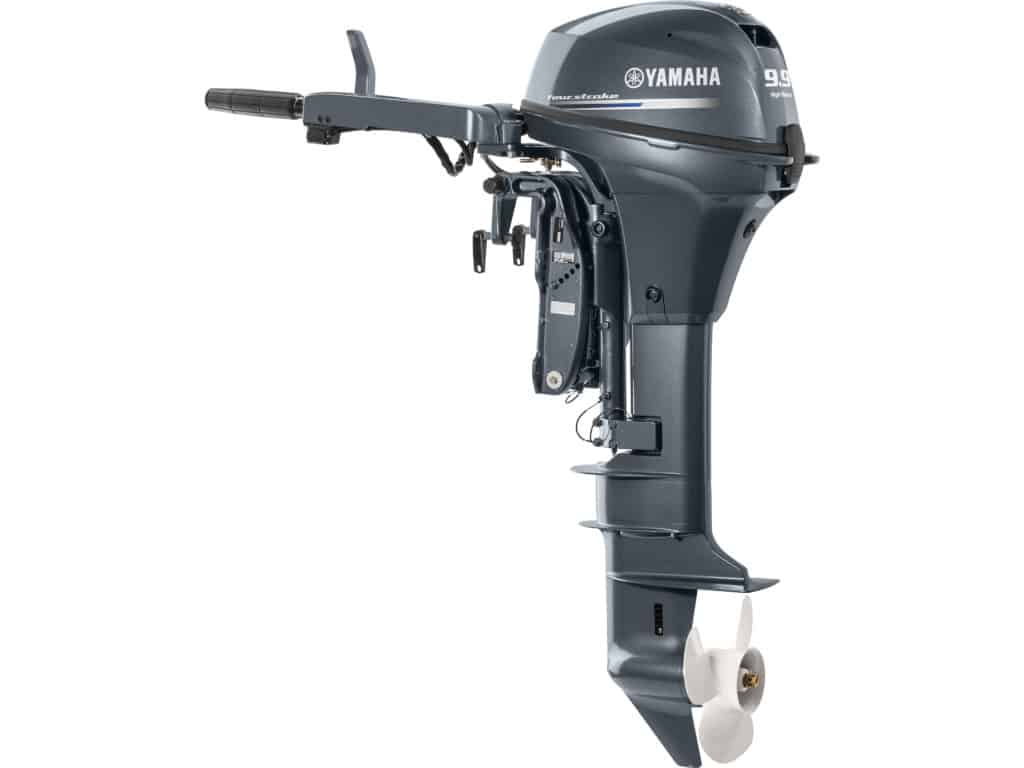
The Yamaha T9.9 is one of today’s smallest and lightest high-thrust 9.9 hp outboard motors and serves a perfect kicker outboard for a variety of boats. Weighing 102 pounds (20-inch model), the T9.9′s 212cc, two-cylinder, overhead-cam engine provides smooth, reliable power and torque with outstanding fuel efficiency. Yamaha’s patented dual-thrust propeller offers robust forward and reverse thrust. Shallow Water Drive System or Power Tilt allows the operator to raise the outboard during low-speed operation or fully tilt the outboard up. A freshwater flushing device at the front of the outboard allows for easy maintenance and increased longevity. Resting pads enhance storage capability.
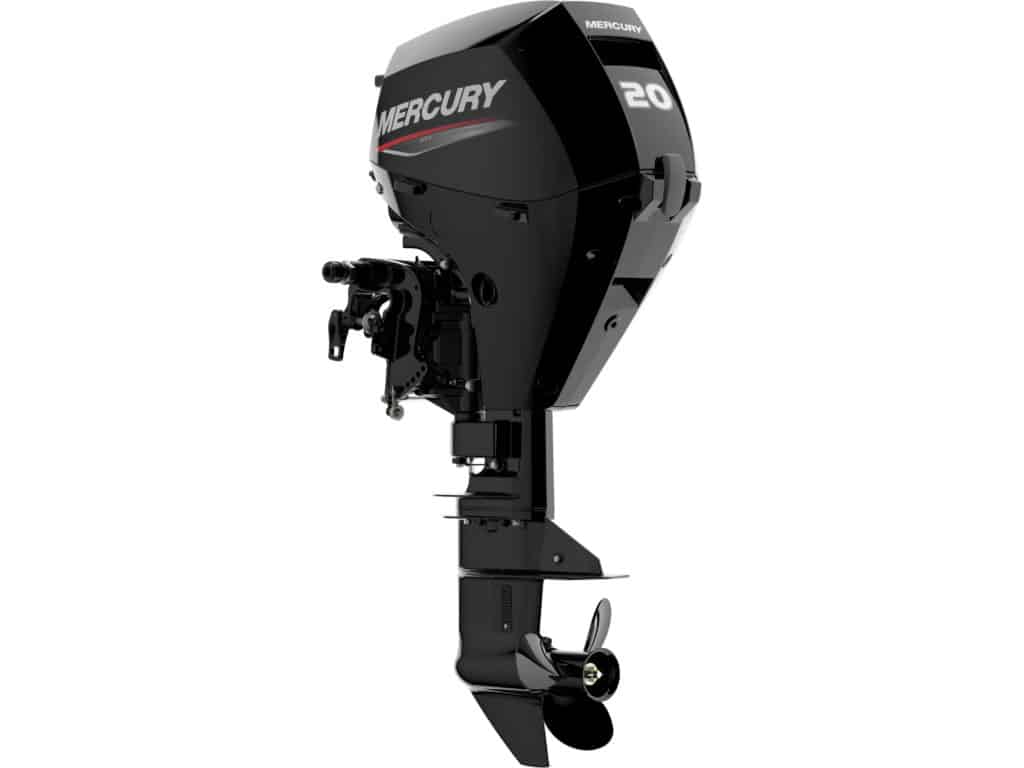
Mercury Marine 20 EFI FourStroke
Designed for anglers, recreational boaters and commercial operators, the Mercury 20 hp FourStroke features battery-free electronic fuel injection for reliable starting, instant throttle response, strong performance and superb fuel efficiency. Weighing in at 99 pounds, this outboard model is among the lightest in its class. Available with electric start, this engine is designed with ease of maintenance, featuring a clean, no-drip, no-spill oil-drain system. The 20 hp EFI FourStroke features an award-winning multi-function tiller handle, offering ambidextrous operation. Its vertical down-stop is adjustable to accommodate specific boat layouts and transoms.
Midsize Outboard Motors
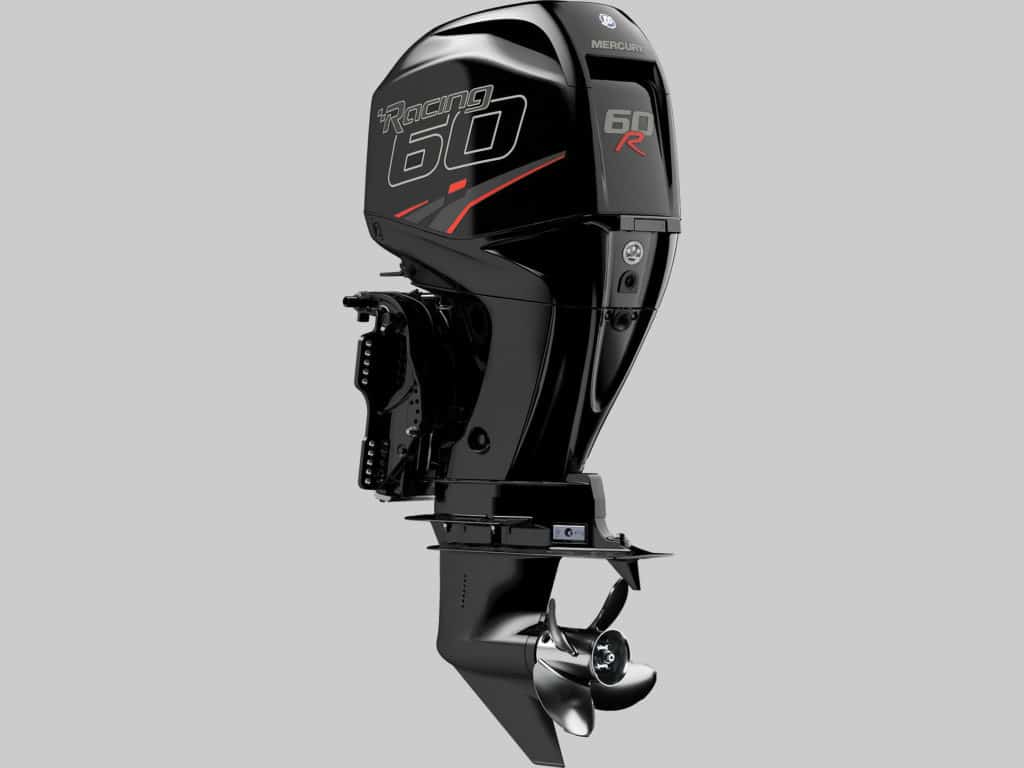
Mercury Racing 60R
The only outboard motor in its class available as a 15-inch model, the Mercury Racing 60R fits perfectly on the transom of flats skiffs and other small high-performance boats. Featuring a high-thrust gearcase, this outboard motor is geared to deliver strong hole-shot for jumping on plane in shallow water. The smallest outboard motor in the Mercury Racing line, it features a four-cylinder, 1.0-liter long-stroke powerhead tuned for torque. Wide-open throttle range is extended to 6,300 rpm to maximize acceleration and enable more propping options. Weighing in at 268 pounds, it can accommodate a lower poling platform while eliminating the need for a jack plate
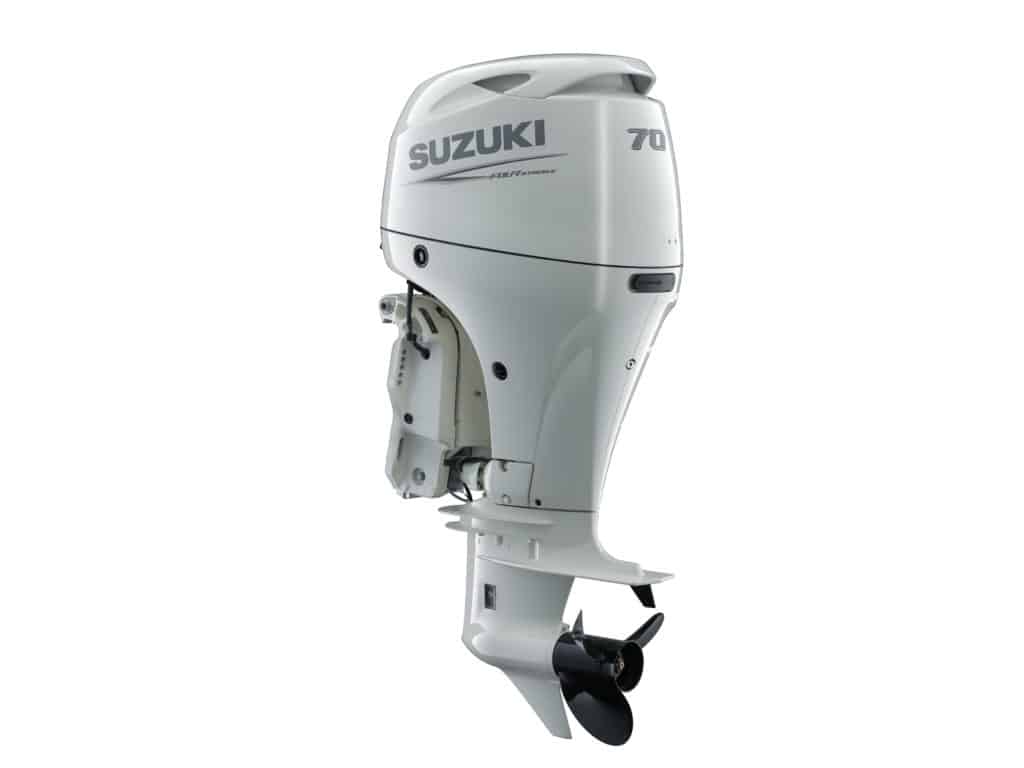
Suzuki DF70A
Known for delivering strong fuel efficiency and long-run reliability, Suzuki’s DF70A pushed a 17-foot Hell’s Bay flats skiff to victory in the 2021 Florida Skiff Challenge, a non-stop, 1,300-mile race around the entire Florida coastline. This four-cylinder engine features dual overhead cams, four-valves-per-cylinder and electronic fuel injection with Suzuki’s Lean Burn Control. Weighing 343 pounds and boasting 9.17 liters of displacement, it’s the only motor in the class with an offset driveshaft for better weight distribution and balance on the transom. Suzuki’s two-stage gear reduction and 2.59:1 gear ratio delivers snappy acceleration and top-end performance. This motor also features a self-adjusting and self-lubricating timing chain and powerful 27-amp alternator for tech-laden boats.
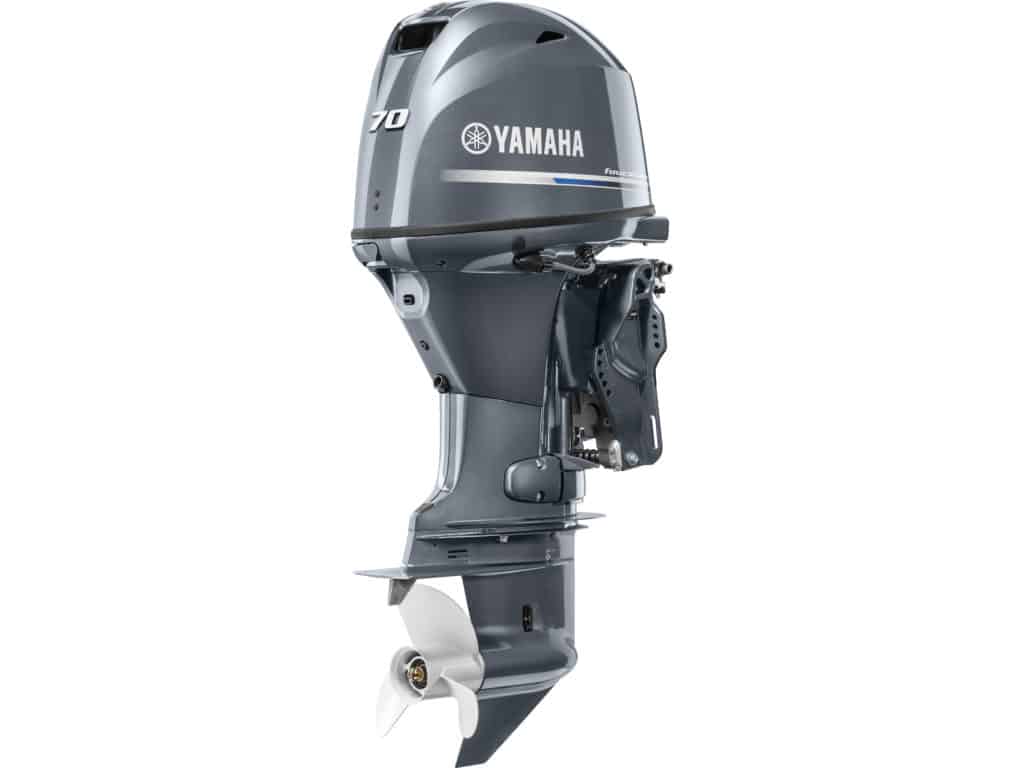
Yamaha Outboards F70
Yamaha’s F70 outboard motor is perfect for family fishing and fun. Weighing 253 pounds, it’s the lightest in class and delivers quick starts, high performance and efficiency for aluminum fishing boats, pontoons and fiberglass boats. This 1.0-liter engine also boasts the best horsepower-per-liter ratio in its class. It offers four-valve-per-cylinder and single cam design with electronic fuel injection. A high gear-ratio and 6,300 rpm wide-open throttle rating combine with a compact single-throttle valve and long-track induction system for maximum power and thrust. The F70 integrates with Yamaha’s CL5 and CL7 touchscreen displays.Yamaha’s Multi-Function tiller handle is also an option for the F70.
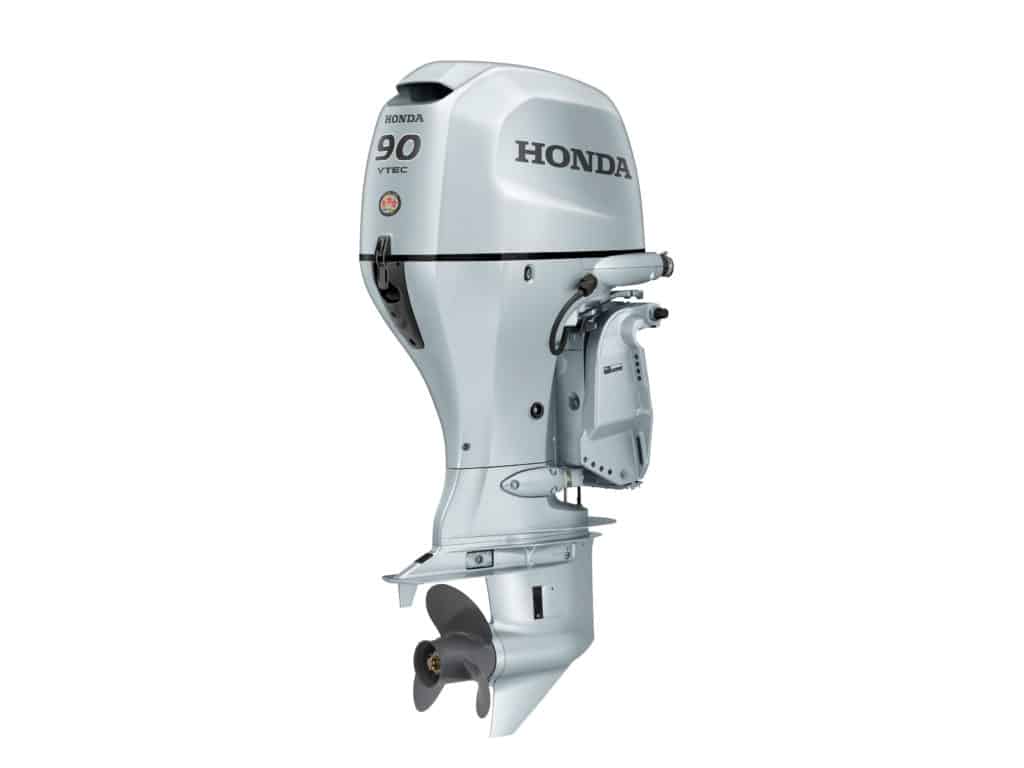
Honda Marine BF90
Inspired by the engine of the Honda Fit car, the BF90′s 1.5-liter, 16-valve four-cylinder features multi-port electronic fuel injection. Weighing 359 pound (20-inch model), it comes with a multi-function display and an optional tiller handle that includes a larger shift lever, a power trim and tilt switch, handle height adjustment and trolling-speed control. The patented Blast system advances ignition timing during hard acceleration for powerful hole shots, while a Lean Burn Control system adjusts the air/fuel mixture to maximize fuel efficiency at cruise. A three-way cooling system promotes long-term durability. Honda’s Variable Valve Timing and Lift Electronic Control (VTEC) improves torque and power at higher rpm.
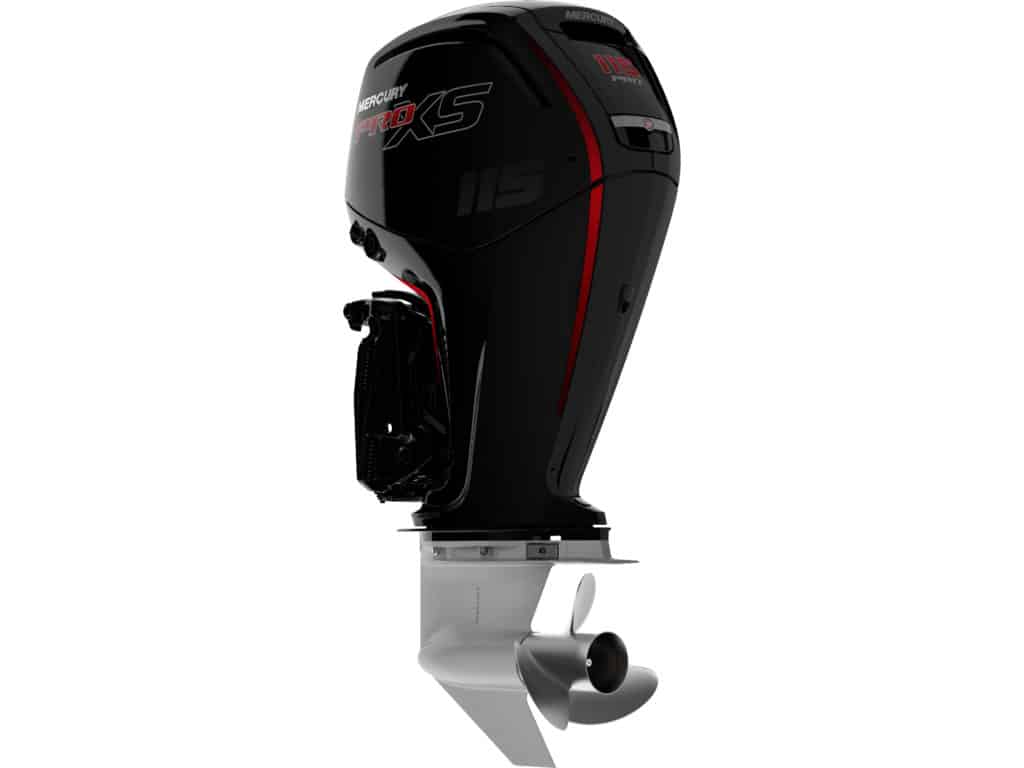
Mercury Marine 115 hp Pro XS
The 115 hp Pro XS has been powering bass boaters and other performance enthusiasts since its launch in 2016. Built on the proven 2.1-liter four-cylinder platform, this outboard motor lives up to the Pro XS reputation for hole shot, top-end speed, and durability. It delivers outstanding zero-to-20 mph heavy-load acceleration and a blistering top speed. At 359 pounds, it’s the lightest weight high-output engine in its class. In addition, the 115 hp Pro XS features the Idle-Charge Battery Management system, ensuring peace of mind for a full day on the water. Available with the standard or larger Command Thrust gearcase, this outboard motor is perfect for boaters looking to maximize performance on their bass boats, multi-species boats, bay boats and pontoons.
Big Outboard Motors
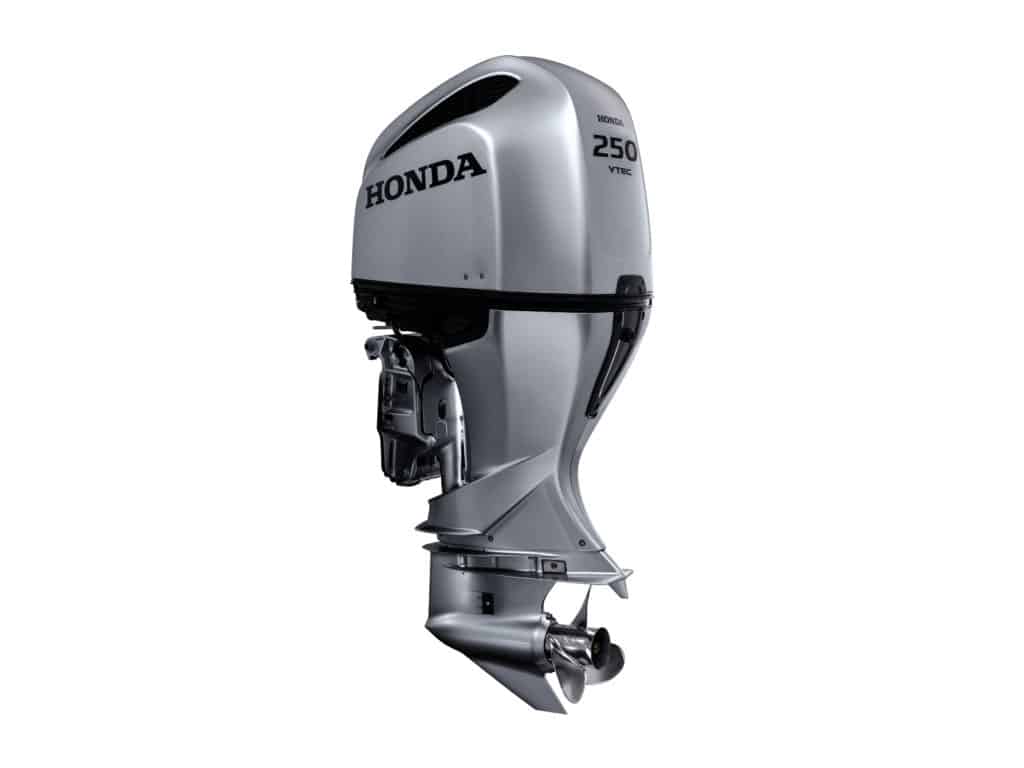
Honda Marine BF250
The flagship of the Honda outboard line, the BF250 outboard motor integrates an innovative design, a sleek progressive V-form style, improved corrosion resistance, streamlined maintenance, and an expanded number of rigging options. Weighing 622 pounds (25-inch model), the 3.58-liter V-6 is available with either Intelligent Shift and Throttle (iST) or electronic controls or mechanical controls. Technological innovations include Variable Valve Timing and Lift Electronic Control (VTEC), Programmed Fuel Injection (PGM-FI) to delivers precise amounts of fuel and air to each cylinder, Boosted Low Speed Torque (BLAST) to increase performance and acceleration; and Lean Burn Control to maximize fuel efficiency in cruise mode. The motor also features digital line redundancy for added protection against connection failure.
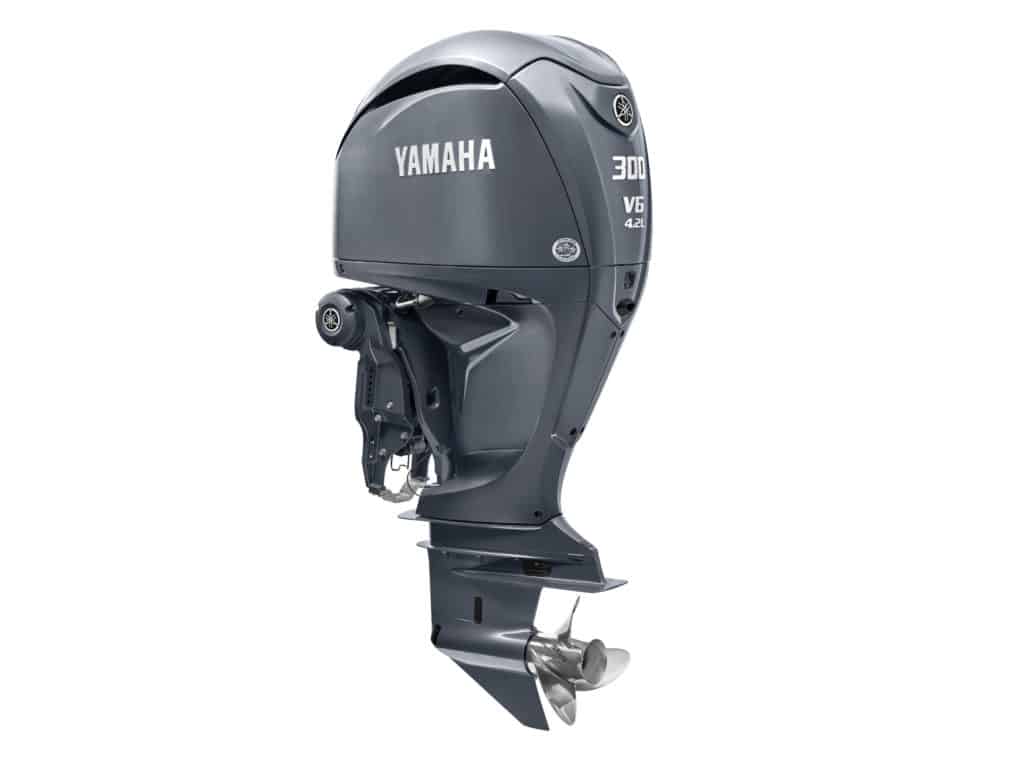
Yamaha Outboards F300 Offshore
Yamaha’s updated F300 Offshore Digital Electronic Control (DEC) model features Digital Electric Steering (DES) and Thrust Enhancing Reverse Exhaust (TERE) and other XTO Offshore-inspired features. Fast and precise Digital Electric Steering (DES) draws battery amperage only when active. The 4.2-liter EFI V-6 incorporates Thrust Enhancing Reverse Exhaust (TERE) that allows the propeller to bite clean water for strong reverse thrust. Yamaha’s TotalTilt function allows complete tilt up from any position with a double push of the “UP” button, or full tilt down with a double push of the “down” button. Weighing 562 pounds (25-inch model), F300 has a color-matched lower unit, an upgraded one-piece top cowling with water-draining air duct molding and a new bottom cowling.
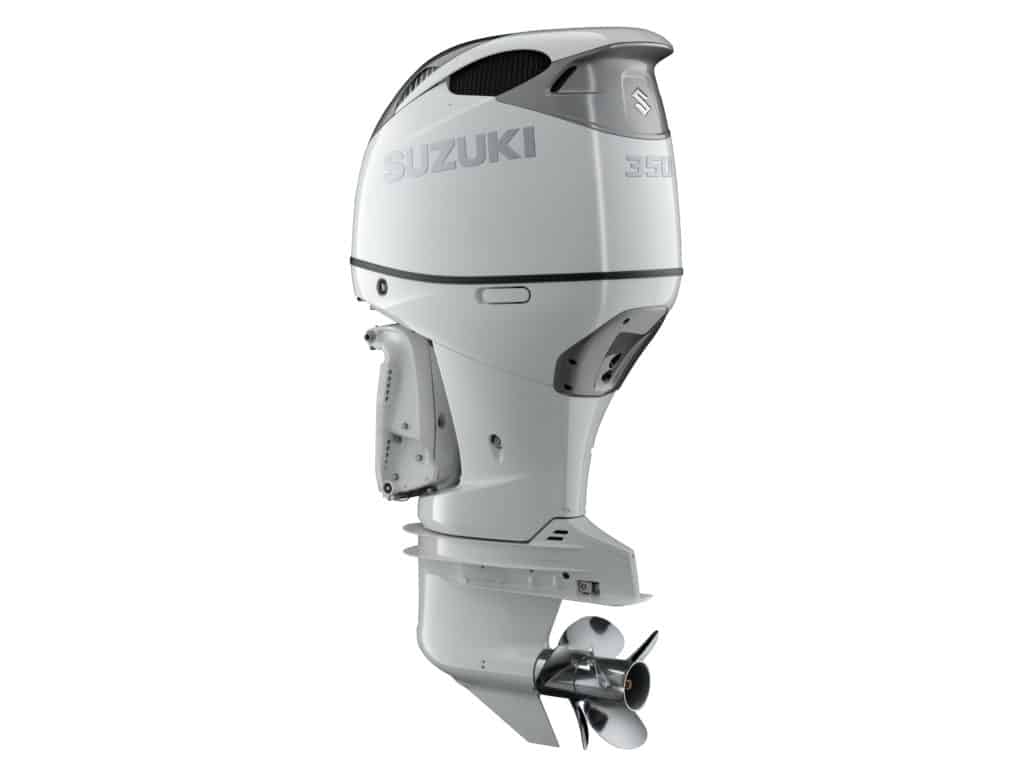
Suzuki Marine DF350A
Suzuki’s flagship DF350A was the first outboard to feature dual contra-rotating propellers for superior hole shot and strong acceleration for today’s larger and heavier boats. It also improves top-end speed and enhances low-speed maneuvering. Weighing 727 pounds (25-inch model), this 4.4-liter V-6 features dual fuel injectors for better power output and fuel efficiency, a self-adjusting oil-bathed timing chain with Variable Valve Timing for performance and durability, a dual-louver direct air intake to provide cooler, denser air for more powerful combustion, and Suzuki’s Lean Burn Control technology for optimum efficiency. The drive-by-wire Suzuki Precision Control system delivers silky smooth shifting and instant throttle response, along with a wide range of advanced features for anglers and boaters.
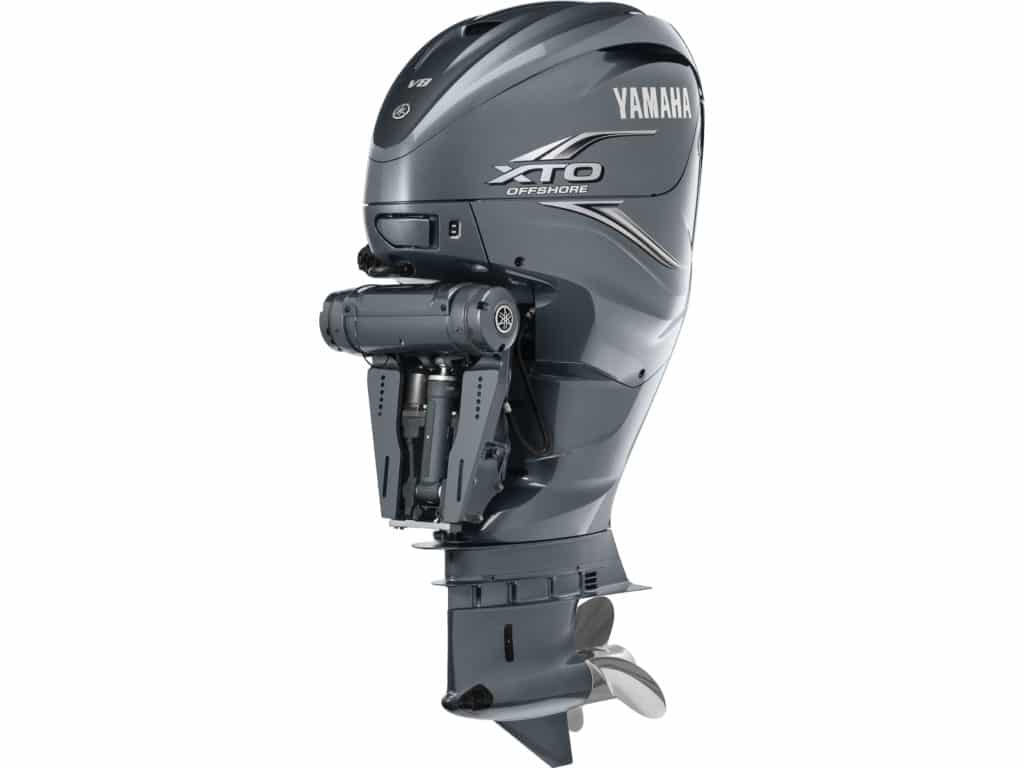
Yamaha Outboards XTO Offshore
The 425 hp XTO Offshore 5.6-liter V-8 outboard motor combines power, reliability, system integration, control and convenience. The first four-stroke outboard to use direct fuel injection, the XTO Offshore sprays fuel at high pressure directly into the combustion chamber, rather than the intake track, improving atomization and increasing fuel burn effectiveness to maximize power and efficiency. Weighing 952 pounds (25-inch model), this outboard motor also features integrated electric steering, eliminating hydraulic lines, fluid and linkages. It allows for clean rigging and an orderly bilge. The XTO provides up to 96 amps (net) at idle and reaches peak output around 1,500 rpm. It is compatible with Yamaha’s Helm Master joystick control system.
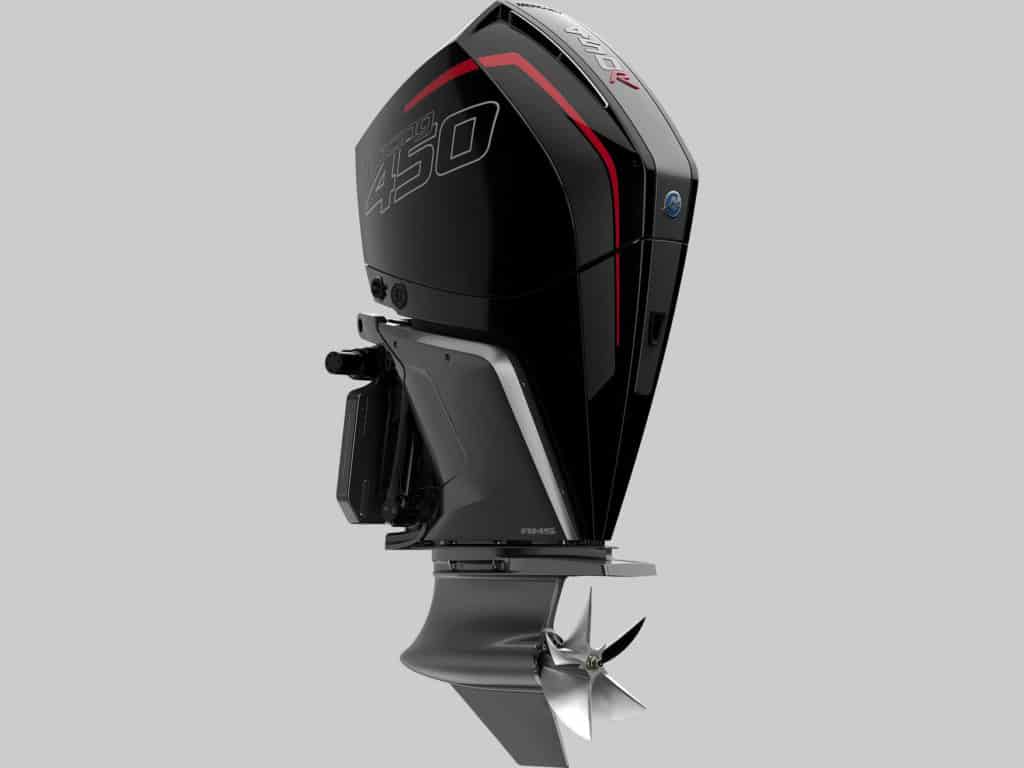
Mercury Racing 450R
The hand-craft 450R has elevated the definition of outboard motor performance. Boosted by an exclusive supercharger, the 4.6-liter V-8 FourStroke powerhead delivers 450 peak horsepower—40 percent more torque than the powerful 400R. Weighing 689 pounds, it is 300 pounds lighter than the nearest competitor. The exclusive Mercury Racing Advanced Mid Section (AMS) features heavy-duty stainless-steel guide plates and stiffened engine mounts that stabilize the outboard and enhance high-speed handling. An optional rear tie-bar bracket integral to the AMS provides a strong, ultra-light mounting point and uncluttered installation for catamaran and other high-speed applications. The 450R outboard is backed by a three-year limited factory warranty and a three-year limited corrosion warranty, the same as Mercury mainline outboards.
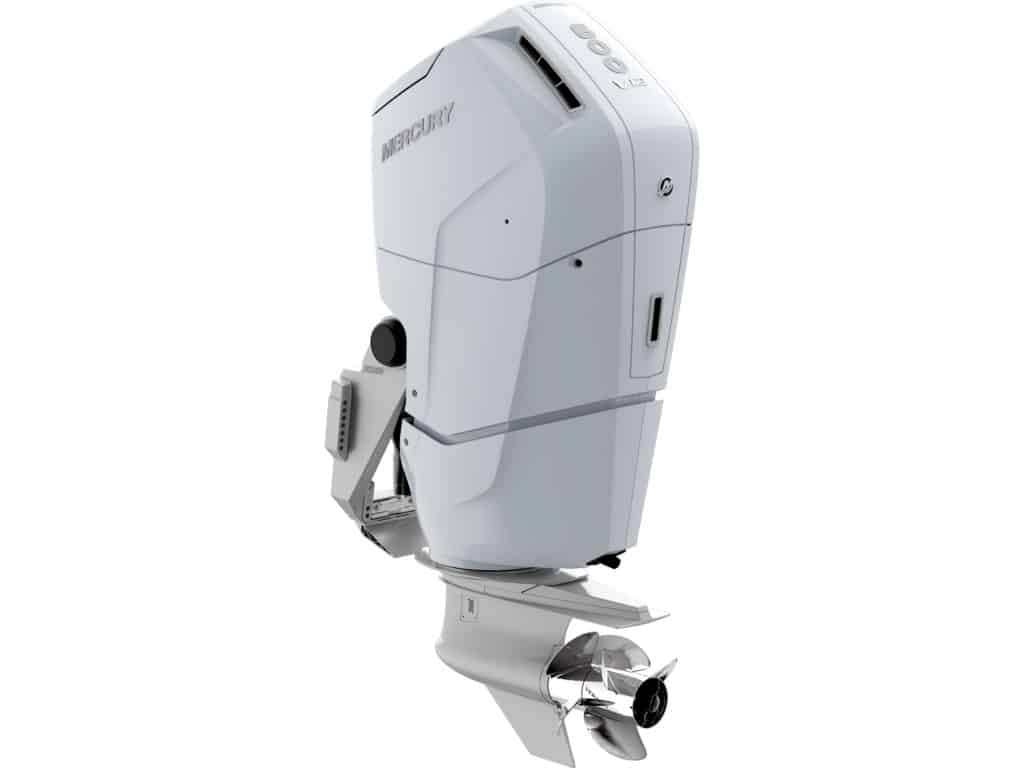
Mercury Marine V12 Verado
The new V12 Verado is in a class of its own, providing the ultimate boating experience for customers. Incorporating industry-first innovations, the 600 hp Verado includes a two-speed transmission, steerable gearcase, and 7.6-liter V-12 powerhead that differentiate it from any other outboard motor. Weighing 1,260 pounds, the V12 is Mercury’s quietest high horsepower engine ever built. Contra-rotating propellers maximize thrust and ease low-speed maneuvering. Maintenance has also been simplified—service intervals have been extended and all regular maintenance points are accessible via the top cowl service hood, meaning the top cowl does not need to be removed for 1,000 hours or five years. It is not an exaggeration to say that the Mercury V12 Verado establishes a new benchmark for marine propulsion.
- More: Boats , Engines , honda marine , mercury marine , outboards , suzuki marine , Yamaha
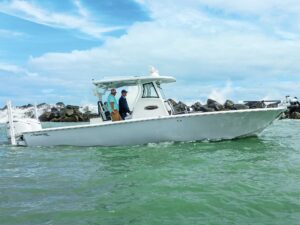
Boat Test: 2024 Tidewater 3100 Carolina Bay
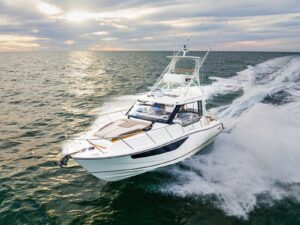
Boating On Board: Boston Whaler 365 Conquest
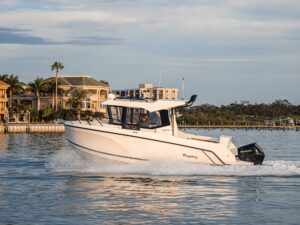
Boat Test: 2024 Bayliner Trophy T23 Pilothouse
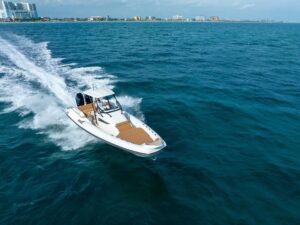
Boat Test: 2024 Nuova Jolly Prince 33 CC
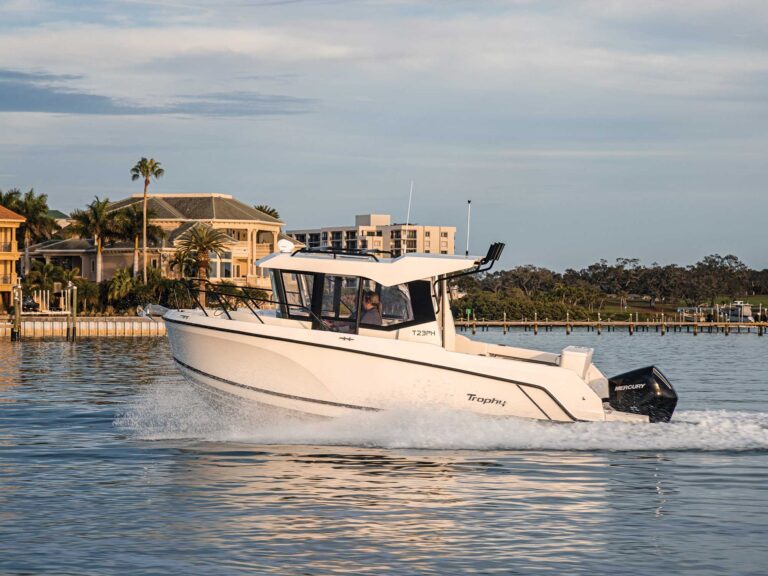
What to Do if Your Boat’s Engine Dies
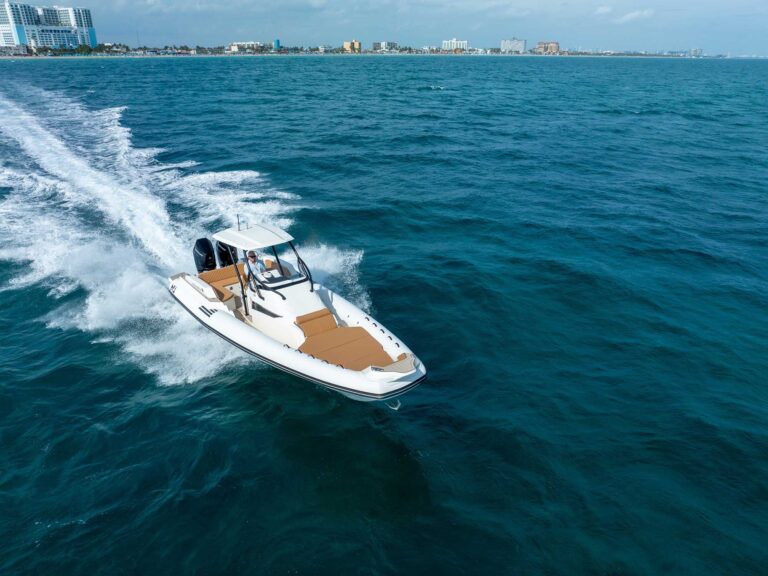
ProTournament Elite Gen 3 Chargers

- Digital Edition
- Customer Service
- Privacy Policy
- Cruising World
- Sailing World
- Salt Water Sportsman
- Sport Fishing
- Wakeboarding
Many products featured on this site were editorially chosen. Boating may receive financial compensation for products purchased through this site.
Copyright © 2024 Boating Firecrown . All rights reserved. Reproduction in whole or in part without permission is prohibited.
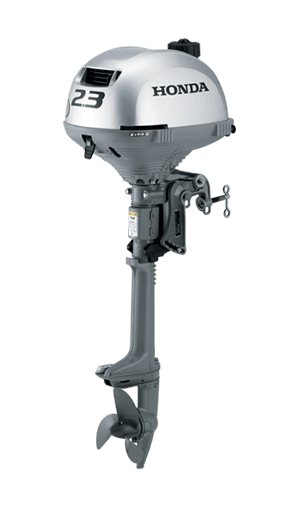
- Find a Dealer

BF75-90-100
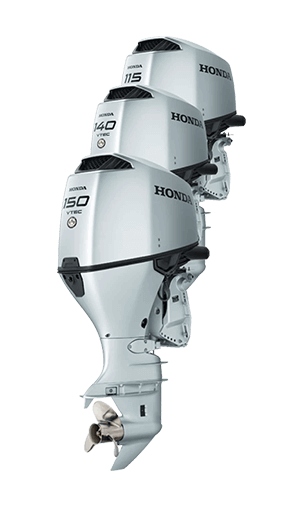
BF115-140-150
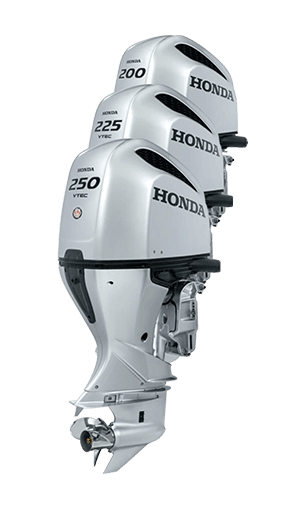
BF200-225-250
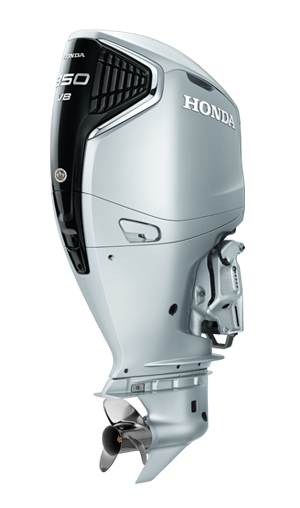

Please verify you are a human
Access to this page has been denied because we believe you are using automation tools to browse the website.
This may happen as a result of the following:
- Javascript is disabled or blocked by an extension (ad blockers for example)
- Your browser does not support cookies
Please make sure that Javascript and cookies are enabled on your browser and that you are not blocking them from loading.
Reference ID: 07a39876-eb73-11ee-8b69-1db89f6f2f8b
Powered by PerimeterX , Inc.

WORLD CLASS DAVIT SYSTEMS
1 800 883 2848.
MD 10 & 20 Motor Lifts for Sailboats and Powerboats
This all-stainless davit system was specifically engineered for newer powerboats with integrated swim platforms, where the transom is too far forward for a conventional davit system, but it will also work well on boats with transoms with more traditional designs.
MD 10 Motor Lift
Rated for up to 100 lbs with 4:1 tackle.
Manufactured from the best quality 1¼" x .065" marine stainless tubing.
Fittings and fasteners are of high quality stainless steel.
MD series hoists use DELRIN® plastic rail bushings to eliminate chafe and corrosion at mounting points.
Optional equipment includes our outboard motor harness - made with U/V resistant mil. spec. webbing and all stainless fasteners and fittings.

MD 20 Motor Lift
Rated for up to 225 lbs with 6:1 tackle.
MD-20 is manufactured from the best quality 1¼" x .120" marine stainless tubing.
MS1 Outboard Motor Harness
Our outboard motor strap has all stainless fittings and wraps around the motor twice! The motor can never slip out of our sling!

RA10-MD Motor Hoist Kit
Outboard sling made from heavy-duty belt webbing with stainless fittings.
The ideal add on for our Radar Tower and Atenna mount.
Goes perfectly with our Outboard Motor Harness .
Manufactured from best quality 1-1/4 x .065 marine stainless tubing.
All stainless fittings and fasteners.
Precision welded using state-of-the-art processes and fully polished.
UHMW plastic rail bushings eliminate chafe and corrosion at mounting points.

CD-175 Cargo Hoist for Sailboats and Powerboats
Rated for up to 175 lbs. with 6:1 tackle.
$695.00 USD
Manufactured from best quality 1-1/4 x 11ga. (.120" wall) marine stainless tubing.
3/8" yacht braid tackle with sufficient rope for 12' lift.
Disassembles into three easy-to-store sections.

Storage Bag for CD-175


IMAGES
VIDEO
COMMENTS
To get the right amount of horsepower needed to efficiently propel a sailboat, divide the displacement of the boat (in lb) by 550. You need approximately 1 HP per 550 lb of displacement or 4 HP per 2200 lb. Most sailboats don't need a motor with more than 30 HP. In this article, I'm talking about small outboard engines for sailboats.
4-18 HP for boats between 20-30' (approximately 2,000-10,000lbs) 18-34 HP for boats between 30-40' (10,000lbs or more) There are some things to consider when deciding how much horsepower you need or want. Location and the type of conditions you expect you'll be sailing in is one of the biggest factors.
Choosing a lightweight, 10 hp or under outboard motor is a dependable choice for your sailboat. Consider weight and decide between a two or four-stroke engine motor. Purchase your new outboard from OnlineOutboards.com, an authorized dealer of the world's top four-stroke outboard motor brands.
Honda for example offers 20 and 25-inch transom height (long or short shaft) right down to their smallest BF2 (two-horsepower) model. Mercury and Mariner only offer a 15-inch short-shaft version ...
35 feet 7.9 knots (9.1mph) With an electric outboard motor, or any kind of auxiliary motor, boat speed depends on the hull type, waterline length, and total displacement weight (including passengers, food, and baggage), as well as the motor thrust. Speed factors also include the waves, current, and wind, relative to your heading.
Loving it!". #2. Navy Series Outboard Motor. The Navy Series electric outboard motor includes the 6 HP and 9.9 HP model for your selection, both coming with a long shaft at 24.6" (62.5 cm) and a shorter shaft at 29.5" (75 cm). The long shaft electric outboard motor provides efficient and clean power for your best experience on the boat.
This site is focused on electric outboard motors for sailboats up to 27ft, and up to 5,000 lb. displacement. Which motor for my boat? How much power do I need As previously discussed, boat speed is directly affected by boat hull design, displacement weight, wind, waves, and boat motor power. When it comes to motor power, diesel and gas-powered ...
A sensible weight of outboard for one person to carry is no more than 65lb, which equates to a 4/6hp single-cylinder model. Perhaps you can tote an 8/10hp (85lb) two-cylinder motor if you're young, fit and strong. But be warned: these kinds of larger engines are tough to get on and off the mothership without a tackle.
2) ePropulsion Navy 6.0. If you are looking for something longer lasting than and more powerful than the Spirit 1.0 Plus, ePropulsion also offers the more powerful Navy 6.0. The Navy 6.0 is equivalent to a 10Hp engine, so it won't struggle to move a relatively big boat. The range on the Navy 6.0 is impressive.
Motor weight: 10.5kg. Battery weight: 9kg. Battery capacity: 1276Wh. Top speed RIB: 4.5mph. Top speed skiff: 6.0mph. Thrust: 31kg/68lbs. The Chinese firm ePropulsion has been developing its electric outboard motor range and lithium batteries for some time. We tested the Spirit 1.0 Plus and Evo, both 1kW motors with integral batteries.
Sounds good. But the truth is high-octane fuel — usually 92 or 93 octane — is a waste of money for the majority of outboards. Most are built to run happily on 87 octane. Some manufacturers — such as Tohatsu — do recommend midrange fuel, usually 89 octane. Check your owner's manual, and fuel up with what it prescribes.
Step 1: Rotate the clamps or use the screws to fix the outboard onto the sailboat. Step 2: Mount the steering system in the proper position. Step 3: Install the tiller on the electric sailboat motor. Step 4: Connect the batteries to the electric sailboat motor system.
2024 Tohatsu 6 HP MFS6DWSPROL SailPro Outboard. $ 1,689.00. Horsepower: 6. Shaft Length: Sail Pro 20 " (25″ ultra-long shaft available) Starter Type: Manual. Tilt & Trim: Manual. Fuel Tank: External 3.1 gallon. Tohatsu 6hp Sail Pro Outboard designed specifically for sail boaters. This powerful sailboat engine, equipped with a 20″ long ...
An outboard motor in this range is an excellent option for propelling a boat carrying a light load and two people at 9.5 to 17.5 mph (15 - 28 km/h). 15 to 25 HP engine Although powerful, these 16.5 to 23.5 pounds (36 - 52 kg) heavy 4-stroke outboard engines are still in a small outboard HP class.
The introduction of diesel outboard engines has also made news in recent years. Other outboard diesel motors have come and gone, but in 2019 Cox introduced the largest yet produced, the CXO300. The Cox diesel was designed from the ground-up (previous diesel outboards were adapted from existing diesel powerheads designed for other purposes) to be an outboard incorporating common-rail technology.
It is a small, simple, 15 horsepower engine you can find what you want on First Class Outboards. Buy Sailboat Outboard Motors online at the best price. View: 16. 32. All. -5% Add to cart. Add to Wishlist. 9.9 HP, Best Selling, Fishing Boat Engines, Jon Boat Motors, Kicker Outboard Motors, Mercury, Mercury 9.9 HP, Sailboat Motors.
Weight: 27.1kg Power: 750W / 1hp Battery: 1kWh Range: 34nm Price: $1,500. Announced in early 2022 and launched less than a year later, the Mercury Avator 7.5e is the first electric unit from the world's biggest builder of outboard engines.. The whole top plate hinges up to reveal the battery, which can be quickly removed from your electric boat or replaced for convenient charging.
The Mercury 9.9 outboard engine is the right choice for sailboat and kicker applications. The 9.9 HP Mercury Outboard Motor model: 9.9MXLH is an affordable outboard, equipped with an extra long 25 inch shaft and manual start, Mercury's 3 year factory warranty, and auto ratchet trim and multi function tiller control. We are an authorized Mercury Dealer with Free Shipping and Discounted Prices.
Yamaha's F70 outboard motor is perfect for family fishing and fun. Weighing 253 pounds, it's the lightest in class and delivers quick starts, high performance and efficiency for aluminum fishing boats, pontoons and fiberglass boats. This 1.0-liter engine also boasts the best horsepower-per-liter ratio in its class.
Honda Marine offers a full line of dependable 4-stroke outboard motors. Find the right boat engine for you. Portable, Mid-range, and Large Motors from 2 to 250 hp. Honda Powersports Power ... Outboard Motors Outboard Motors. 2 - 20 hp — Portable; 25 - 100 hp — Mid Range; 115 - 350 hp — High Power; Jet Drive; Brochures; Performance Tests;
Choices include outboard motor brackets designed to mount a small outboard to the stern of a boat. Brackets are also offered for installation on the railing of boats for space-saving outboard storage. Motor carriers in the form of harnesses or slings enable easy motor transport. Wheeled outboard motor carriers make transporting larger outboards ...
Motor Lift Systems for Sailboats and Powerboats. Motor Lift Systems for Sailboats and Powerboats. top of page. WORLD CLASS DAVIT SYSTEMS. 1 800 883 2848. ... Our outboard motor strap has all stainless fittings and wraps around the motor twice! The motor can never slip out of our sling! $75.00 USD .
No other outboard goes from zero to wide-open throttle as fast as a Mercury Pro XS® engine. Learn More SeaPro™ Commercial Outboards ... Compare All Outboard Motors. 1 - 12 of 20 results in Outboard. Verado 600hp. 7.6L V12. Verado 350-400hp. 5.7L V10. Verado 250-300 hp. 4.6L V8. SeaPro 500hp. 7.6L V12. SeaPro 75-150hp. Inline 4.
If you purchase an outboard motor as a single unit, the casual excise tax is calculated at 5% with a $500.00 cap. The casual excise tax rate has not changed for a watercraft or watercraft/outboard motor purchased as a unit. The casual excise tax rate for a watercraft or watercraft and outboard motor purchased as a unit is 5% with a $500.00 cap.